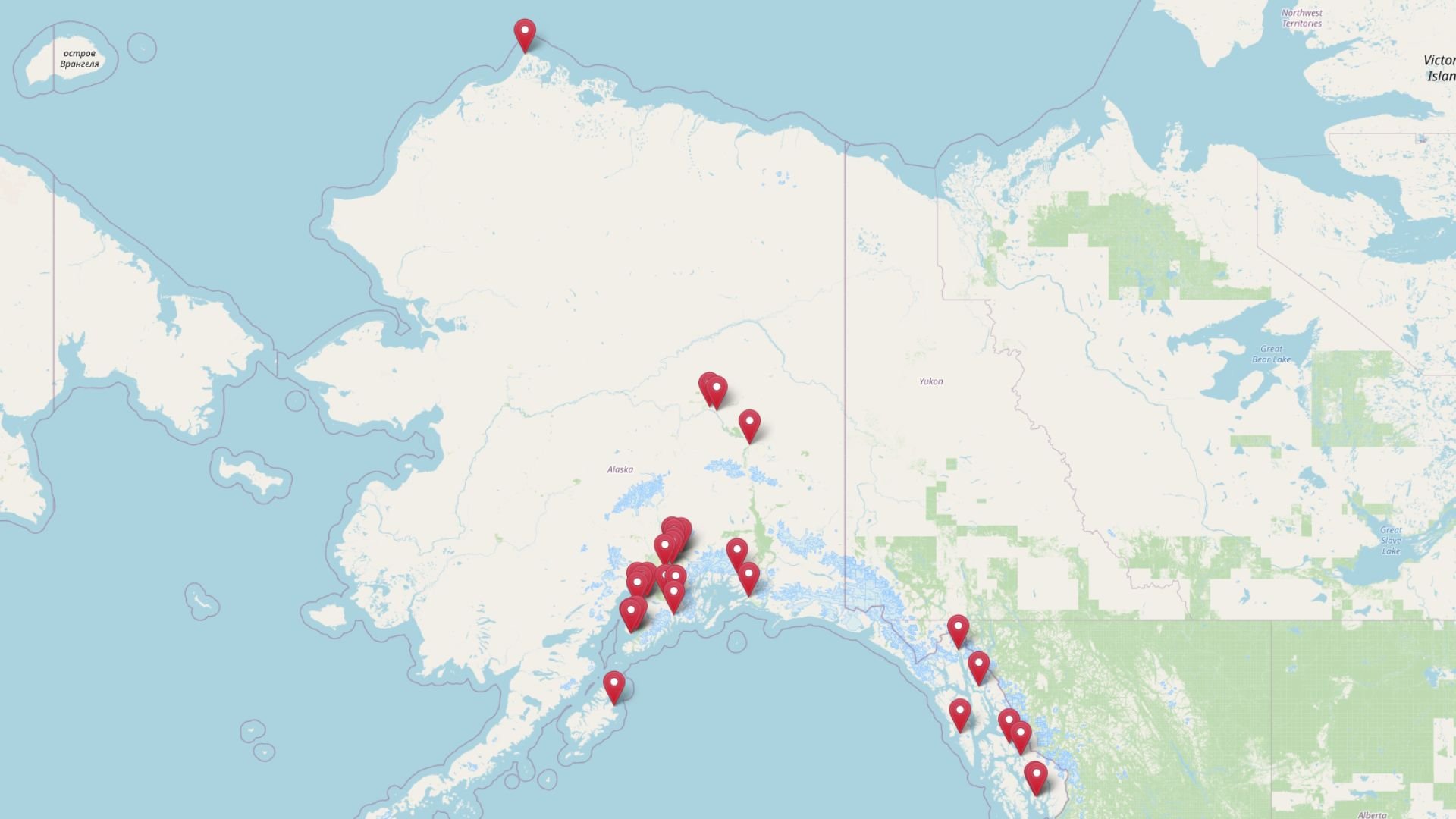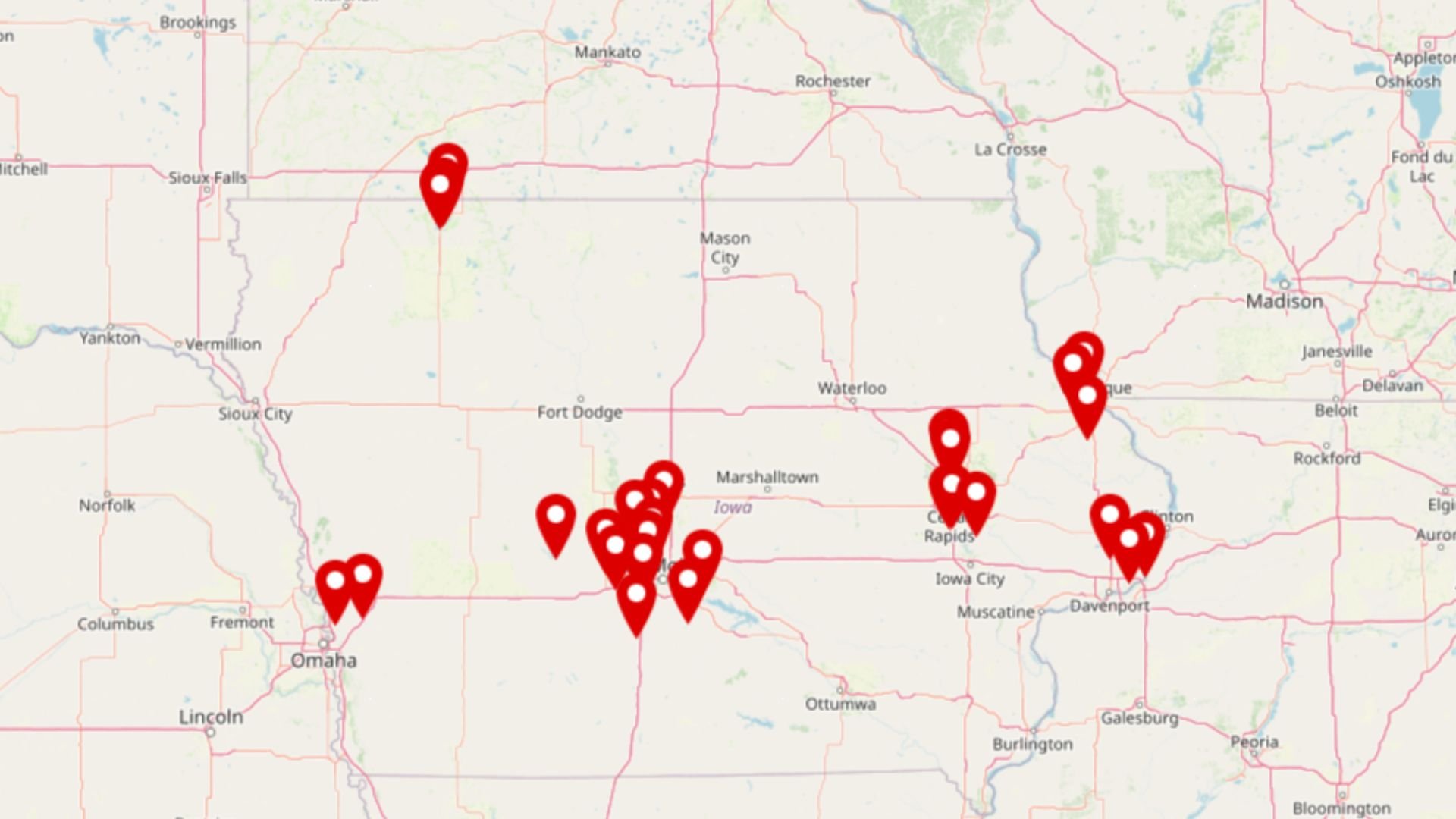
Using the latest Zillow Home Value Index data from 2025, we’ve ranked the 30 most expensive towns in Iowa based on current home prices. These communities represent remarkable growth stories, with some experiencing price increases of over 240% since 2010.
From lakefront retreats around the Okoboji area to suburban enclaves near Des Moines, each town tells a unique story of desirability and investment appeal. The data reveals striking patterns of growth, particularly in recreational areas and communities with strong schools or convenient commuter access.
30. Underwood – 91% Home Price Increase Since 2010
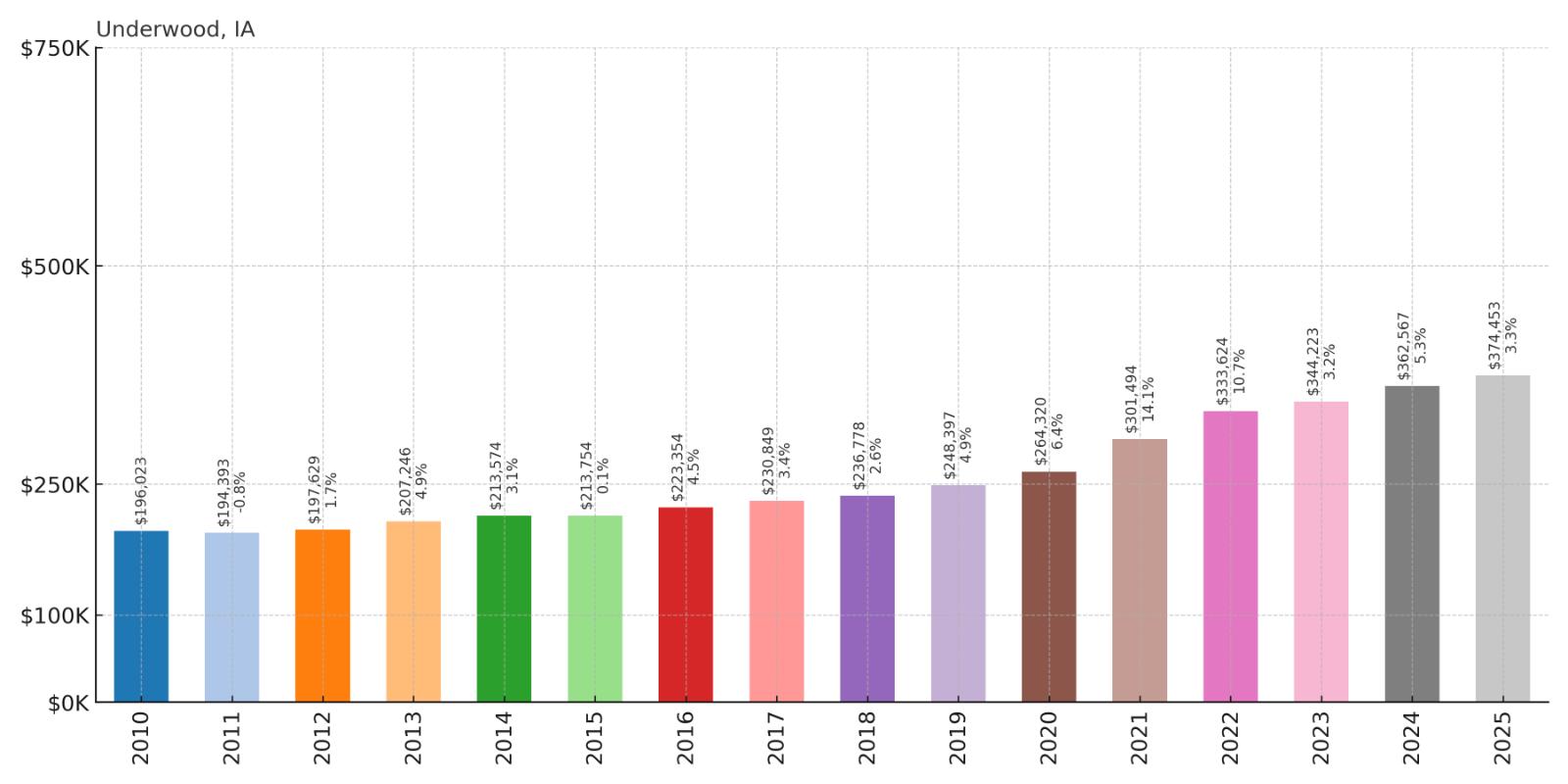
- 2010: $196,023
- 2011: $194,393
- 2012: $197,629
- 2013: $207,246
- 2014: $213,574
- 2015: $213,754
- 2016: $223,354
- 2017: $230,849
- 2018: $236,778
- 2019: $248,397
- 2020: $264,320
- 2021: $301,494
- 2022: $333,624
- 2023: $344,223
- 2024: $362,567
- 2025: $374,453
Underwood has shown steady appreciation over the past 15 years, with homes nearly doubling in value. The most dramatic growth occurred during the pandemic years of 2020-2022, when values jumped from $264,320 to $333,624. Current median home prices of $374,453 reflect strong demand in this western Iowa community.
Why Underwood?
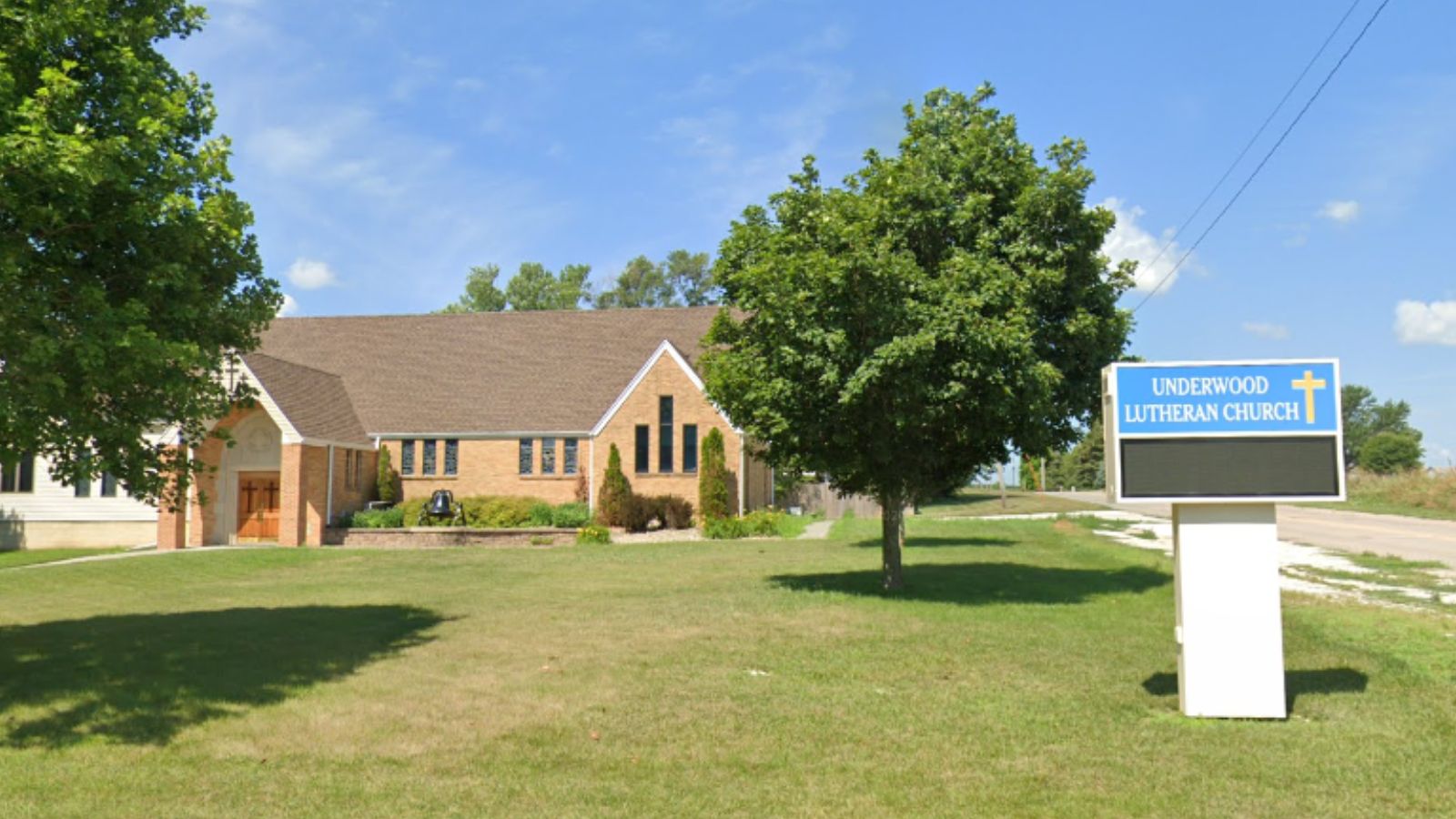
Why are people willing to pay so much to live here? What’s special about it?
Underwood attracts families seeking small-town charm with reasonable access to Omaha’s job market across the Missouri River. The community offers excellent schools through the Underwood Community School District, known for strong academic performance and tight-knit community involvement. Rural roads provide space for larger lots and custom homes while maintaining a genuine neighborhood feel.
The area’s agricultural heritage blends seamlessly with modern suburban amenities, creating an appealing balance for professionals who want countryside living without complete isolation. Low crime rates and community events like the annual Underwood Fun Days help maintain the town’s family-friendly reputation that drives consistent housing demand.
How Underwood Rose to Prominence
Founded in 1882 as a railroad town along the Chicago, Rock Island and Pacific Railroad, Underwood served as a vital shipping point for local agricultural products. The community was named after an early settler family and quickly established itself as a regional hub for grain and livestock trading. Its location in Pottawattamie County placed it within the sphere of Council Bluffs’ growing influence.
As the Omaha-Council Bluffs metropolitan area expanded in the late 20th century, Underwood transformed from a purely agricultural community into a suburban bedroom community. The construction of improved highways made commuting to larger cities more feasible, while the town maintained its rural character and strong school system. This transition attracted young families seeking affordable housing with good schools and low crime rates.
3 Interesting Tidbits
- Railroad Heritage – The original railroad depot still stands as a community landmark, serving as a reminder of the town’s transportation roots that first put it on the map.
- Agricultural Legacy – Despite suburban growth, Underwood maintains active farming operations within its borders, creating a unique blend of rural and residential land use.
- School Pride – The Underwood Eagles have won multiple state championships in various sports, creating strong community identity and attracting families who value competitive athletics programs.
29. Le Claire – 85% Home Price Increase Since 2010
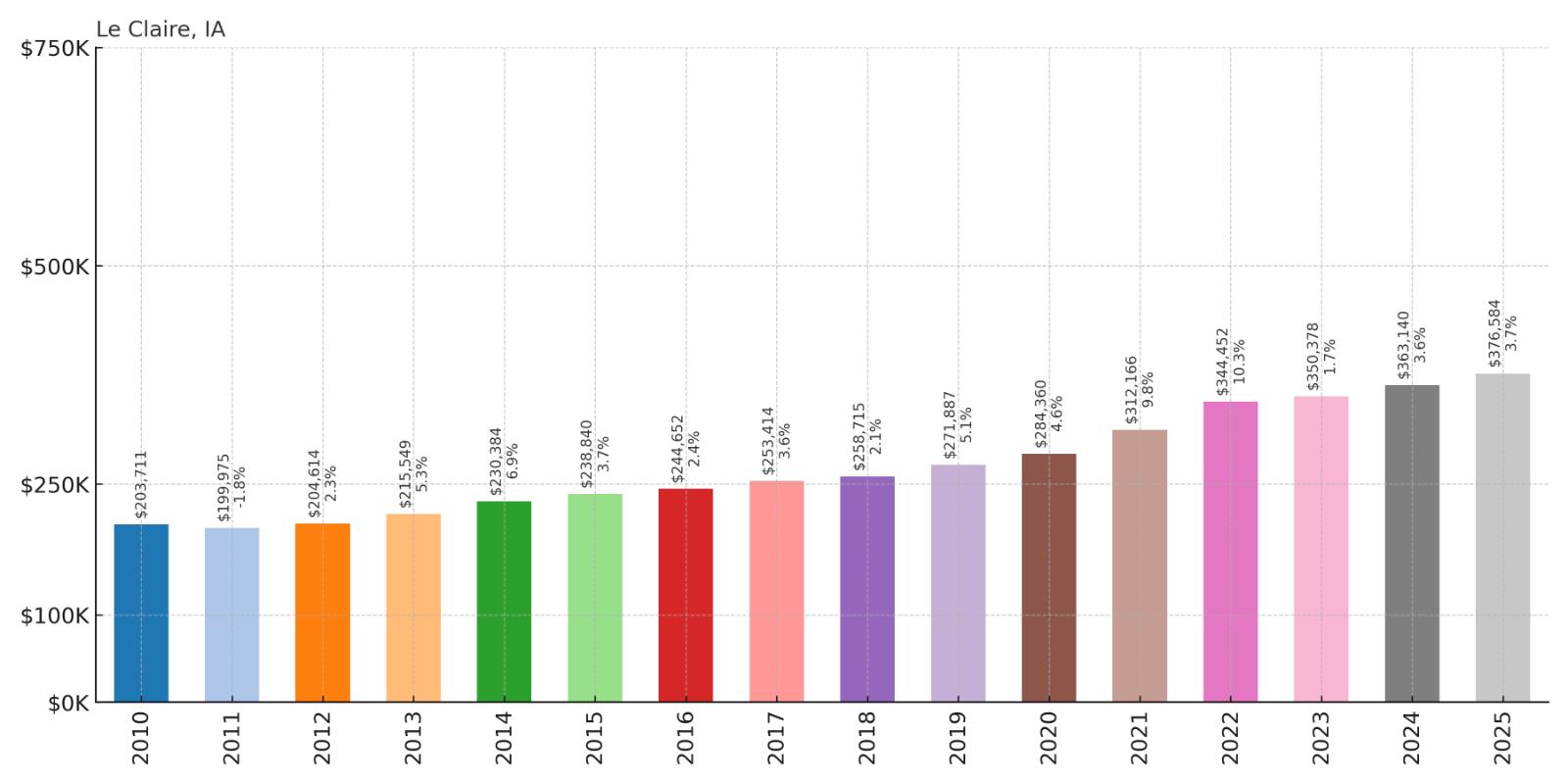
- 2010: $203,711
- 2011: $199,975
- 2012: $204,614
- 2013: $215,549
- 2014: $230,384
- 2015: $238,840
- 2016: $244,652
- 2017: $253,414
- 2018: $258,715
- 2019: $271,887
- 2020: $284,360
- 2021: $312,166
- 2022: $344,452
- 2023: $350,378
- 2024: $363,140
- 2025: $376,584
Le Claire demonstrates consistent appreciation with values climbing from $203,711 in 2010 to $376,584 today. The community experienced its strongest growth during 2014-2015 and again during the 2020-2022 period. This steady upward trajectory reflects the town’s enduring appeal as a Mississippi River community.
Why Le Claire?
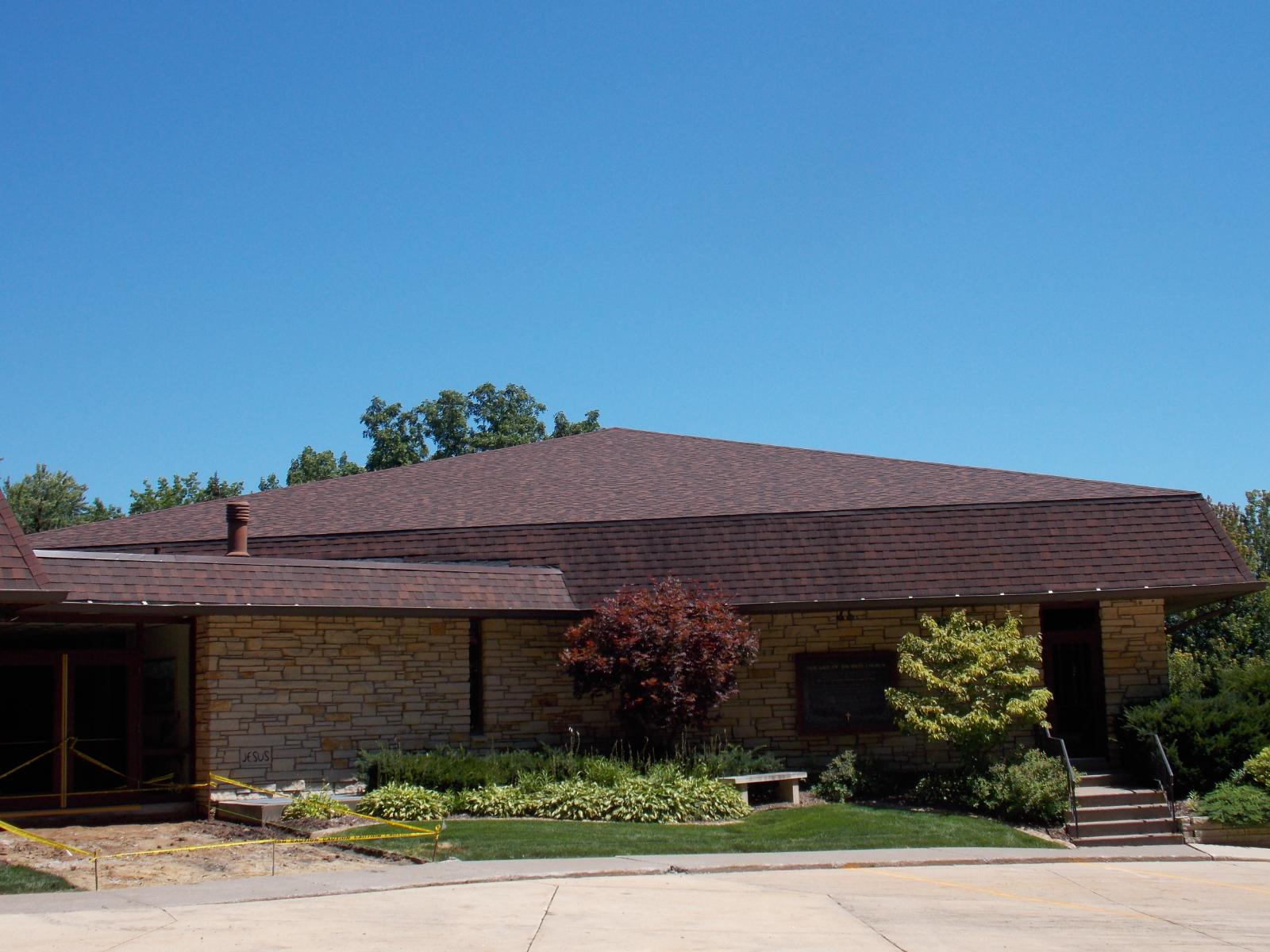
Why are people willing to pay so much to live here? What’s special about it?
Le Claire’s prime location along the Mississippi River offers residents scenic waterfront living with easy access to both Iowa City and the Quad Cities metro area. The historic downtown district features antique shops, restaurants, and riverfront parks that create a charming small-town atmosphere. Many homes offer river views or easy access to boating and water recreation.
The community maintains excellent schools and low crime rates while providing cultural amenities that rival larger cities. Annual events like Tug Fest and the Buffalo Bill Cody Homestead celebration draw visitors year-round, contributing to property values. The blend of history, natural beauty, and modern convenience makes Le Claire particularly attractive to empty nesters and professionals.
How Le Claire Rose to Prominence
Le Claire gained historical significance as the birthplace of Buffalo Bill Cody in 1846, when the town served as a vital Mississippi River port. The community’s location at the head of the Rock Island Rapids made it a natural stopping point for river traffic, leading to its development as a boat-building center. The LeClaire Navigation Company operated from here, constructing steamboats for Mississippi River trade.
The town’s transformation into a desirable residential community began in the mid-20th century as improved transportation connected it to larger metropolitan areas. The preservation of its historic downtown and riverfront, combined with modern amenities and excellent schools, created a unique appeal for homebuyers. Tourism related to Buffalo Bill Cody’s legacy and the scenic river setting further enhanced the community’s reputation and property values.
3 Interesting Tidbits
- Buffalo Bill’s Birthplace – The Buffalo Bill Cody Homestead draws thousands of visitors annually, with the historical significance contributing to the town’s identity and tourism economy.
- Riverboat Heritage – Le Claire was once home to major steamboat construction, with boats built here serving the entire Mississippi River system during the 1800s.
- Tug Fest Champion – The annual Tug Fest rope-pulling competition across the Mississippi River between Le Claire and Port Byron, Illinois, has become a beloved regional tradition since 1987.
28. Asbury – 70% Home Price Increase Since 2010
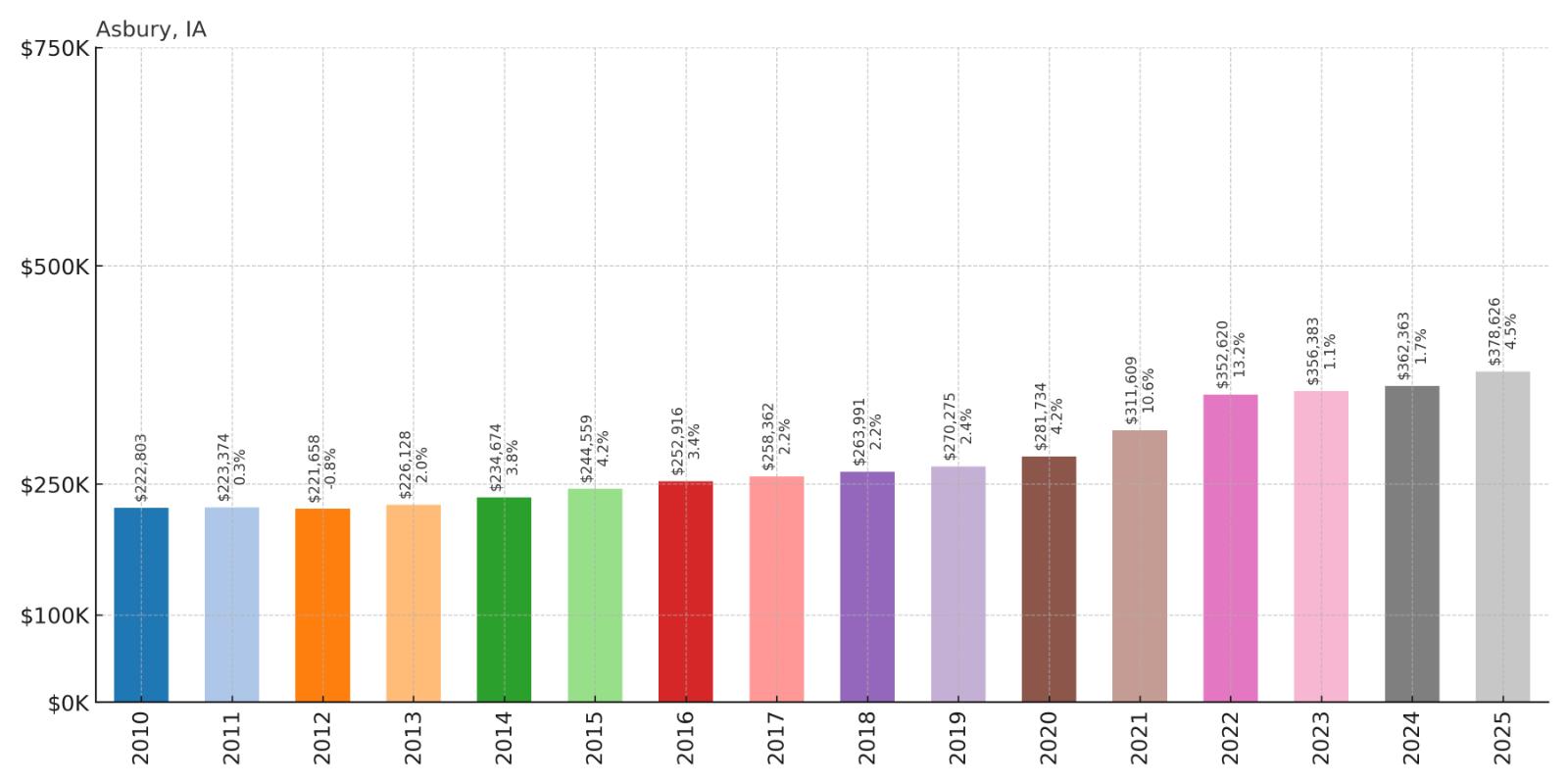
- 2010: $222,803
- 2011: $223,374
- 2012: $221,658
- 2013: $226,128
- 2014: $234,674
- 2015: $244,559
- 2016: $252,916
- 2017: $258,362
- 2018: $263,991
- 2019: $270,275
- 2020: $281,734
- 2021: $311,609
- 2022: $352,620
- 2023: $356,383
- 2024: $362,363
- 2025: $378,626
Asbury has maintained remarkably steady growth over 15 years, starting at $222,803 in 2010 and reaching $378,626 today. Unlike many communities that saw dramatic pandemic-era spikes, Asbury’s growth has been methodical and consistent. The 70% total increase reflects strong fundamentals rather than speculative buying.
Why Asbury?
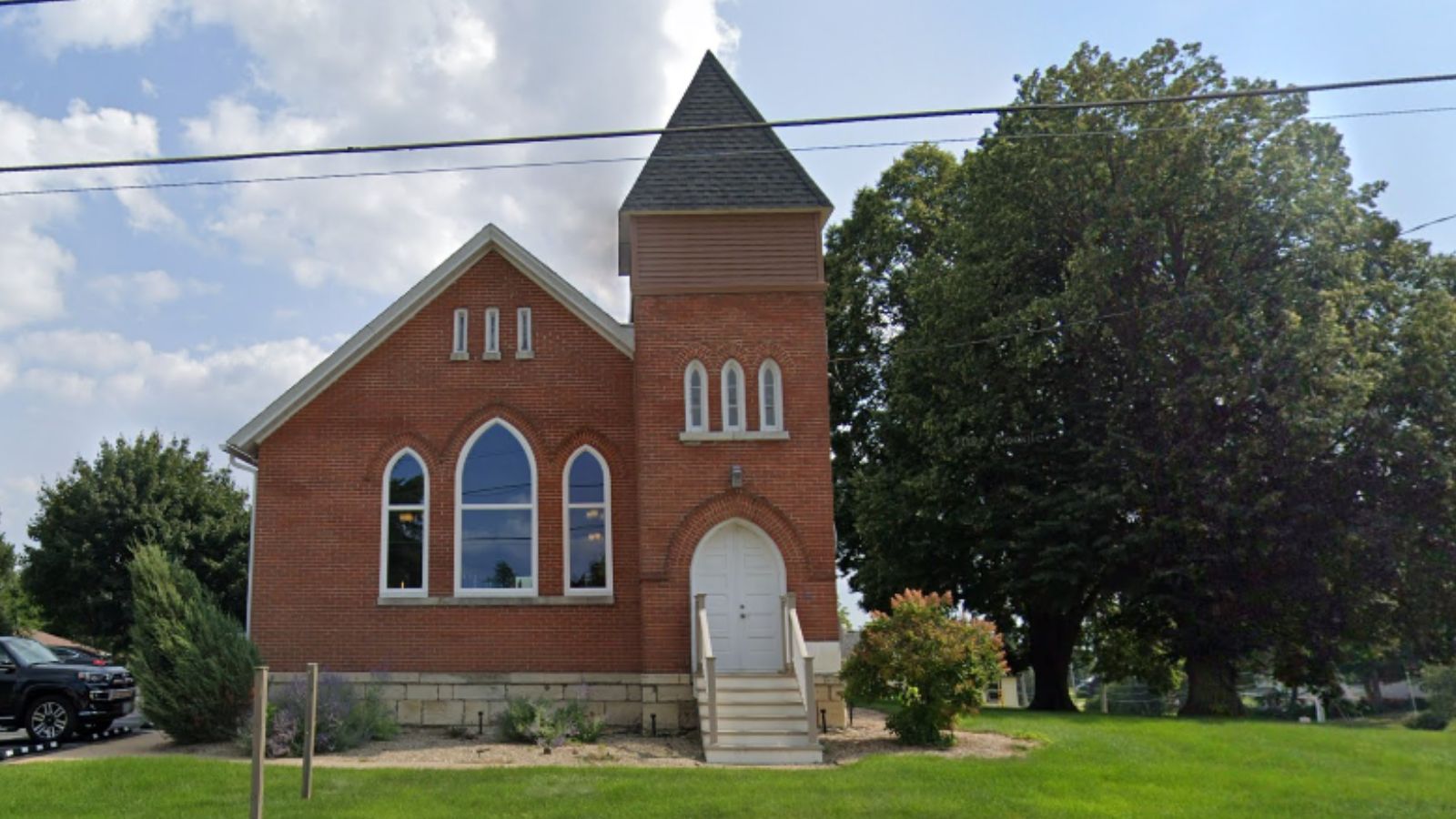
Why are people willing to pay so much to live here? What’s special about it?
Asbury offers the perfect blend of suburban amenities and small-town character within the greater Dubuque metropolitan area. Families are drawn to the excellent Dubuque Community School District and the abundance of parks and recreational facilities. The community features newer subdivisions with modern homes while maintaining easy access to shopping, dining, and entertainment in nearby Dubuque.
The area’s rolling hills and scenic landscapes provide an appealing setting for upscale housing developments. Low crime rates and strong community involvement create a family-friendly environment that appeals to young professionals and empty nesters alike. The location offers the best of both worlds: suburban tranquility with urban convenience just minutes away.
How Asbury Rose to Prominence
Originally part of rural Dubuque County, Asbury developed as a farming community in the mid-1800s, named after Francis Asbury, the first American Methodist bishop. The area remained largely agricultural through most of the 20th century, with scattered farmsteads and rural residences dotting the countryside. The community’s transformation began in earnest during the 1990s as Dubuque’s metropolitan area expanded westward.
Asbury’s incorporation as a city in 1992 marked the beginning of its suburban development boom. Developers recognized the area’s potential, with its scenic topography, proximity to Dubuque, and excellent school district boundaries. The construction of shopping centers, restaurants, and professional services followed residential growth, creating a complete suburban community that attracts families seeking modern amenities with small-town values.
3 Interesting Tidbits
- Methodist Heritage – The community’s name honors Francis Asbury, whose Methodist circuit riders were among the first organized religious influences in early Iowa territory.
- Newest Incorporation – As one of Iowa’s newer incorporated cities (1992), Asbury represents modern suburban planning with wide streets, abundant green space, and family-friendly amenities.
- Shopping Destination – The Asbury Plaza and surrounding commercial development serve not just local residents but draw shoppers from across the tri-state region, contributing to the area’s economic vitality.
27. Riverdale – 75% Home Price Increase Since 2010
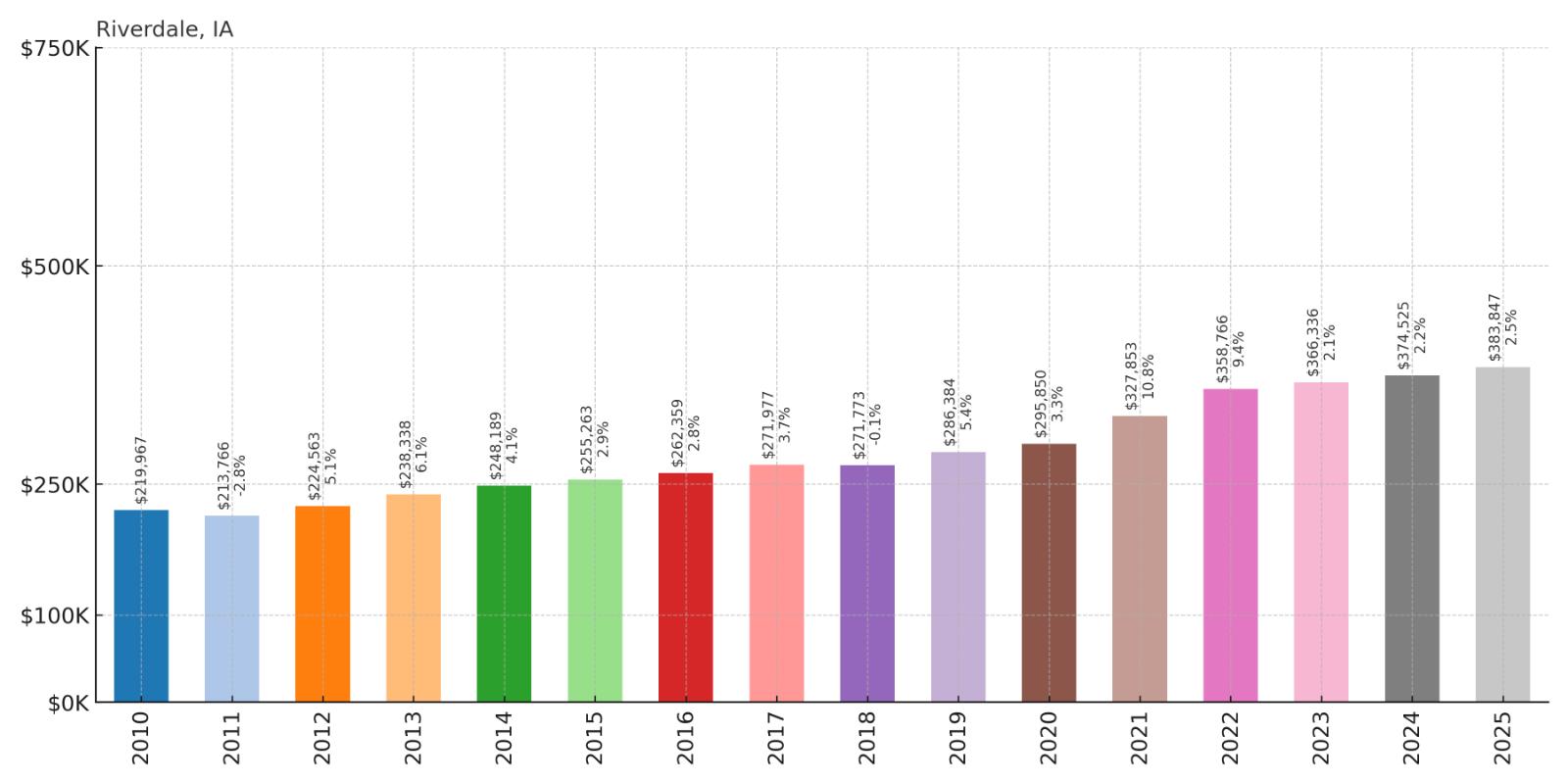
- 2010: $219,967
- 2011: $213,766
- 2012: $224,563
- 2013: $238,338
- 2014: $248,189
- 2015: $255,263
- 2016: $262,359
- 2017: $271,977
- 2018: $271,773
- 2019: $286,384
- 2020: $295,850
- 2021: $327,853
- 2022: $358,766
- 2023: $366,336
- 2024: $374,525
- 2025: $383,847
Riverdale has achieved steady 75% growth since 2010, with home values climbing from $219,967 to $383,847. The community showed consistent appreciation through most periods, with particularly strong gains during 2021-2022 when values jumped from $327,853 to $358,766. This growth pattern indicates sustained demand rather than speculative activity.
Why Riverdale?
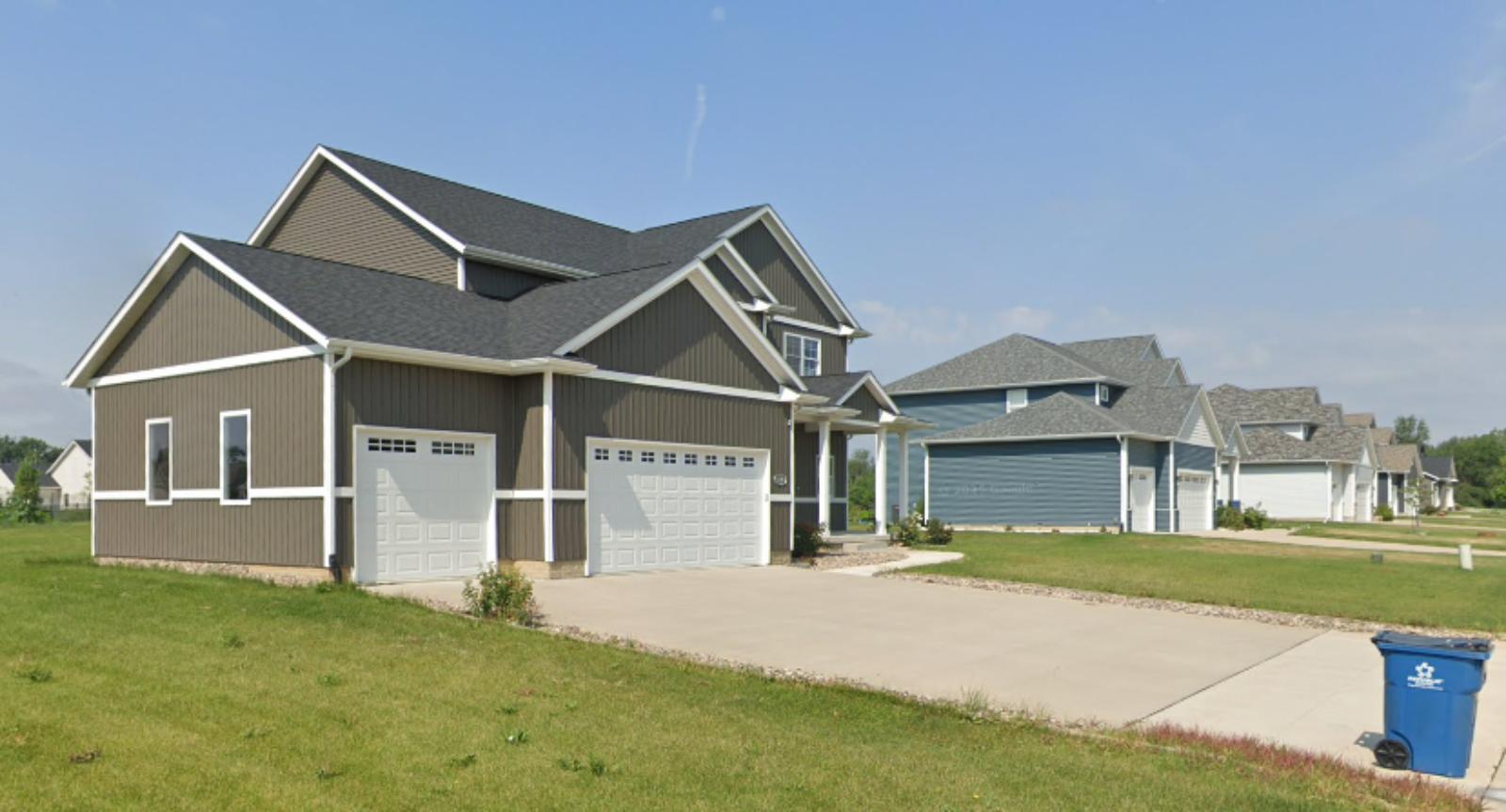
Why are people willing to pay so much to live here? What’s special about it?
Riverdale attracts residents with its combination of scenic bluff country location and proximity to the Quad Cities metropolitan area. The community offers larger lots and custom home opportunities while maintaining easy commuter access to major employment centers. Families value the strong Scott County school systems and low crime rates that create a safe, nurturing environment for children.
The area’s natural beauty, with rolling hills and mature trees, provides an upscale suburban setting that appeals to professionals and empty nesters. Community amenities include parks, walking trails, and well-maintained infrastructure that supports property values. The blend of rural charm and suburban convenience makes Riverdale particularly attractive to those seeking an escape from urban density without sacrificing modern amenities.
How Riverdale Rose to Prominence
Riverdale began as an unincorporated farming community in Scott County during the mid-1800s, with German and Irish settlers establishing homesteads along the bluffs overlooking the Mississippi River valley. The area remained predominantly agricultural through the mid-20th century, known for its fertile farmland and scenic countryside. The community’s name reflects its proximity to the Mississippi River and the rolling terrain that characterizes the region.
The transformation to a suburban residential community accelerated in the 1970s and 1980s as the Quad Cities metropolitan area expanded. Developers recognized the area’s appeal, with its combination of natural beauty, good schools, and convenient access to employment centers in Davenport and Bettendorf. The construction of upscale subdivisions and custom homes attracted affluent families seeking a prestigious address with small-town character.
3 Interesting Tidbits
- Bluff Country Beauty – Riverdale’s location in Iowa’s Mississippi River bluff country provides some of the most scenic residential settings in eastern Iowa, with many homes featuring valley views.
- Golf Course Community – The Riverdale Golf Club serves as a centerpiece for the community, with several neighborhoods built around the course and its amenities.
- Corporate Connections – Many residents are executives or professionals employed by major Quad Cities corporations, creating a high-income demographic that supports premium housing values.
26. Granger – 101% Home Price Increase Since 2010
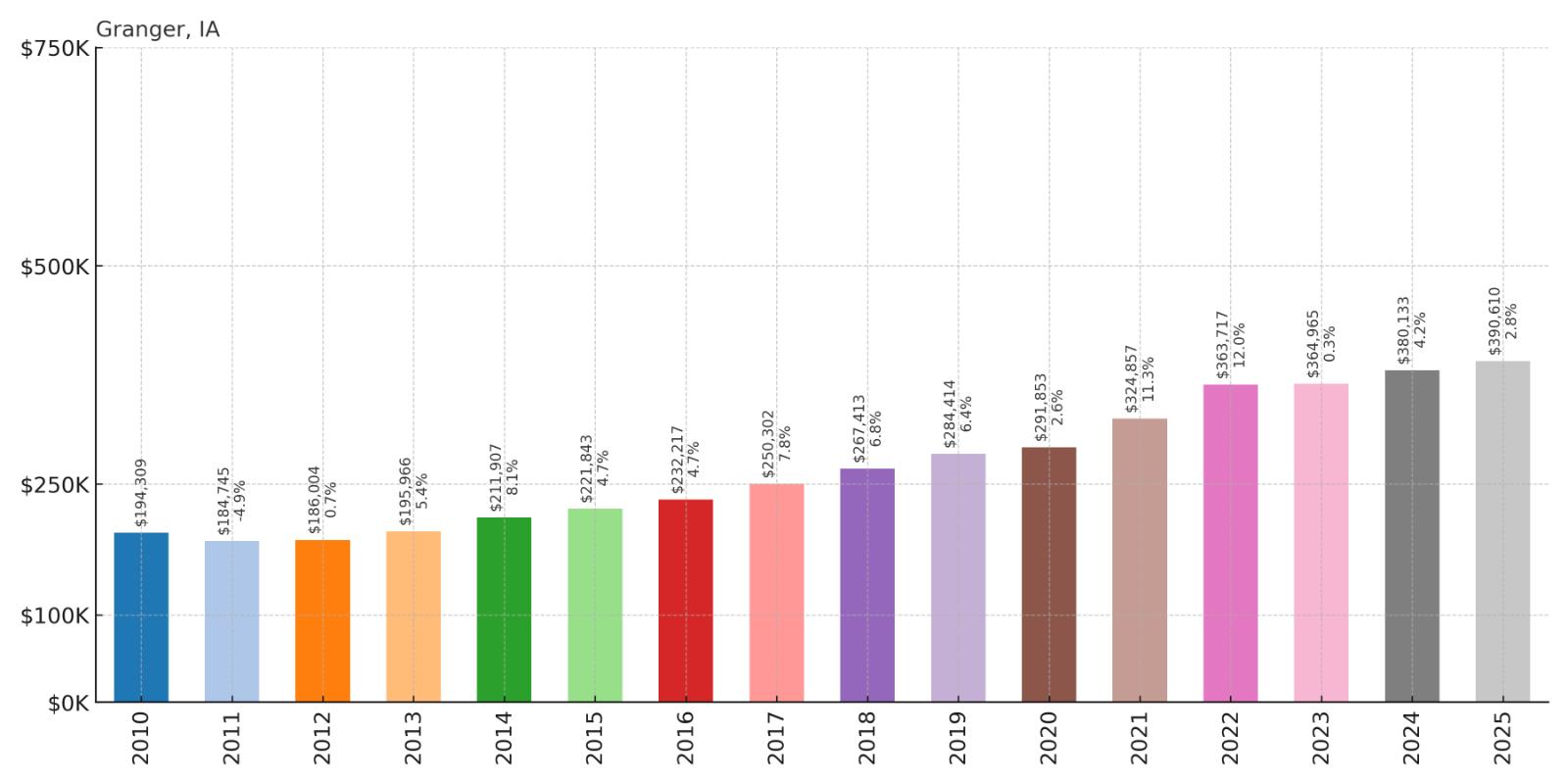
- 2010: $194,309
- 2011: $184,745
- 2012: $186,004
- 2013: $195,966
- 2014: $211,907
- 2015: $221,843
- 2016: $232,217
- 2017: $250,302
- 2018: $267,413
- 2019: $284,414
- 2020: $291,853
- 2021: $324,857
- 2022: $363,717
- 2023: $364,965
- 2024: $380,133
- 2025: $390,610
Granger stands out with home values more than doubling from $194,309 in 2010 to $390,610 today, representing a 101% increase. After initial declines during the early 2010s recession, the community experienced steady growth that accelerated dramatically after 2016. The most significant appreciation occurred from 2017-2022, when values jumped from $250,302 to $363,717.
Why Granger?
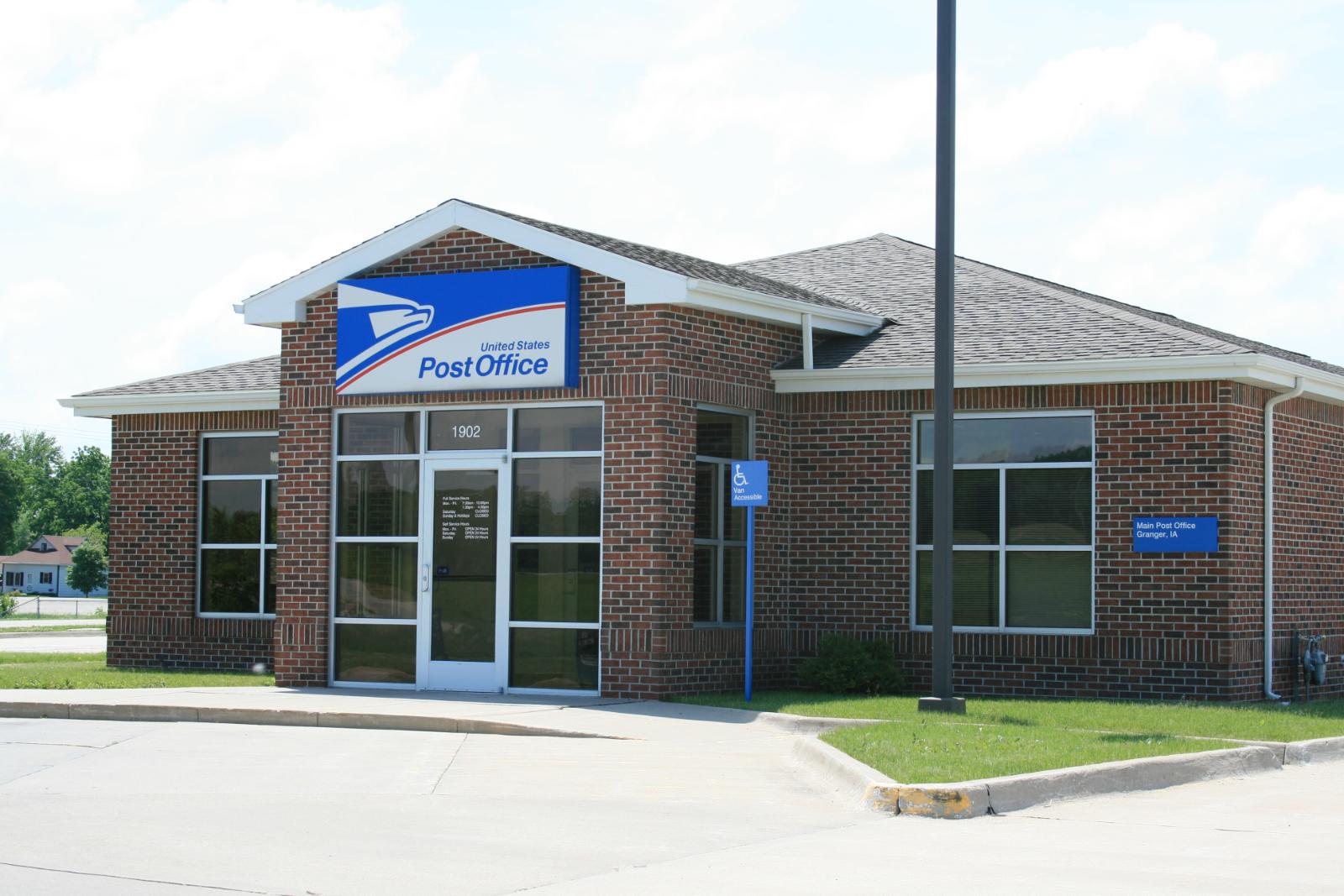
Why are people willing to pay so much to live here? What’s special about it?
Granger has become a sought-after suburban community due to its location in the highly regarded Dallas Center-Grimes school district and its proximity to Des Moines job centers. Families are drawn to the newer housing developments, excellent schools, and small-town atmosphere with big-city convenience. The community offers modern amenities while maintaining the charm of a close-knit rural town.
The area features well-planned neighborhoods with parks, walking trails, and recreational facilities that appeal to young families and professionals. Low crime rates and active community involvement create a safe, family-friendly environment that supports strong property values. The combination of excellent schools, new housing, and convenient commuter access makes Granger particularly attractive to upwardly mobile families.
How Granger Rose to Prominence
Founded in 1882 along the Chicago and North Western Railroad, Granger began as a small agricultural community serving local farming operations. The town was named after an early railroad official and developed as a grain shipping point for surrounding rural areas. For nearly a century, Granger remained a quiet farming community with a modest population centered around agriculture and railroad operations.
The community’s transformation began in the 1990s as Des Moines’ metropolitan area expanded westward and families sought communities with excellent schools and affordable housing. The Dallas Center-Grimes school district’s reputation for academic excellence became a major draw, while new residential developments offered modern homes with larger lots. This combination of educational quality, suburban amenities, and reasonable commuting distance to Des Moines drove Granger’s rapid growth and home value appreciation.
3 Interesting Tidbits
- Railroad Origins – The original Chicago and North Western depot still stands as a historical marker, reminding residents of the town’s transportation heritage that enabled its initial development.
- School District Star – The Dallas Center-Grimes school district consistently ranks among Iowa’s top academic performers, making Granger a magnet for education-focused families.
- Community Growth – Granger has grown from fewer than 1,000 residents in 2000 to over 1,500 today, representing some of the fastest population growth in central Iowa’s suburban communities.
25. Long Grove – 93% Home Price Increase Since 2010
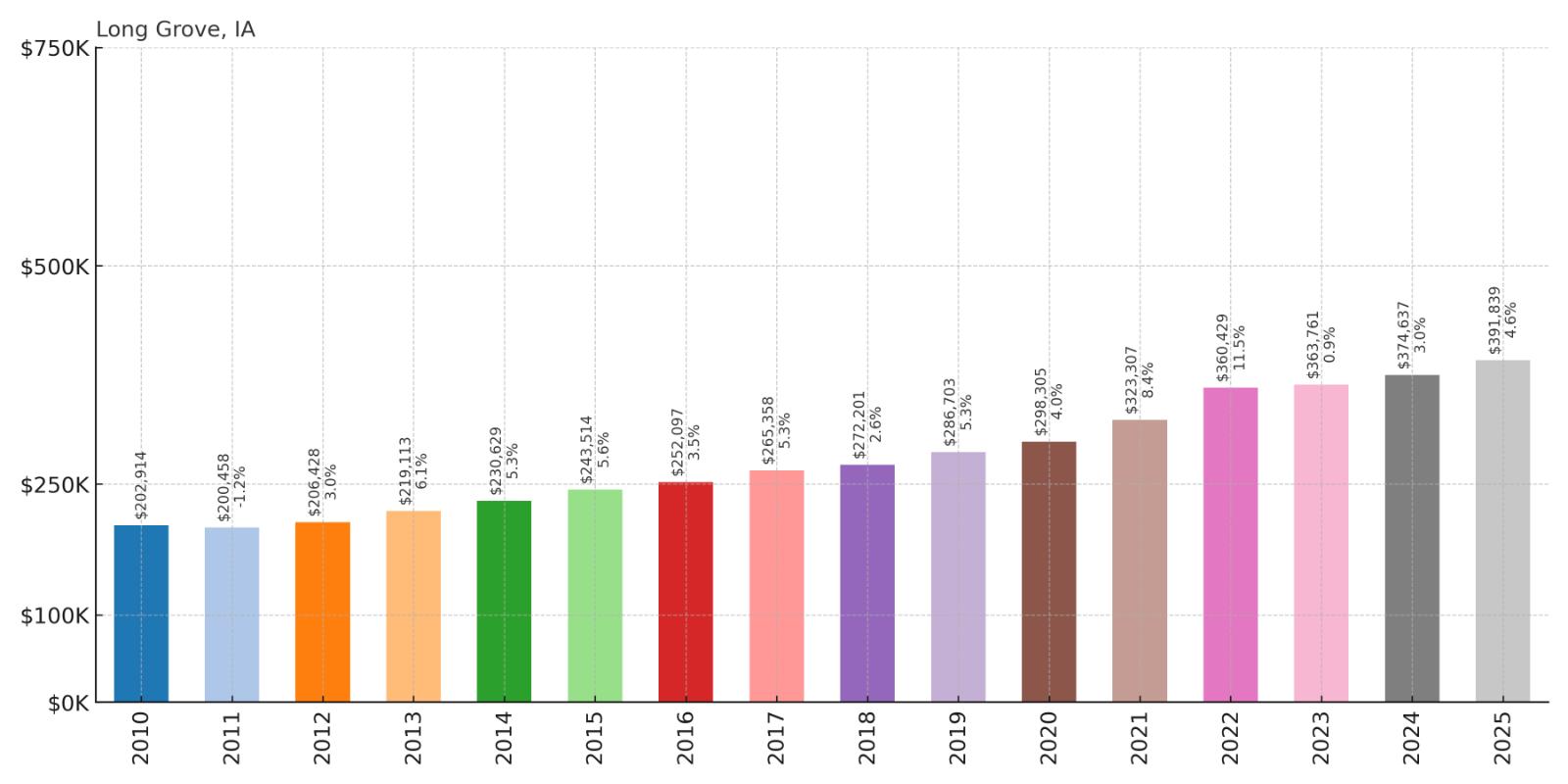
- 2010: $202,914
- 2011: $200,458
- 2012: $206,428
- 2013: $219,113
- 2014: $230,629
- 2015: $243,514
- 2016: $252,097
- 2017: $265,358
- 2018: $272,201
- 2019: $286,703
- 2020: $298,305
- 2021: $323,307
- 2022: $360,429
- 2023: $363,761
- 2024: $374,637
- 2025: $391,839
Long Grove has experienced impressive 93% growth, with median home values climbing from $202,914 in 2010 to $391,839 today. The community showed particularly strong appreciation during the mid-2010s and again during the 2020-2022 period. This consistent upward trajectory reflects the area’s appeal as a Quad Cities suburban community with rural character.
Why Long Grove?
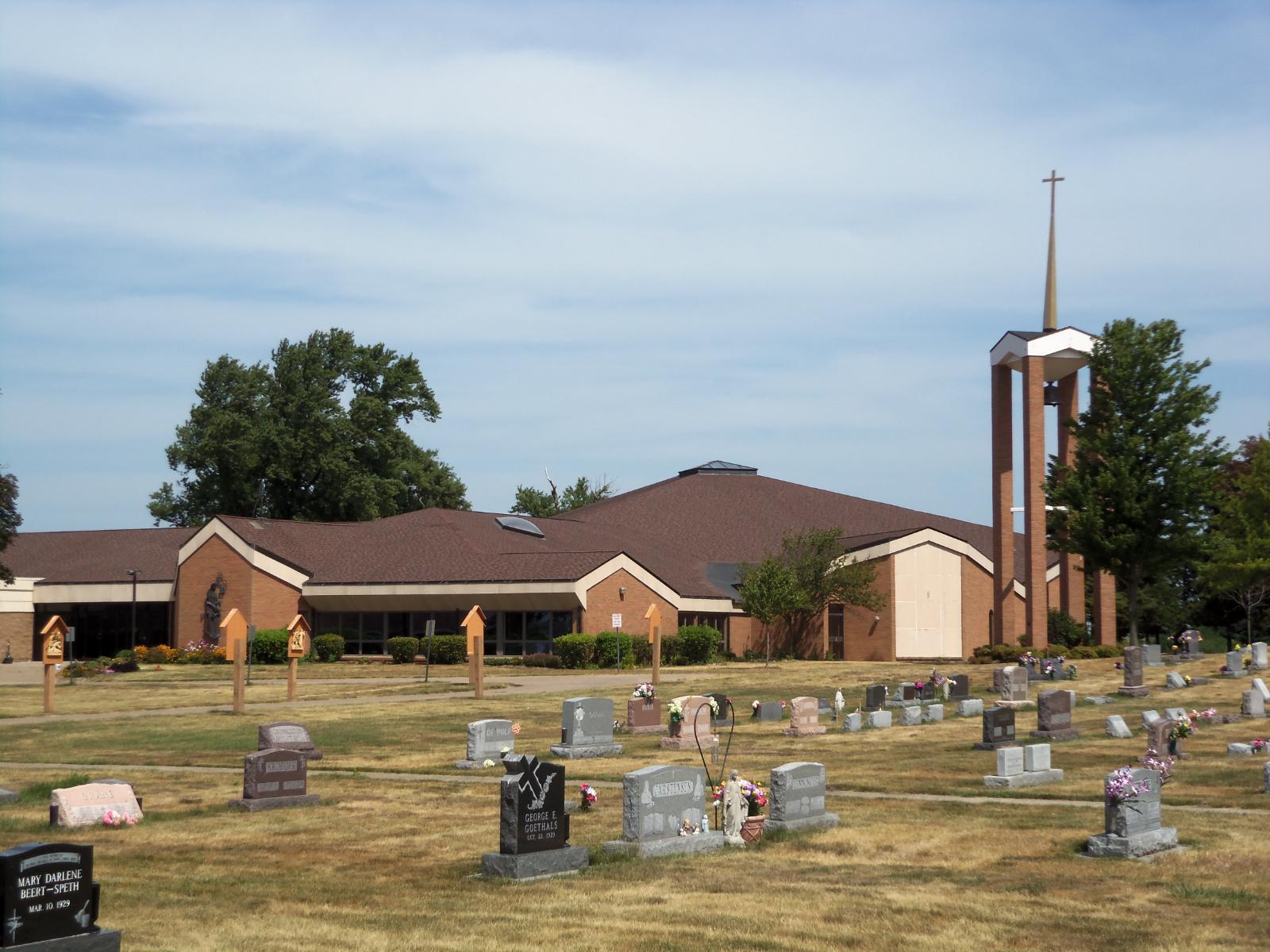
Why are people willing to pay so much to live here? What’s special about it?
Long Grove attracts families seeking the perfect balance of rural tranquility and suburban convenience within the Quad Cities metropolitan area. The community offers newer housing developments with larger lots while maintaining easy access to employment centers in Davenport, Bettendorf, and the surrounding region. Families particularly value the North Scott Community School District’s excellent reputation and the area’s low crime rates.
The scenic countryside setting, complete with rolling hills and mature trees, provides an appealing backdrop for upscale residential development. Community amenities include parks, walking trails, and recreational facilities that support an active lifestyle. The combination of natural beauty, excellent schools, and modern conveniences makes Long Grove especially attractive to professionals and growing families seeking a premium suburban experience.
How Long Grove Rose to Prominence
Long Grove began as a small agricultural settlement in Scott County during the mid-1800s, with German and Irish immigrants establishing farms throughout the area. The community took its name from the groves of mature trees that dotted the landscape, which early settlers preserved as they cleared land for farming. Throughout the late 19th and early 20th centuries, Long Grove remained a quiet farming community with a few rural businesses serving local residents.
The transformation to a suburban residential community began in the 1980s as the Quad Cities metropolitan area expanded and families sought communities with excellent schools and rural character. The North Scott Community School District’s growing reputation for academic excellence became a major attraction, while developers recognized the area’s potential for upscale housing. The combination of scenic countryside, top-rated schools, and convenient access to major employment centers drove steady residential growth and property value appreciation.
3 Interesting Tidbits
- Tree Heritage – The community’s name reflects the numerous groves of mature oak and maple trees that early settlers preserved, many of which still provide natural beauty throughout residential areas.
- School Excellence – North Scott Community School District serves Long Grove and consistently ranks among Iowa’s top school systems, making it a primary draw for family homebuyers.
- Country Estates – Many Long Grove properties feature larger lots and custom homes that blend rural estate living with suburban conveniences, appealing to affluent buyers seeking space and privacy.
24. Zwingle – 85% Home Price Increase Since 2016
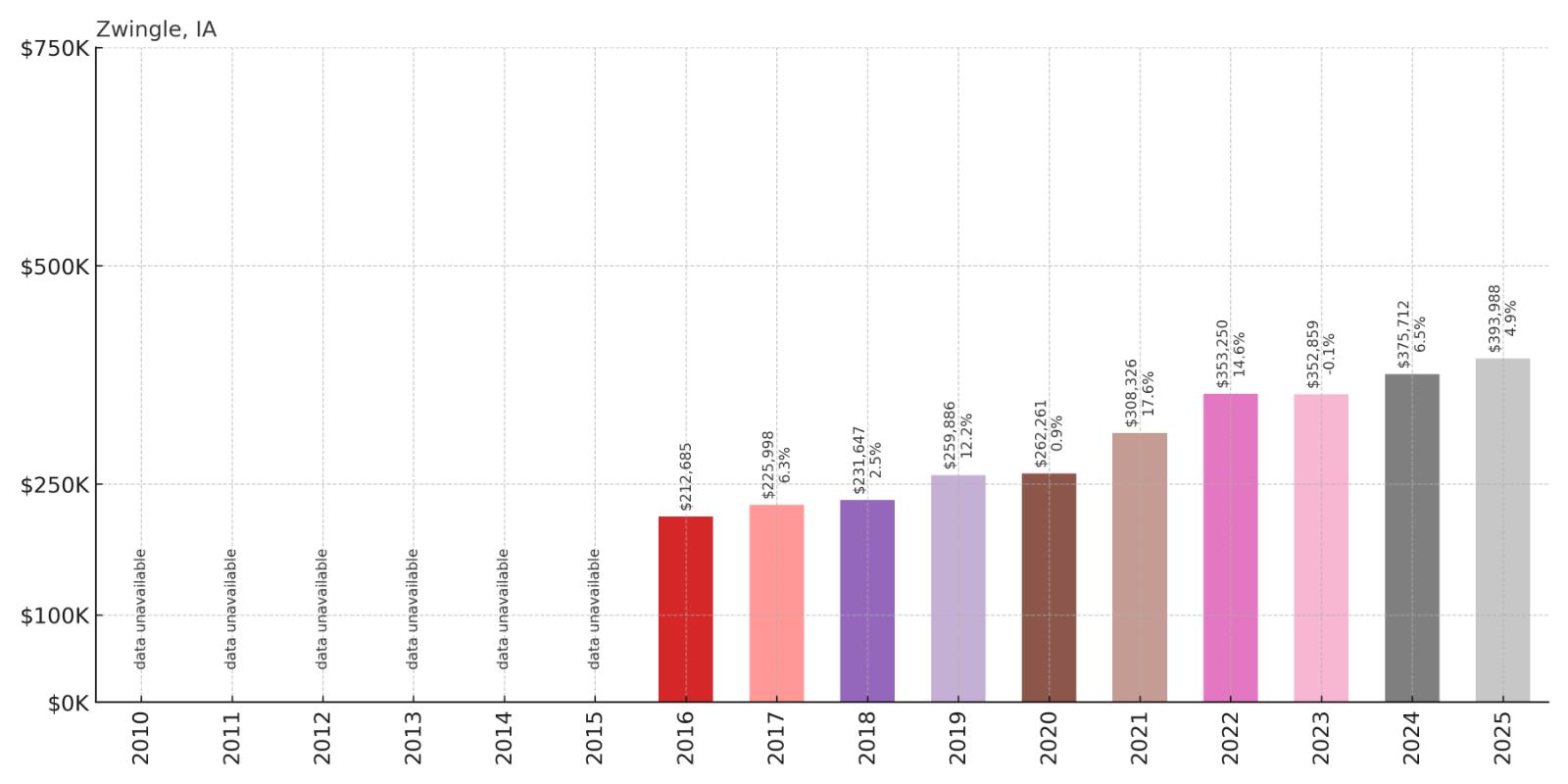
- 2010: N/A
- 2011: N/A
- 2012: N/A
- 2013: N/A
- 2014: N/A
- 2015: N/A
- 2016: $212,685
- 2017: $225,998
- 2018: $231,647
- 2019: $259,886
- 2020: $262,261
- 2021: $308,326
- 2022: $353,250
- 2023: $352,859
- 2024: $375,712
- 2025: $393,988
Zwingle shows remarkable 85% appreciation since 2016, when data first became available at $212,685, reaching $393,988 today. The community experienced steady growth through 2018, then accelerated significantly during 2019 when values jumped to $259,886. The strongest appreciation occurred during 2021-2022, reflecting broader rural housing market trends.
Why Zwingle?

Why are people willing to pay so much to live here? What’s special about it?
Zwingle appeals to buyers seeking authentic rural living with scenic countryside views and affordable property taxes. The small farming community offers larger lots, custom building opportunities, and a genuine agricultural setting that attracts families wanting to escape urban density. Proximity to Dubuque provides access to employment and amenities while maintaining true country living.
The area’s rolling hills and productive farmland create an appealing setting for rural residential development. Low population density and minimal commercial development preserve the area’s agricultural character, which appeals to those seeking privacy and tranquility. The combination of affordability, natural beauty, and rural lifestyle makes Zwingle attractive to both retirees and young families seeking an alternative to suburban development.
How Zwingle Rose to Prominence
Zwingle was established in the 1870s as a small farming community in Dubuque County, named after the Swiss Protestant reformer Huldrych Zwingli. Early German and Swiss immigrants settled the area, establishing dairy farms and grain operations that took advantage of the fertile soil and rolling countryside. The community remained small throughout its history, centered around a few rural businesses and the local Catholic church.
While Zwingle never experienced dramatic growth like larger communities, its recent residential development reflects broader trends toward rural living and remote work opportunities. The COVID-19 pandemic accelerated interest in rural properties as buyers sought larger lots, lower costs, and distance from urban areas. The community’s proximity to Dubuque’s employment opportunities while maintaining authentic rural character has attracted both retirees and younger families seeking countryside living.
3 Interesting Tidbits
- Swiss Heritage – The community name honors Huldrych Zwingli, reflecting the Swiss and German immigrant roots that shaped the area’s agricultural traditions and Catholic faith community.
- Agricultural Continuity – Zwingle remains an active farming community with working dairy and grain operations, providing an authentic rural environment that attracts suburban refugees.
- Hidden Valley – The community sits in a scenic valley setting with rolling hills that provide natural beauty and privacy, making it particularly attractive to custom home builders and rural lifestyle seekers.
23. Robins – 60% Home Price Increase Since 2010
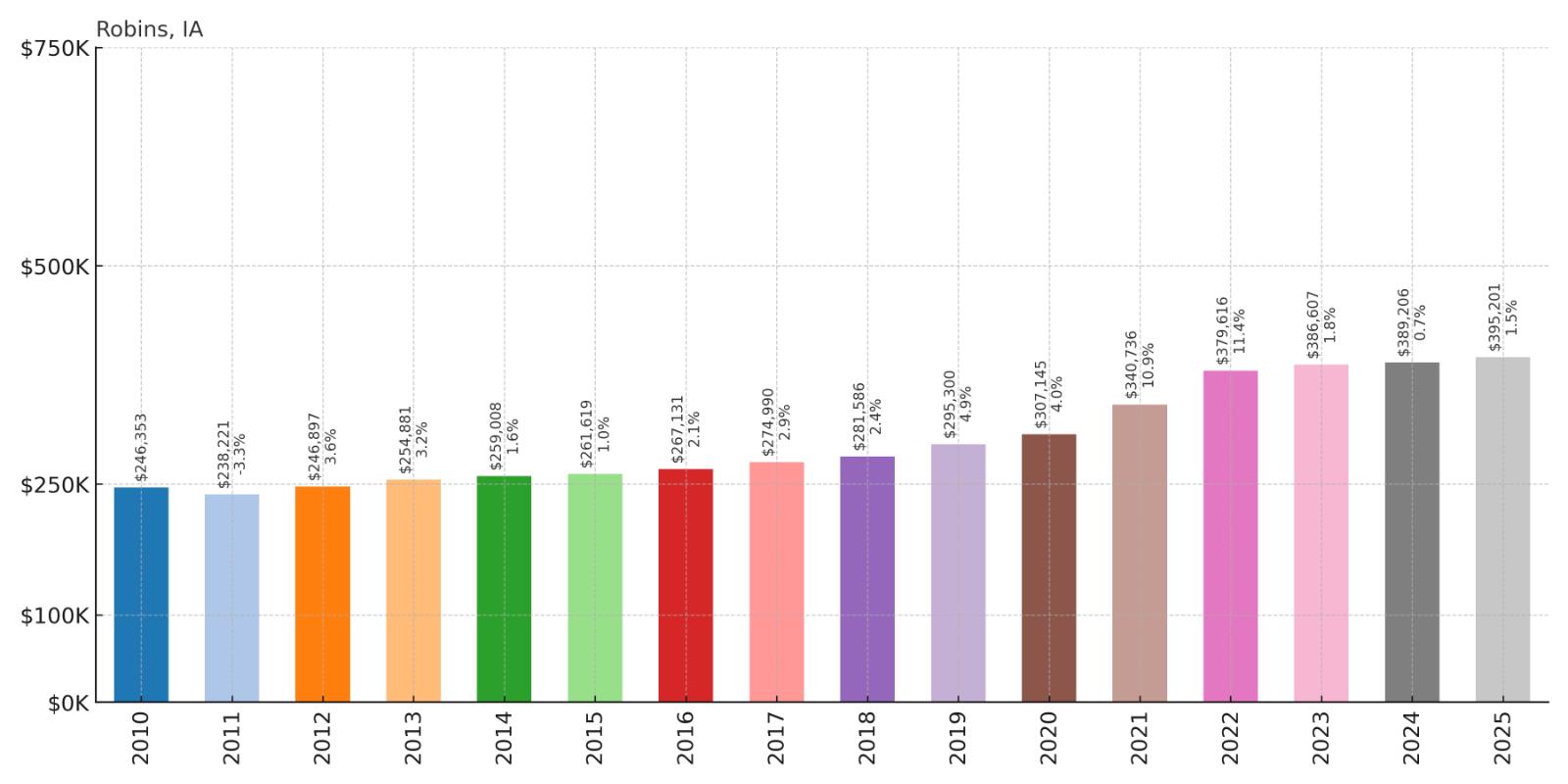
- 2010: $246,353
- 2011: $238,221
- 2012: $246,897
- 2013: $254,881
- 2014: $259,008
- 2015: $261,619
- 2016: $267,131
- 2017: $274,990
- 2018: $281,586
- 2019: $295,300
- 2020: $307,145
- 2021: $340,736
- 2022: $379,616
- 2023: $386,607
- 2024: $389,206
- 2025: $395,201
Robins demonstrates steady 60% growth over 15 years, starting from a higher baseline of $246,353 in 2010 and reaching $395,201 today. The community showed consistent but modest appreciation through 2020, then accelerated during 2021-2022 when values jumped from $340,736 to $379,616. This pattern reflects the area’s established desirability and mature housing market.
Why Robins?
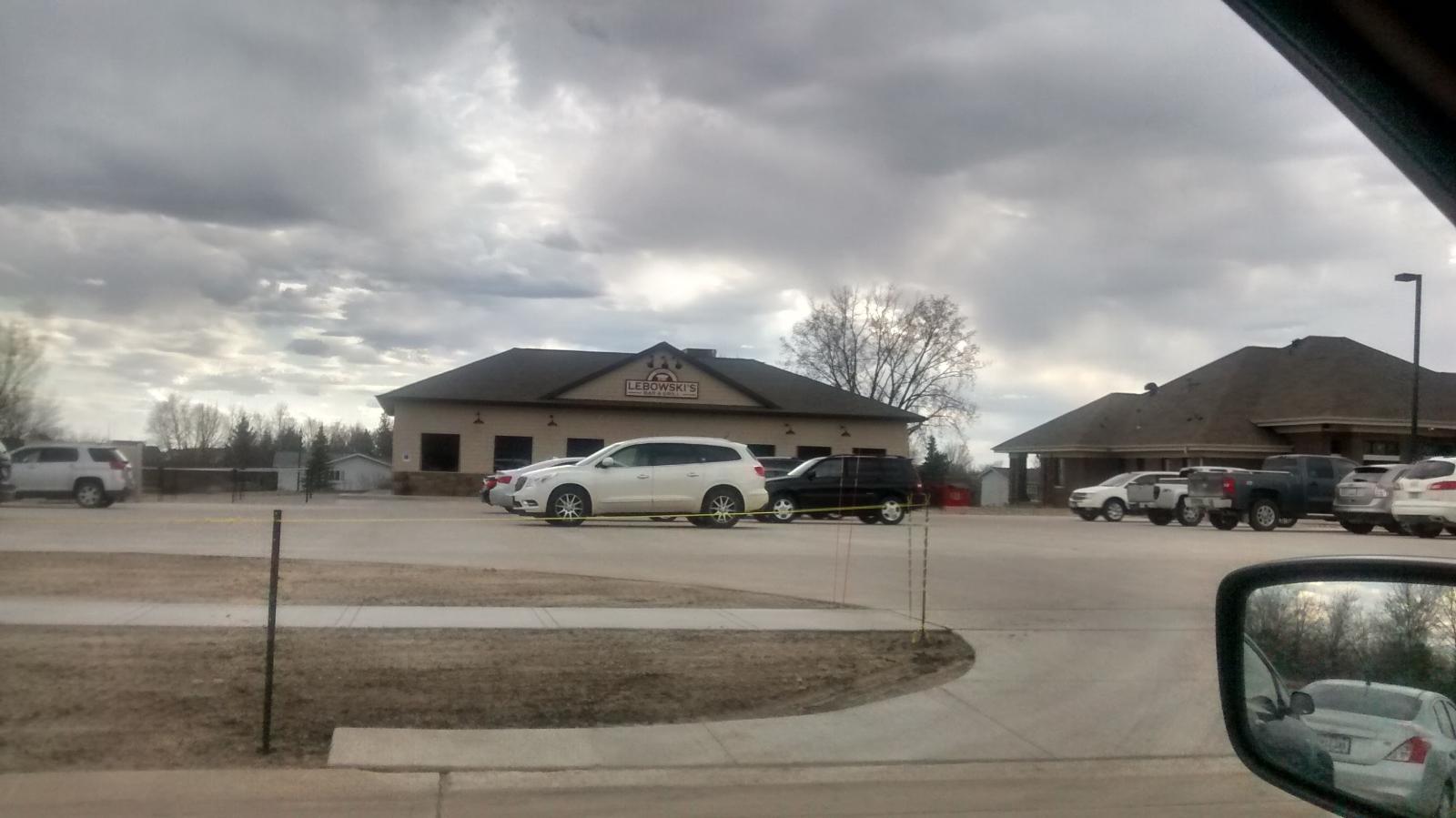
Why are people willing to pay so much to live here? What’s special about it?
Robins has established itself as one of eastern Iowa’s premier suburban communities, offering upscale housing within the highly regarded Linn-Mar school district. Families are drawn to the excellent schools, well-maintained neighborhoods, and convenient access to Cedar Rapids employment centers. The community features newer developments with larger lots while maintaining excellent municipal services and recreational facilities.
The area offers a perfect blend of suburban amenities and small-town character, with parks, walking trails, and community events that foster neighborhood connections. Professional families particularly value the combination of top-rated schools, low crime rates, and convenient commuting to major employers in Cedar Rapids and Iowa City. This reputation for quality of life supports consistent property values and demand.
How Robins Rose to Prominence
Robins began as an agricultural community in Linn County during the late 1800s, with farming families establishing homesteads throughout the area. The community remained rural and sparsely populated through most of the 20th century, known primarily for its fertile farmland and scattered rural residences. The area’s proximity to Cedar Rapids positioned it for eventual suburban development as the city expanded eastward.
The transformation to a prestigious suburban community began in the 1980s and accelerated through the 1990s as developers recognized the area’s potential. The excellent Linn-Mar school district boundaries became a major selling point, while the rolling countryside provided an attractive setting for upscale housing developments. Robins’ incorporation as a city in 1997 marked its evolution from rural farming community to one of Iowa’s most desirable suburban addresses, attracting affluent families seeking top-tier schools and modern amenities.
3 Interesting Tidbits
- School District Excellence – Robins’ location within the Linn-Mar school district boundaries makes it extremely attractive to families, as the district consistently ranks among Iowa’s top academic performers.
- Corporate Connection – Many residents work for major Cedar Rapids employers like Rockwell Collins (now Collins Aerospace), creating a high-income demographic that supports premium housing values.
- Recent Incorporation – As one of Iowa’s newer cities (incorporated 1997), Robins represents modern suburban planning with excellent infrastructure and family-friendly amenities built from the ground up.
22. Saint Charles – 176% Home Price Increase Since 2010

- 2010: $143,307
- 2011: $142,573
- 2012: $144,351
- 2013: $155,204
- 2014: $169,865
- 2015: $182,540
- 2016: $199,196
- 2017: $213,412
- 2018: $235,848
- 2019: $263,158
- 2020: $271,479
- 2021: $315,203
- 2022: $360,197
- 2023: $355,848
- 2024: $377,721
- 2025: $395,656
Saint Charles shows the most dramatic growth on this list with an extraordinary 176% increase since 2010. Starting from $143,307, values have nearly tripled to reach $395,656 today. The most impressive acceleration occurred from 2017-2022, when prices jumped from $213,412 to $360,197, representing explosive growth that outpaced most Iowa communities.
Why Saint Charles?
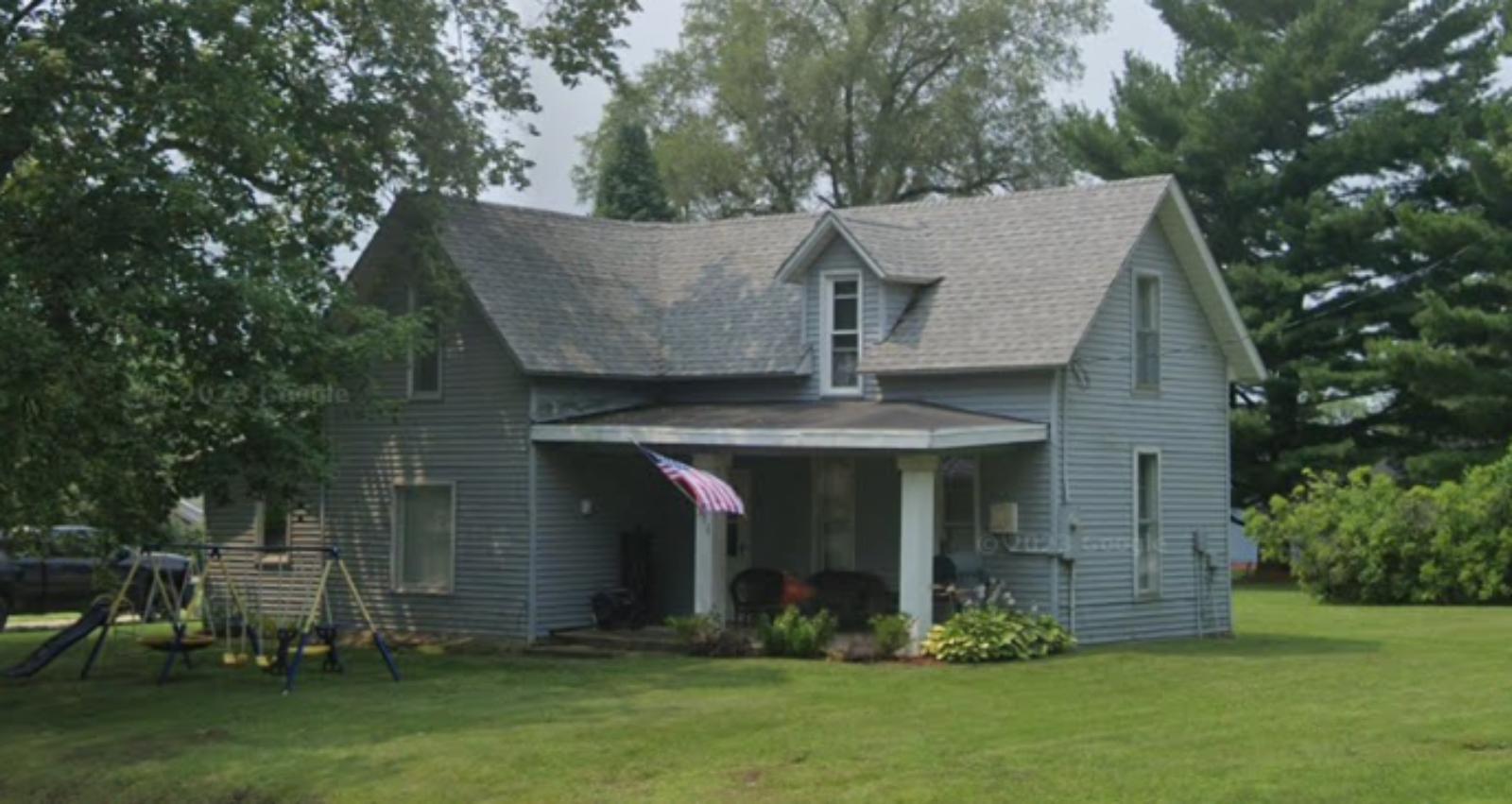
Why are people willing to pay so much to live here? What’s special about it?
Saint Charles has become increasingly attractive due to its location in the rapidly growing Des Moines metropolitan area with access to excellent recreational opportunities. The community offers affordable entry points compared to other Des Moines suburbs while providing small-town charm and outdoor recreation access. Families appreciate the strong sense of community and the abundance of recreational trails and natural areas nearby.
The area’s transformation from a quiet rural community to a sought-after suburban address reflects broader trends in Des Moines area growth. New housing developments and improved infrastructure have modernized the community while preserving its small-town character. The combination of affordability, recreation access, and commuter convenience makes Saint Charles particularly attractive to young families and outdoor enthusiasts.
How Saint Charles Rose to Prominence
Founded in the 1850s as a coal mining community, Saint Charles initially thrived on underground mining operations that employed hundreds of workers through the early 20th century. The town was named after Saint Charles Borromeo and developed around the mining industry, with company housing and businesses serving the mining families. When coal mining declined in the mid-20th century, Saint Charles faced economic challenges and population loss.
The community’s renaissance began in the 1990s as Des Moines’ metropolitan area expanded southward and recreational trail development brought new attention to the area. The completion of the Raccoon River Valley Trail, which passes through Saint Charles, transformed the town into a recreational destination. This trail access, combined with affordable housing and small-town charm, began attracting new residents seeking an alternative to traditional suburban development while maintaining reasonable commuting access to Des Moines.
3 Interesting Tidbits
- Coal Mining Legacy – Historic mine sites and remnants of company housing tell the story of Saint Charles’ industrial past, when it was one of Iowa’s major coal-producing communities.
- Trail Town Status – The Raccoon River Valley Trail brings thousands of cyclists and outdoor enthusiasts through Saint Charles annually, boosting tourism and local business while raising the community’s profile.
- Recreational Hub – Lake Ahquabi State Park and other outdoor recreation areas near Saint Charles make it particularly attractive to families who enjoy camping, fishing, and outdoor activities.
21. Alleman – 79% Home Price Increase Since 2010
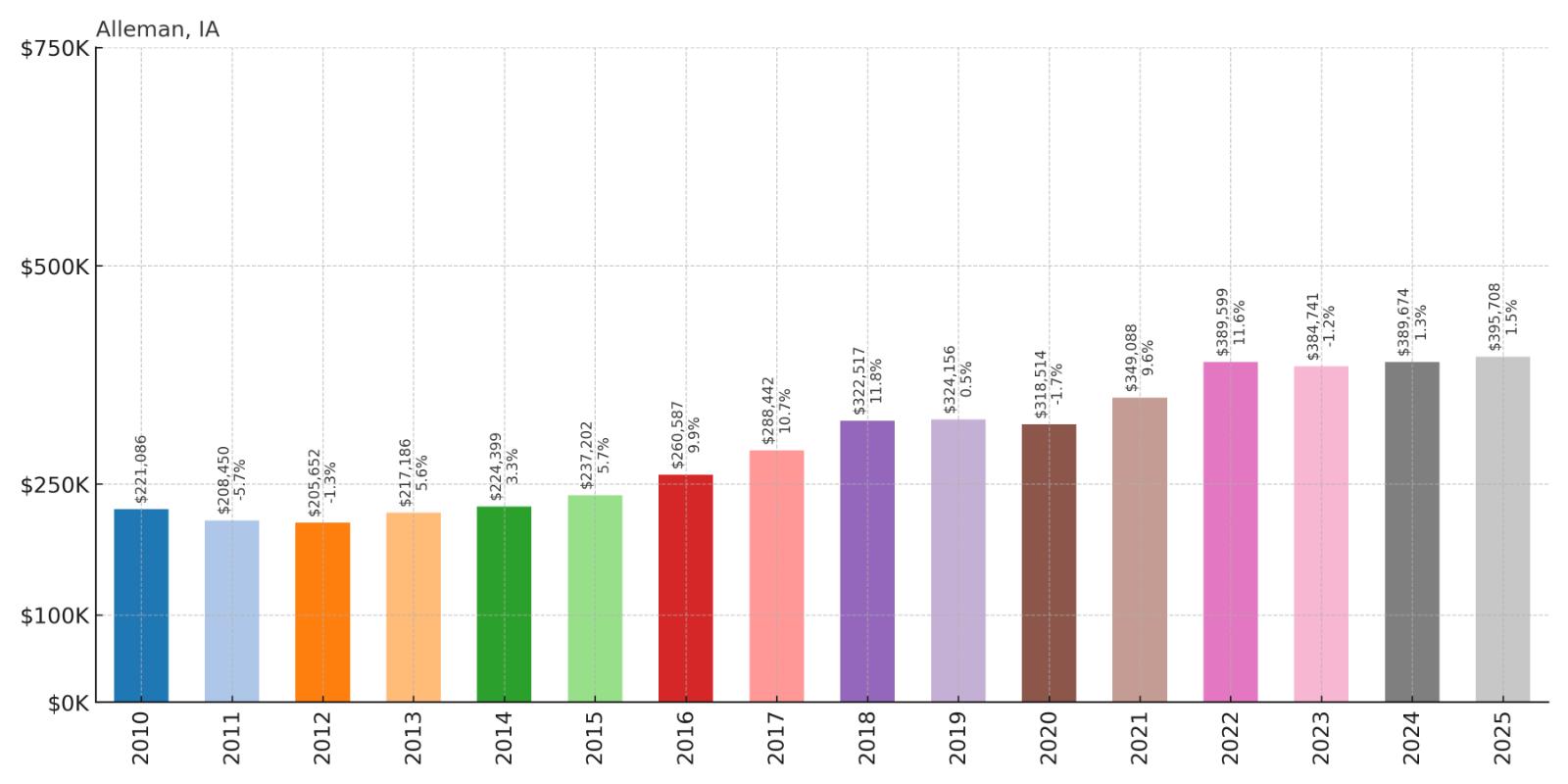
- 2010: $221,086
- 2011: $208,450
- 2012: $205,652
- 2013: $217,186
- 2014: $224,399
- 2015: $237,202
- 2016: $260,587
- 2017: $288,442
- 2018: $322,517
- 2019: $324,156
- 2020: $318,514
- 2021: $349,088
- 2022: $389,599
- 2023: $384,741
- 2024: $389,674
- 2025: $395,708
Alleman has achieved solid 79% growth since 2010, with values climbing from $221,086 to $395,708 today. After initial declines during the early 2010s recession, the community experienced particularly strong appreciation from 2015-2018 when values jumped from $237,202 to $322,517. The growth pattern shows consistent demand in this central Iowa community.
Why Alleman?
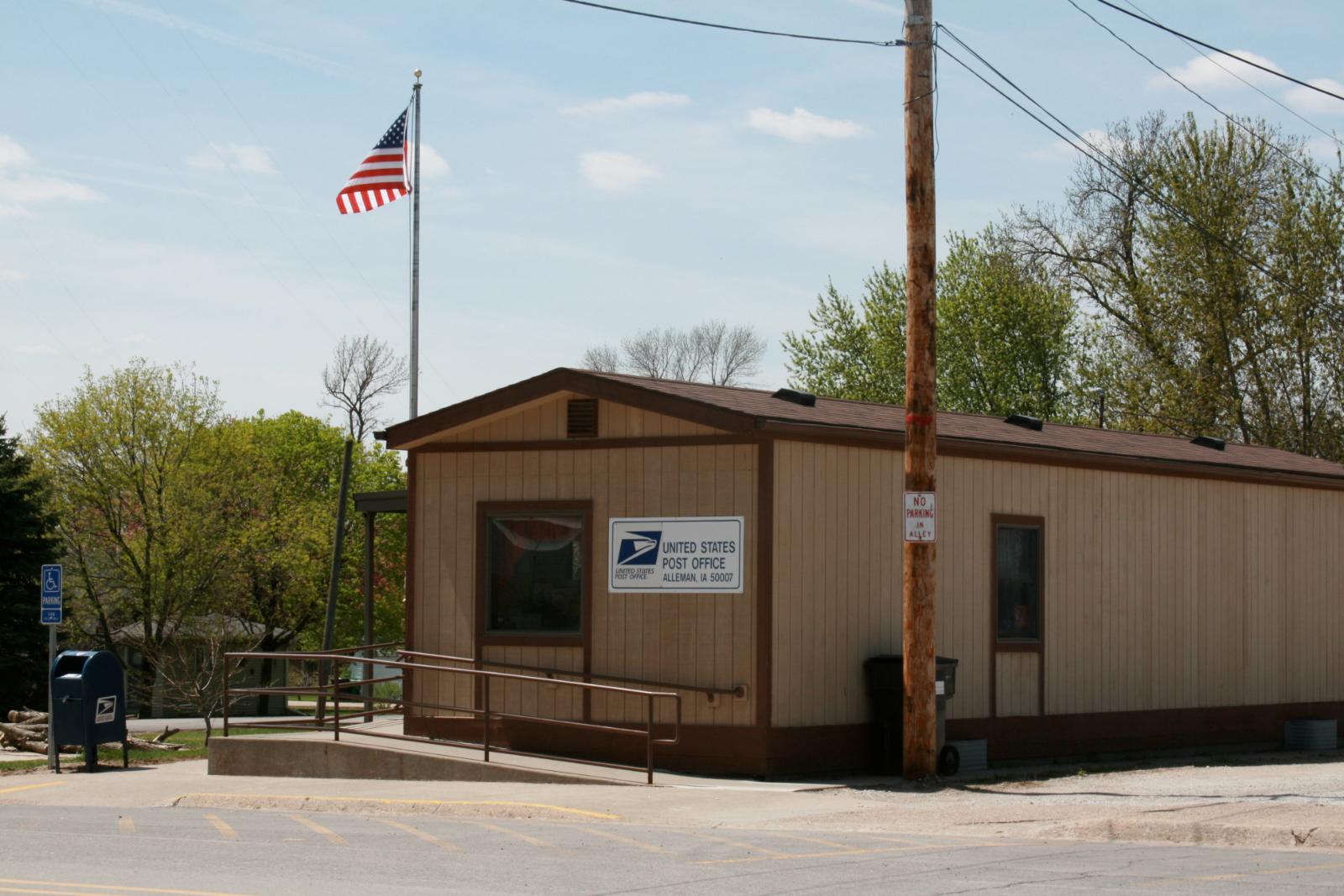
Why are people willing to pay so much to live here? What’s special about it?
Alleman attracts residents seeking small-town living within reasonable commuting distance of Ames and Des Moines employment centers. The community offers affordable housing compared to larger cities while maintaining rural character and lower cost of living. Families value the tight-knit community atmosphere, low crime rates, and access to outdoor recreation opportunities in central Iowa.
The area provides a genuine small-town experience with community events and local businesses that create strong neighborhood connections. Agricultural heritage blends with modern conveniences, appealing to those who want to escape urban density without sacrificing access to employment and services. The combination of affordability, community spirit, and convenient location makes Alleman attractive to diverse demographics seeking authentic Iowa living.
How Alleman Rose to Prominence
Alleman was established in 1881 as a railroad town along the Chicago and North Western Railroad, serving as a shipping point for local agricultural products. Named after a railroad official, the community developed around grain elevators, livestock pens, and businesses serving surrounding farming operations. Throughout the early 20th century, Alleman remained a small but vital agricultural hub in Polk County.
The community’s modern development began in the latter half of the 20th century as improved transportation connected it to larger employment centers in Ames and Des Moines. While maintaining its agricultural character, Alleman began attracting residents who appreciated small-town living with reasonable access to urban amenities. The construction of new housing developments and the preservation of historic downtown buildings created an appealing blend of old and new that attracts families seeking authentic Iowa community life.
3 Interesting Tidbits
- Railroad Heritage – The original Chicago and North Western depot and grain elevators remain as reminders of Alleman’s transportation and agricultural heritage that shaped its early development.
- Community Events – Annual celebrations like Alleman Fun Days bring residents together and maintain the small-town community spirit that attracts families seeking close neighborhood connections.
- Agricultural Continuity – Active farming operations continue within and around Alleman, providing authentic rural character while supporting local businesses and maintaining the community’s agricultural identity.
20. Adel – 156% Home Price Increase Since 2010
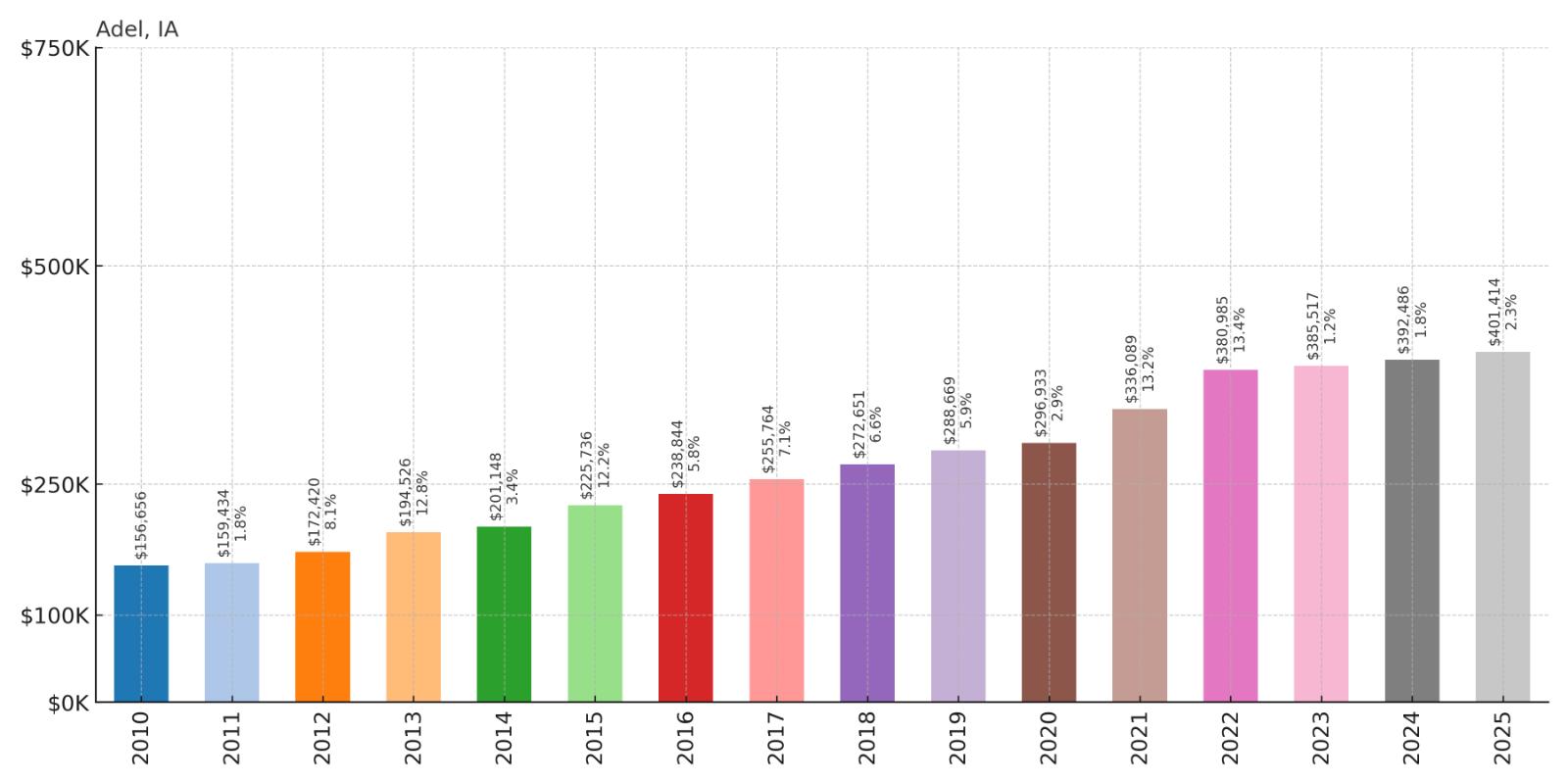
- 2010: $156,656
- 2011: $159,434
- 2012: $172,420
- 2013: $194,526
- 2014: $201,148
- 2015: $225,736
- 2016: $238,844
- 2017: $255,764
- 2018: $272,651
- 2019: $288,669
- 2020: $296,933
- 2021: $336,089
- 2022: $380,985
- 2023: $385,517
- 2024: $392,486
- 2025: $401,414
Adel demonstrates remarkable 156% appreciation since 2010, with home values climbing from $156,656 to $401,414 today. The community showed steady growth throughout the entire period, with particularly strong gains during 2013-2015 and again during 2021-2022. This consistent upward trajectory reflects Adel’s growing appeal as a Des Moines area suburb with small-town character.
Why Adel?
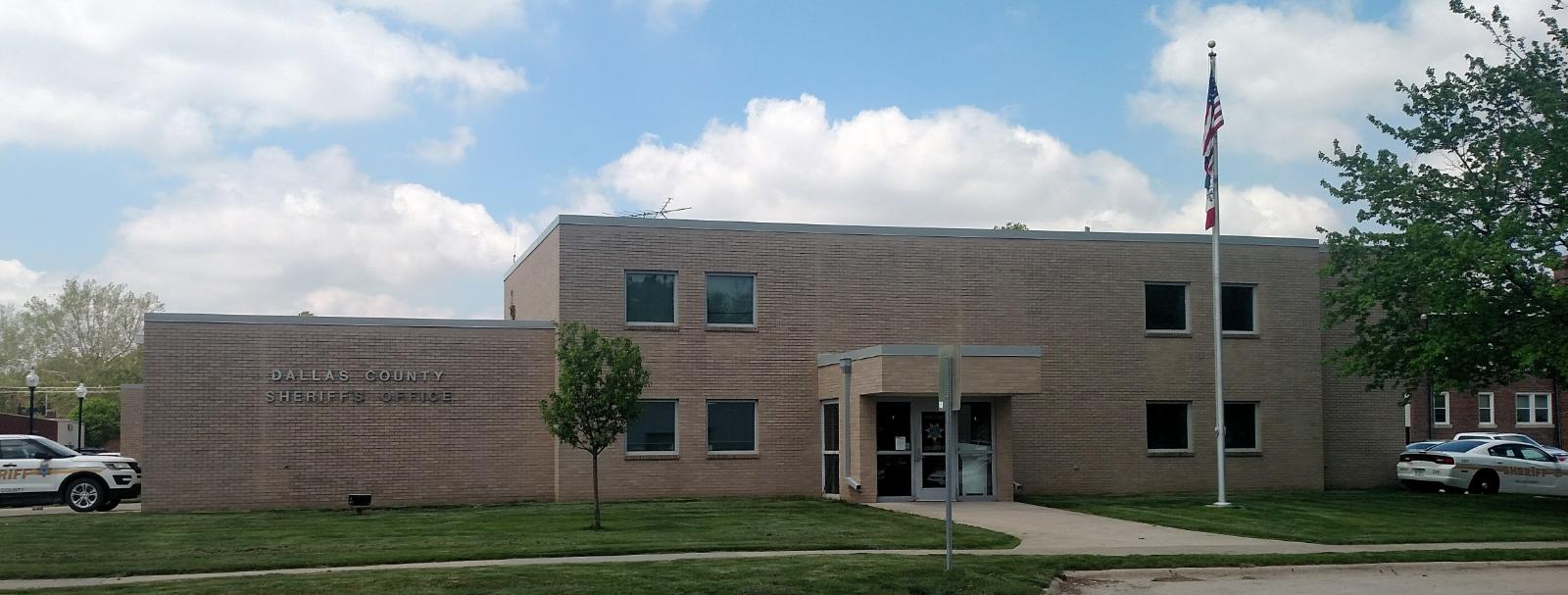
Why are people willing to pay so much to live here? What’s special about it?
Adel has become highly sought-after due to its location within the excellent ADM (Adel-DeSoto-Minburn) school district and its convenient access to Des Moines employment centers. Families are drawn to the community’s blend of small-town charm and suburban amenities, including well-maintained parks, recreational facilities, and a historic downtown district. The area offers newer housing developments while preserving its agricultural heritage and rural character.
The community features excellent municipal services, low crime rates, and active community involvement that creates a family-friendly environment. Annual events like the Sweet Corn Festival and Christmas in Adel bring residents together while attracting visitors from across the region. This combination of quality schools, community spirit, and convenient location makes Adel particularly attractive to young professionals and growing families.
How Adel Rose to Prominence
Adel was founded in 1847 by William Barlow, who named the town after Adele Barlow, reportedly a relative. The community developed as an agricultural center in Dallas County, with early settlers establishing farms and businesses to serve the surrounding rural population. The arrival of the Chicago, Rock Island and Pacific Railroad in the 1880s boosted Adel’s growth and established it as a regional shipping point for grain and livestock.
The town’s transformation into a desirable suburban community began in the 1990s as Des Moines’ metropolitan area expanded westward. The ADM school district’s excellent reputation became a major draw for families, while new housing developments offered modern amenities with small-town character. Adel’s preservation of its historic downtown, combined with modern infrastructure and recreational facilities, created an appealing balance that attracts residents seeking quality of life with reasonable commuting access to Des Moines.
3 Interesting Tidbits
- Sweet Corn Capital – Adel’s annual Sweet Corn Festival celebrates the community’s agricultural heritage and draws thousands of visitors each summer, contributing to local business and community pride.
- Historic Downtown – The preserved downtown district features original brick buildings and local businesses that maintain small-town character while supporting modern economic development.
- School Excellence – The ADM school district consistently ranks among Iowa’s top academic performers, making Adel a magnet community for education-focused families throughout the Des Moines metro area.
19. Johnston – 73% Home Price Increase Since 2010
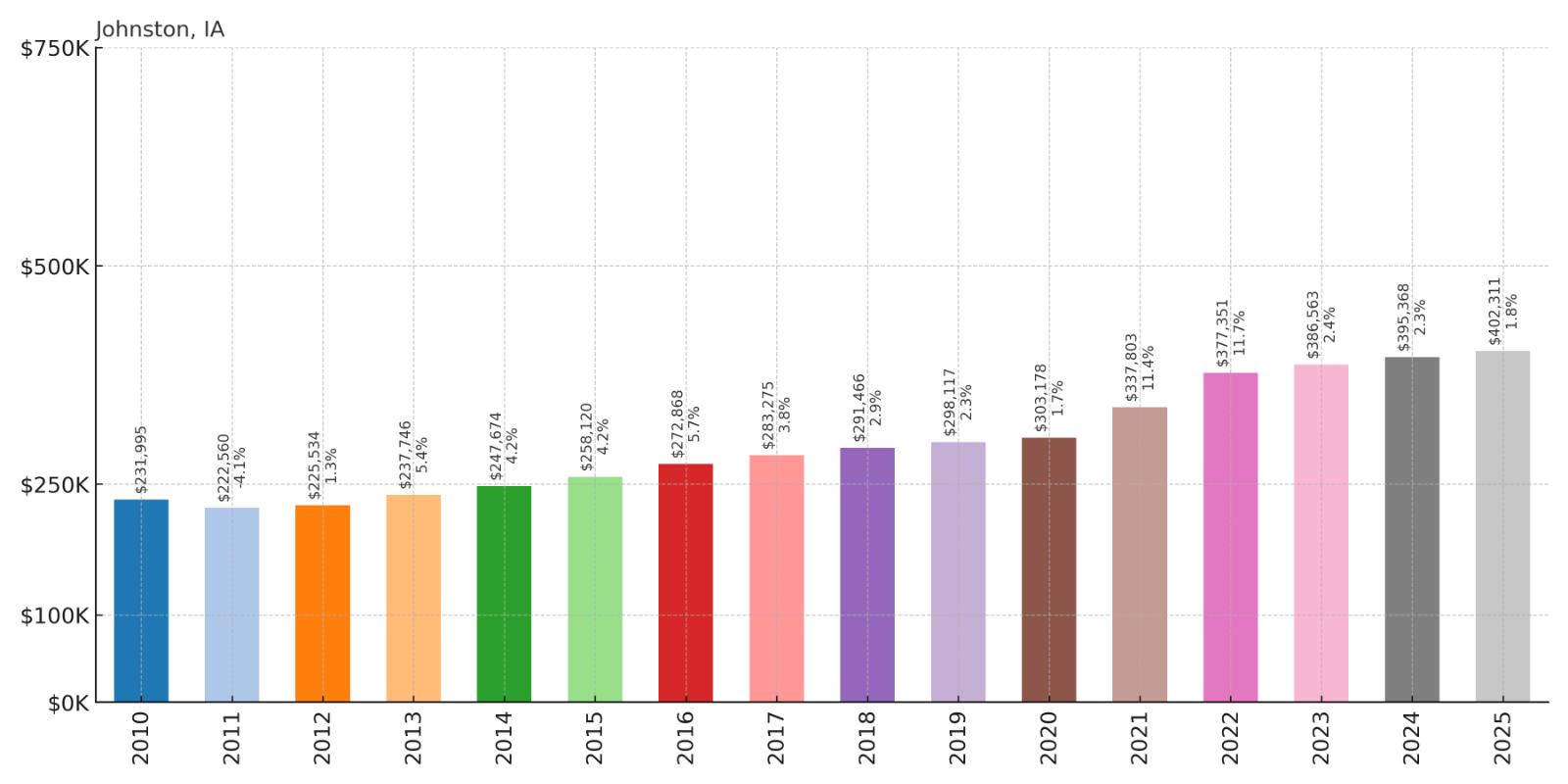
- 2010: $231,995
- 2011: $222,560
- 2012: $225,534
- 2013: $237,746
- 2014: $247,674
- 2015: $258,120
- 2016: $272,868
- 2017: $283,275
- 2018: $291,466
- 2019: $298,117
- 2020: $303,178
- 2021: $337,803
- 2022: $377,351
- 2023: $386,563
- 2024: $395,368
- 2025: $402,311
Johnston has achieved steady 73% growth since 2010, with home values rising from $231,995 to $402,311 today. The community showed consistent but moderate appreciation through 2020, then accelerated during 2021-2022 when values jumped from $337,803 to $377,351. This growth pattern reflects Johnston’s established reputation as one of central Iowa’s premier suburban communities.
Why Johnston?
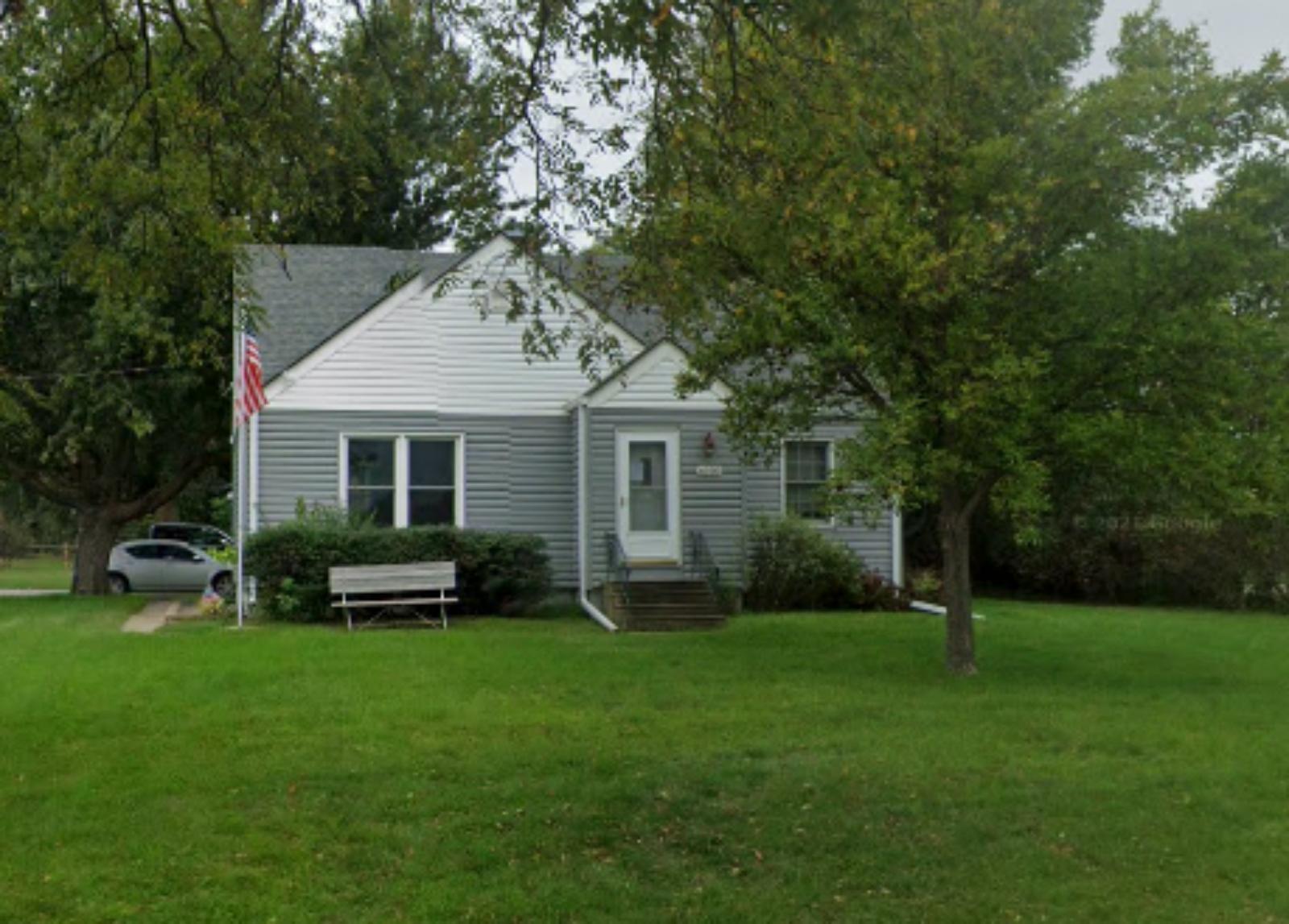
Why are people willing to pay so much to live here? What’s special about it?
Johnston ranks among Iowa’s most desirable suburban communities due to its combination of excellent schools, upscale housing, and convenient Des Moines access. The Johnston Community School District consistently ranks among the state’s top performers, attracting families willing to pay premium prices for educational excellence. The community features well-planned neighborhoods, abundant parks and recreational facilities, and a thriving business district.
Professional families particularly value Johnston’s blend of suburban amenities and small-town character, with excellent municipal services and low crime rates creating a safe, family-friendly environment. The community’s active recreation programs, quality infrastructure, and convenient location make it especially attractive to affluent families seeking the best of suburban living. This reputation for quality of life supports strong property values and consistent demand.
How Johnston Rose to Prominence
Johnston began as a small railroad community in the 1880s along the Chicago, Rock Island and Pacific Railroad, initially named Coal Valley for the coal deposits in the area. The town was renamed Johnston in 1890 to honor a local railroad supervisor. For much of its early history, Johnston remained a small agricultural community serving surrounding farms and coal mining operations.
The transformation to a premier suburban community began in the 1960s and accelerated through the following decades as Des Moines expanded northward. Developers recognized Johnston’s potential, with its proximity to downtown Des Moines, available land for development, and potential for excellent schools. The community’s strategic planning, emphasis on quality development, and investment in schools and parks created one of Iowa’s most successful suburban communities, attracting affluent families and supporting strong property values.
3 Interesting Tidbits
- Green City Initiative – Johnston has received recognition as one of Iowa’s most environmentally conscious communities, with extensive green space preservation and sustainable development practices.
- Corporate Headquarters – Several major companies have located headquarters or major facilities in Johnston, creating high-paying jobs and attracting professional residents who support premium housing values.
- Recreation Excellence – The Johnston Recreation Center and extensive trail system provide resort-quality amenities that contribute to the community’s reputation and property values.
18. Okoboji – 119% Home Price Increase Since 2010
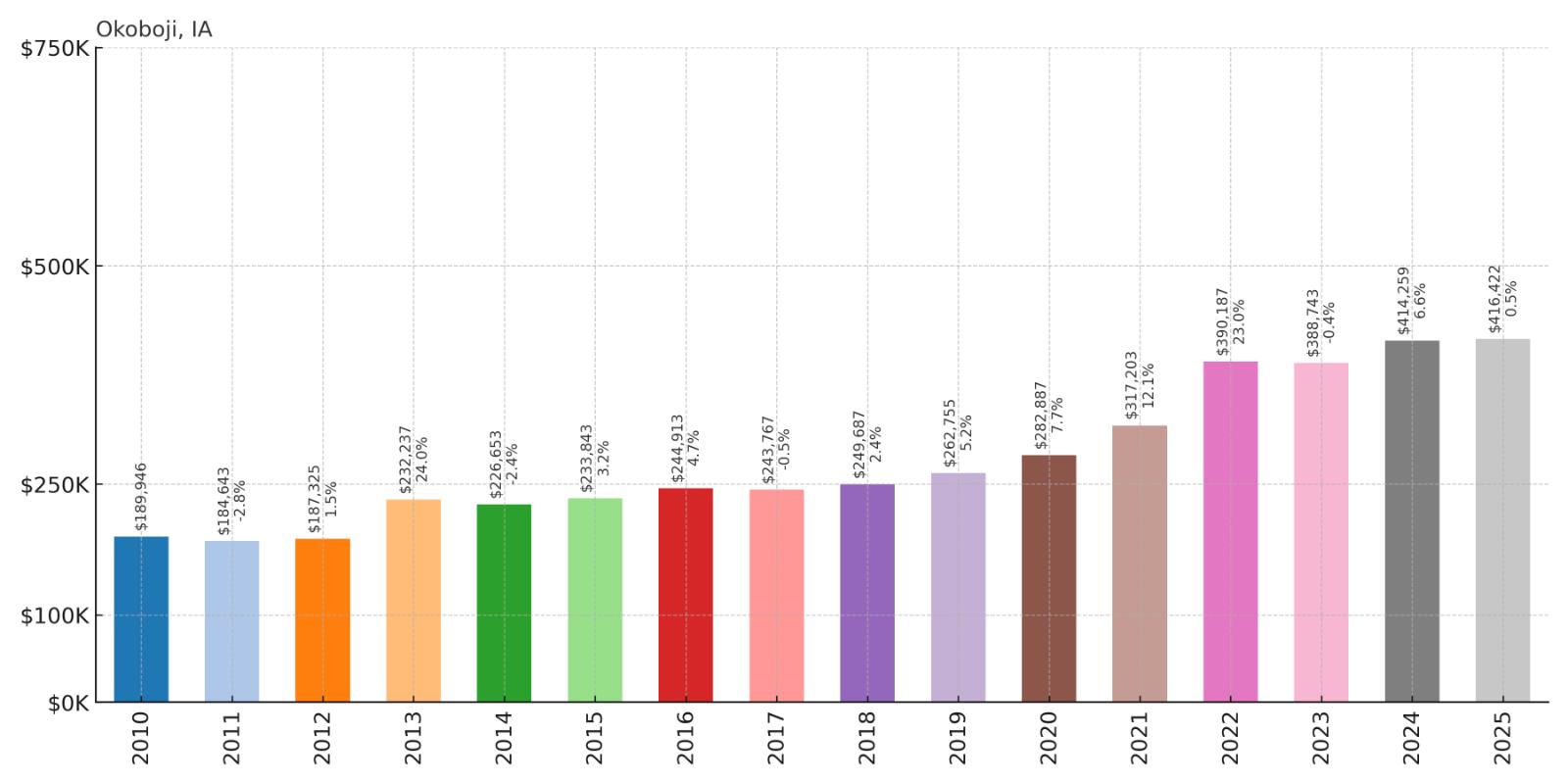
- 2010: $189,946
- 2011: $184,643
- 2012: $187,325
- 2013: $232,237
- 2014: $226,653
- 2015: $233,843
- 2016: $244,913
- 2017: $243,767
- 2018: $249,687
- 2019: $262,755
- 2020: $282,887
- 2021: $317,203
- 2022: $390,187
- 2023: $388,743
- 2024: $414,259
- 2025: $416,422
Okoboji shows exceptional 119% growth since 2010, with values more than doubling from $189,946 to $416,422 today. The community experienced dramatic acceleration during 2022 when values jumped from $317,203 to $390,187, reflecting the intense demand for lakefront recreational properties. This growth pattern demonstrates Okoboji’s appeal as Iowa’s premier vacation and retirement destination.
Why Okoboji?
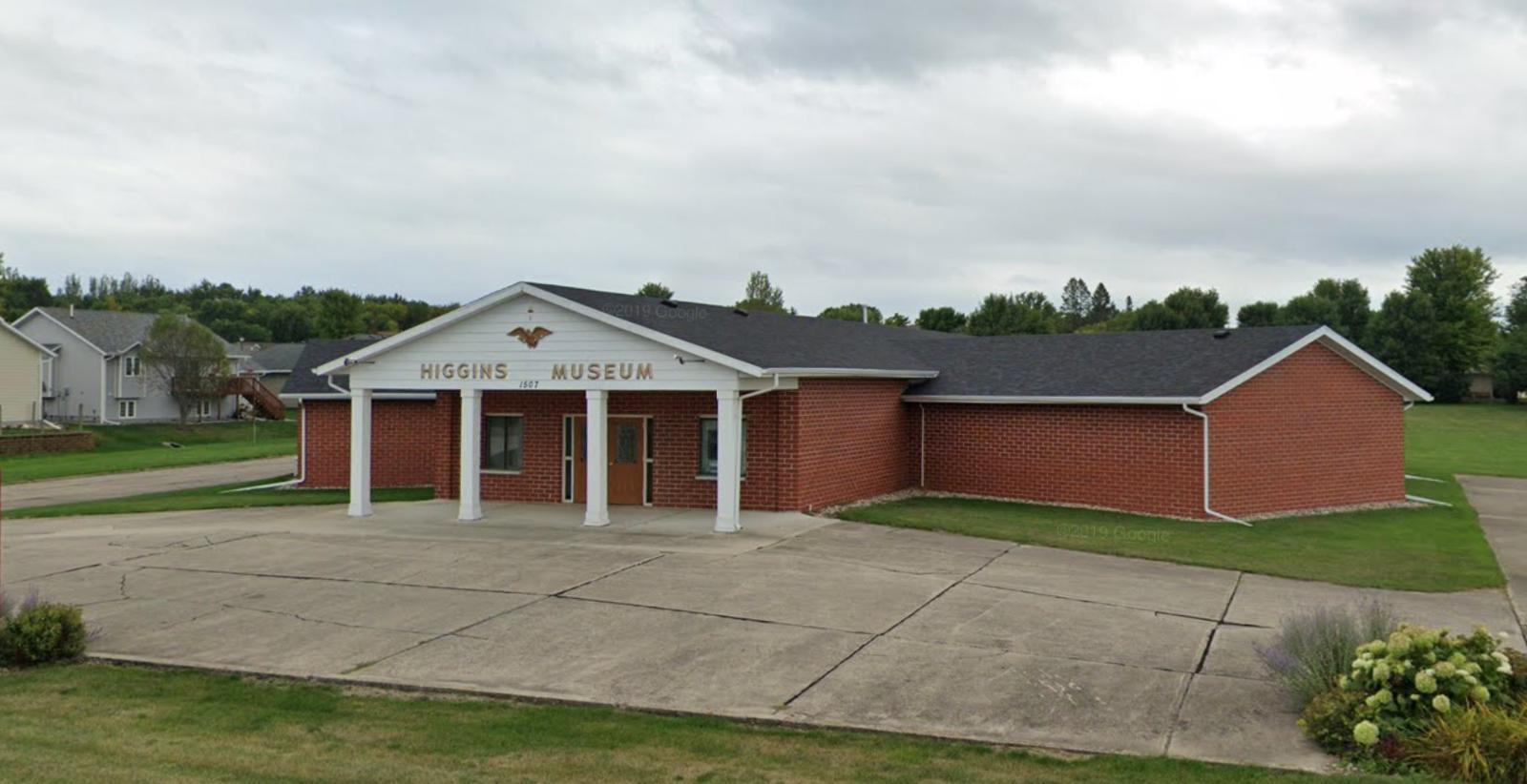
Why are people willing to pay so much to live here? What’s special about it?
Okoboji commands premium prices as Iowa’s most famous lake resort destination, offering year-round recreational opportunities on one of the state’s most beautiful natural lakes. The community attracts both vacation homeowners and retirees seeking lakefront living with boating, fishing, swimming, and winter sports activities. The area’s resort amenities, including restaurants, entertainment venues, and recreational facilities, create a unique lifestyle that justifies higher property values.
The natural beauty of the Iowa Great Lakes region, combined with a well-developed tourism infrastructure, makes Okoboji particularly attractive to affluent buyers seeking recreational properties or retirement homes. Lakefront lots command the highest prices, while even properties near the lake benefit from the area’s recreational economy and scenic setting. The combination of natural beauty, recreational opportunities, and resort amenities creates a premium market unlike anywhere else in Iowa.
How Okoboji Rose to Prominence
The Iowa Great Lakes region, including Okoboji, was formed by glacial activity during the last ice age, creating a chain of pristine natural lakes in northwest Iowa. Native American tribes used the area for seasonal hunting and fishing before European settlement began in the 1850s. The name “Okoboji” comes from a Dakota Sioux word meaning “place of rest,” reflecting the area’s natural beauty and peaceful setting.
Okoboji’s development as a premier resort destination began in the early 1900s when railroad connections made the lakes accessible to tourists from across the Midwest. Resort hotels, cottages, and recreational facilities were built to serve visitors drawn to the clear waters and natural beauty. Over the decades, Okoboji evolved from a seasonal resort community to a year-round destination offering both vacation homes and permanent residences, with the recreational economy supporting premium property values that reflect the area’s unique lifestyle amenities.
3 Interesting Tidbits
- Blue Water Lakes – West Okoboji and Spirit Lake are among Iowa’s few natural blue water lakes, created by glacial activity and maintained by natural springs that support clear, deep water ideal for recreation.
- Summer Resort Legacy – Historic resorts and cottages dating to the early 1900s maintain the area’s tradition as the Midwest’s premier lake destination, attracting families for generations.
- Year-Round Recreation – Unlike many lake communities, Okoboji offers four-season recreation including ice fishing, snowmobiling, and winter festivals that support year-round economic activity and property values.
17. Toddville – 67% Home Price Increase Since 2015
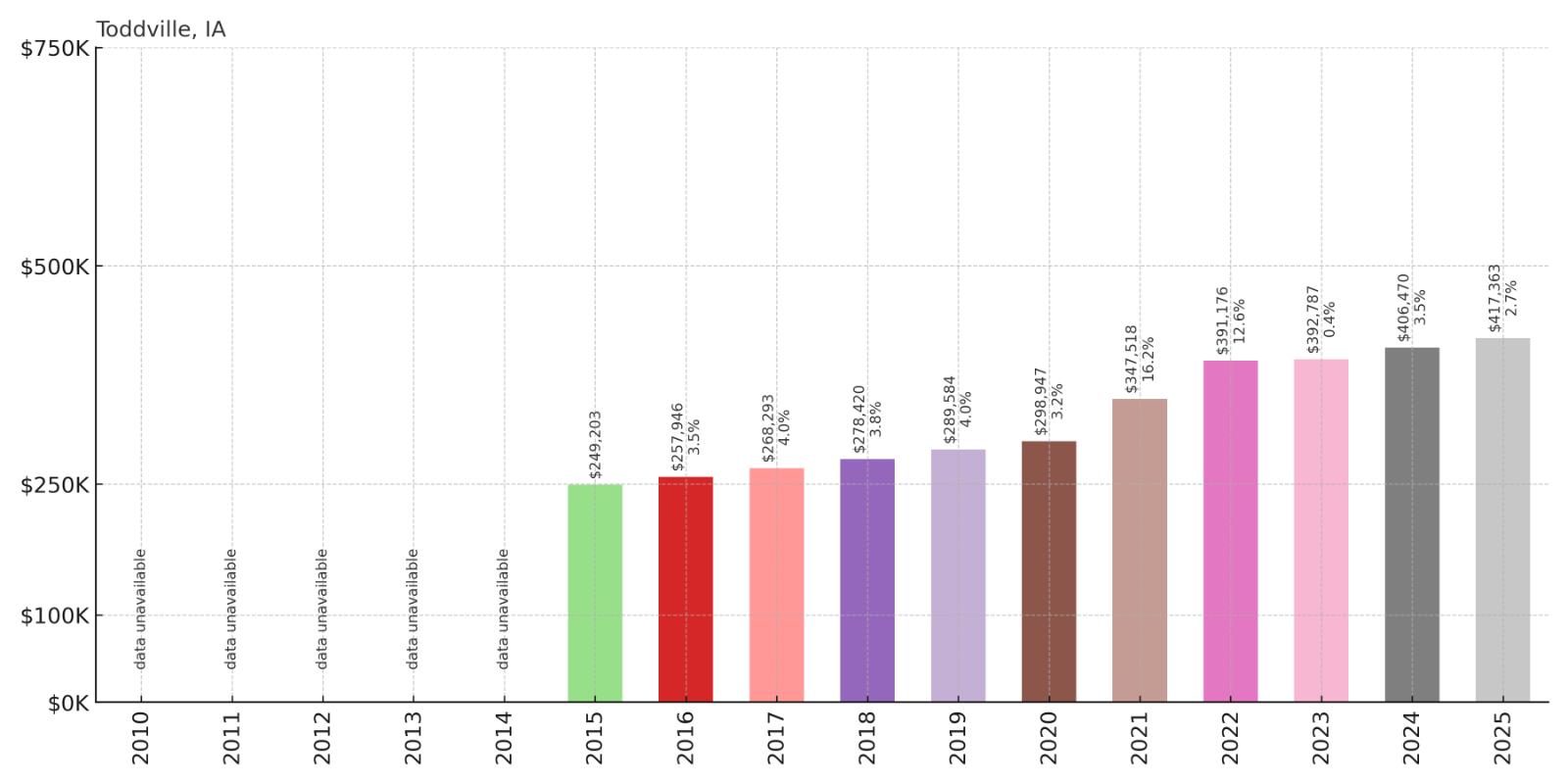
- 2010: N/A
- 2011: N/A
- 2012: N/A
- 2013: N/A
- 2014: N/A
- 2015: $249,203
- 2016: $257,946
- 2017: $268,293
- 2018: $278,420
- 2019: $289,584
- 2020: $298,947
- 2021: $347,518
- 2022: $391,176
- 2023: $392,787
- 2024: $406,470
- 2025: $417,363
Toddville has experienced strong 67% growth since 2015 when data first became available, climbing from $249,203 to $417,363 today. The community showed steady appreciation through 2020, then accelerated significantly during 2021-2022 when values jumped from $347,518 to $391,176. This growth pattern reflects increasing demand for this Cedar Rapids area suburban community.
Why Toddville?
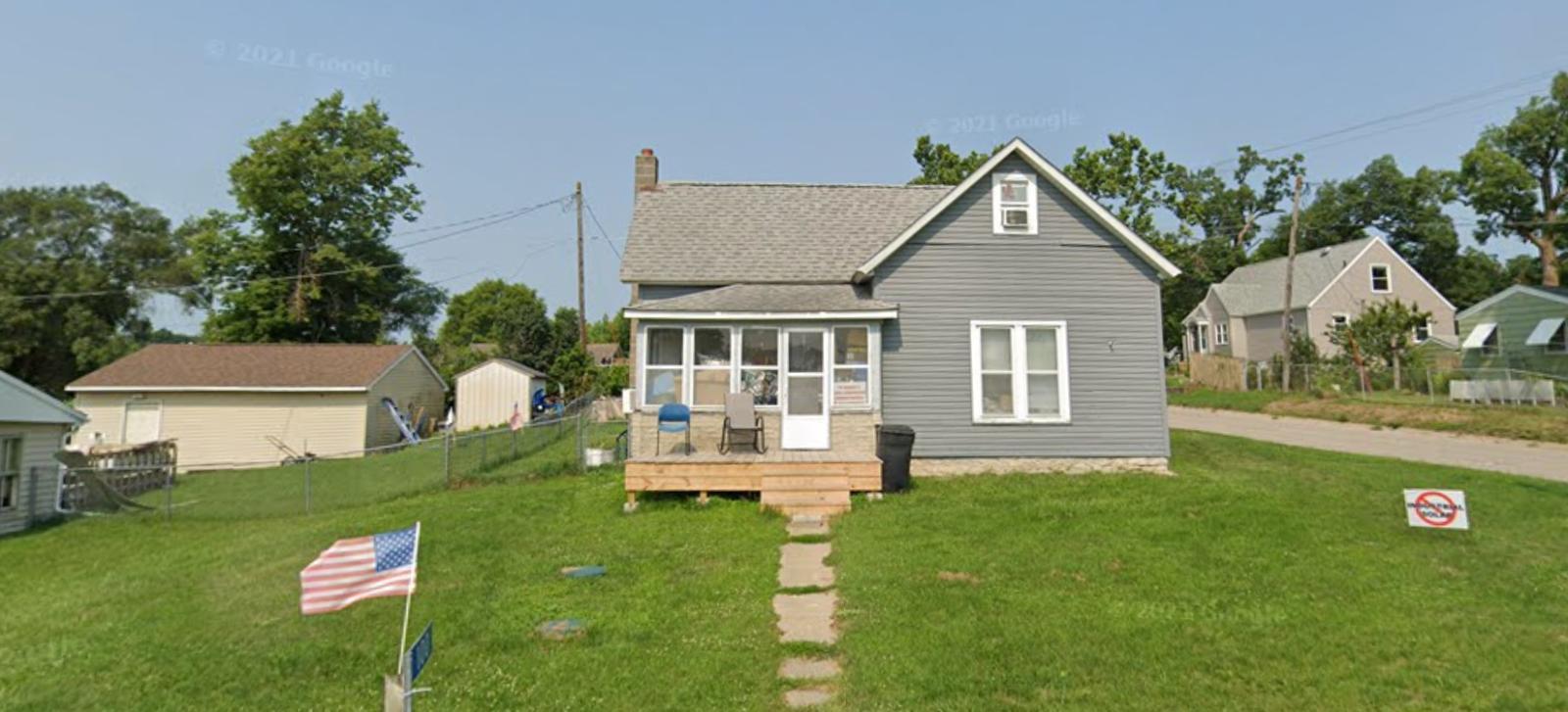
Why are people willing to pay so much to live here? What’s special about it?
Toddville attracts families seeking suburban living within the highly regarded Linn-Mar school district while maintaining easy access to Cedar Rapids employment centers. The community offers newer housing developments with larger lots and modern amenities while preserving small-town character and rural views. Families particularly value the excellent schools, low crime rates, and family-friendly atmosphere that small communities provide.
The area’s rolling countryside setting provides an appealing backdrop for residential development, with many properties offering rural views and larger lots than typical suburban communities. Convenient access to Cedar Rapids and Iowa City makes Toddville attractive to professionals seeking quality schools and small-town living with reasonable commuting times. The combination of excellent schools, rural character, and suburban conveniences creates strong appeal for growing families.
How Toddville Rose to Prominence
Toddville began as a small agricultural community in Linn County during the late 1800s, named after early settler families who established farms throughout the area. The community remained rural and sparsely populated through most of the 20th century, with farming operations and scattered rural residences characterizing the landscape. The area’s proximity to Cedar Rapids positioned it for eventual suburban development as the city expanded eastward.
The transformation to a residential community began in the 1990s as developers recognized the area’s potential within excellent school district boundaries. The Linn-Mar school district’s growing reputation for academic excellence became a major attraction, while the rural setting offered opportunities for larger lots and custom homes. Toddville’s development represents successful suburban expansion that maintains rural character while providing modern amenities and convenient access to urban employment centers.
3 Interesting Tidbits
- Agricultural Roots – Many Toddville properties were once part of working farms, and the community maintains agricultural character with open spaces and rural views that distinguish it from typical suburban developments.
- School District Magnet – Location within Linn-Mar school district boundaries makes Toddville extremely attractive to families, as the district consistently ranks among Iowa’s top academic performers.
- Custom Home Haven – The community’s larger lots and rural setting attract custom home builders and buyers seeking unique properties with country views while maintaining suburban conveniences.
16. Van Meter – 96% Home Price Increase Since 2010
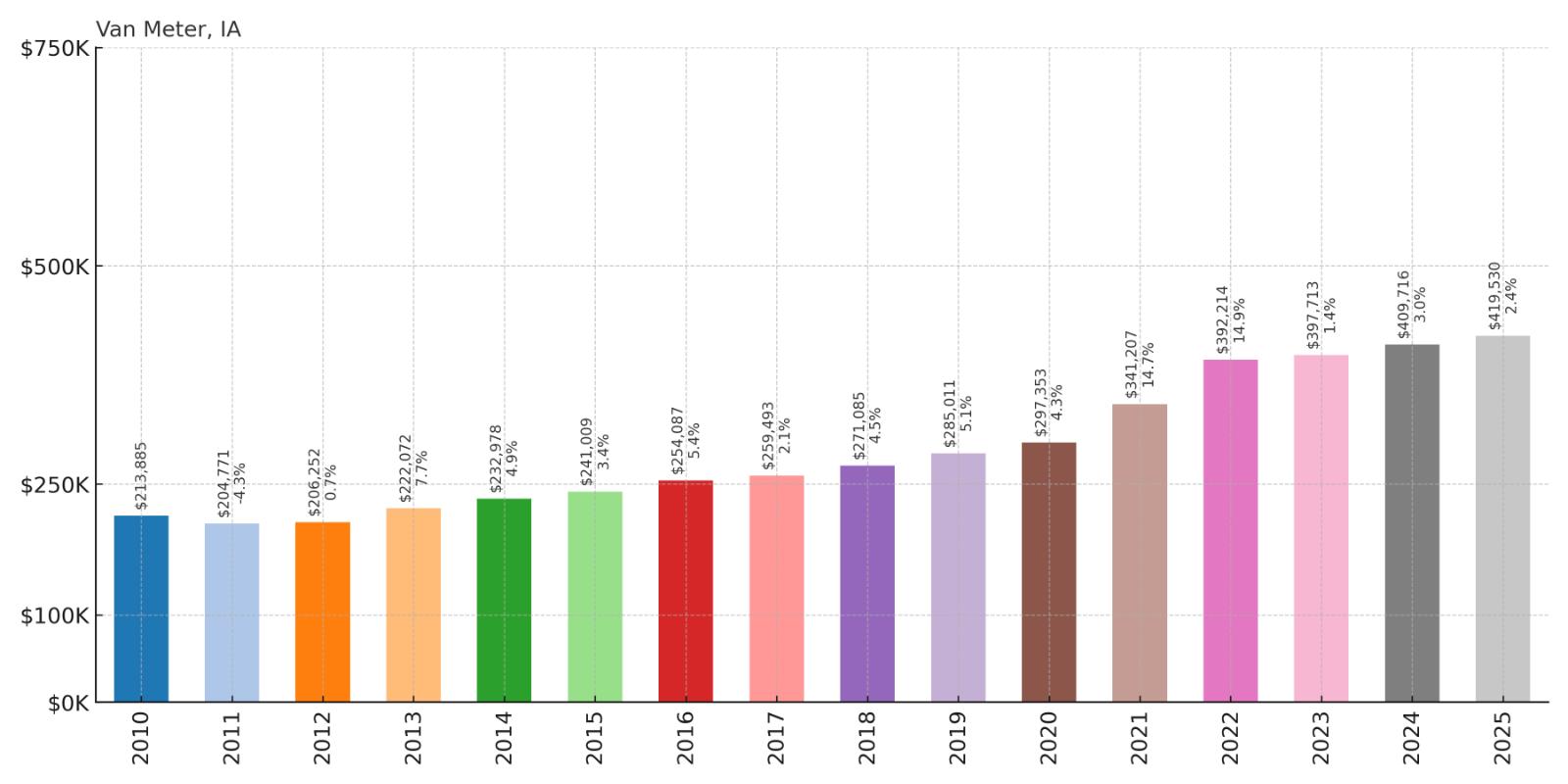
- 2010: $213,885
- 2011: $204,771
- 2012: $206,252
- 2013: $222,072
- 2014: $232,978
- 2015: $241,009
- 2016: $254,087
- 2017: $259,493
- 2018: $271,085
- 2019: $285,011
- 2020: $297,353
- 2021: $341,207
- 2022: $392,214
- 2023: $397,713
- 2024: $409,716
- 2025: $419,530
Van Meter has achieved impressive 96% growth since 2010, nearly doubling from $213,885 to $419,530 today. After initial declines during the early 2010s recession, the community experienced steady appreciation that accelerated dramatically during 2021-2022 when values jumped from $341,207 to $392,214. This growth reflects Van Meter’s increasing appeal as a Des Moines area suburb.
Why Van Meter?
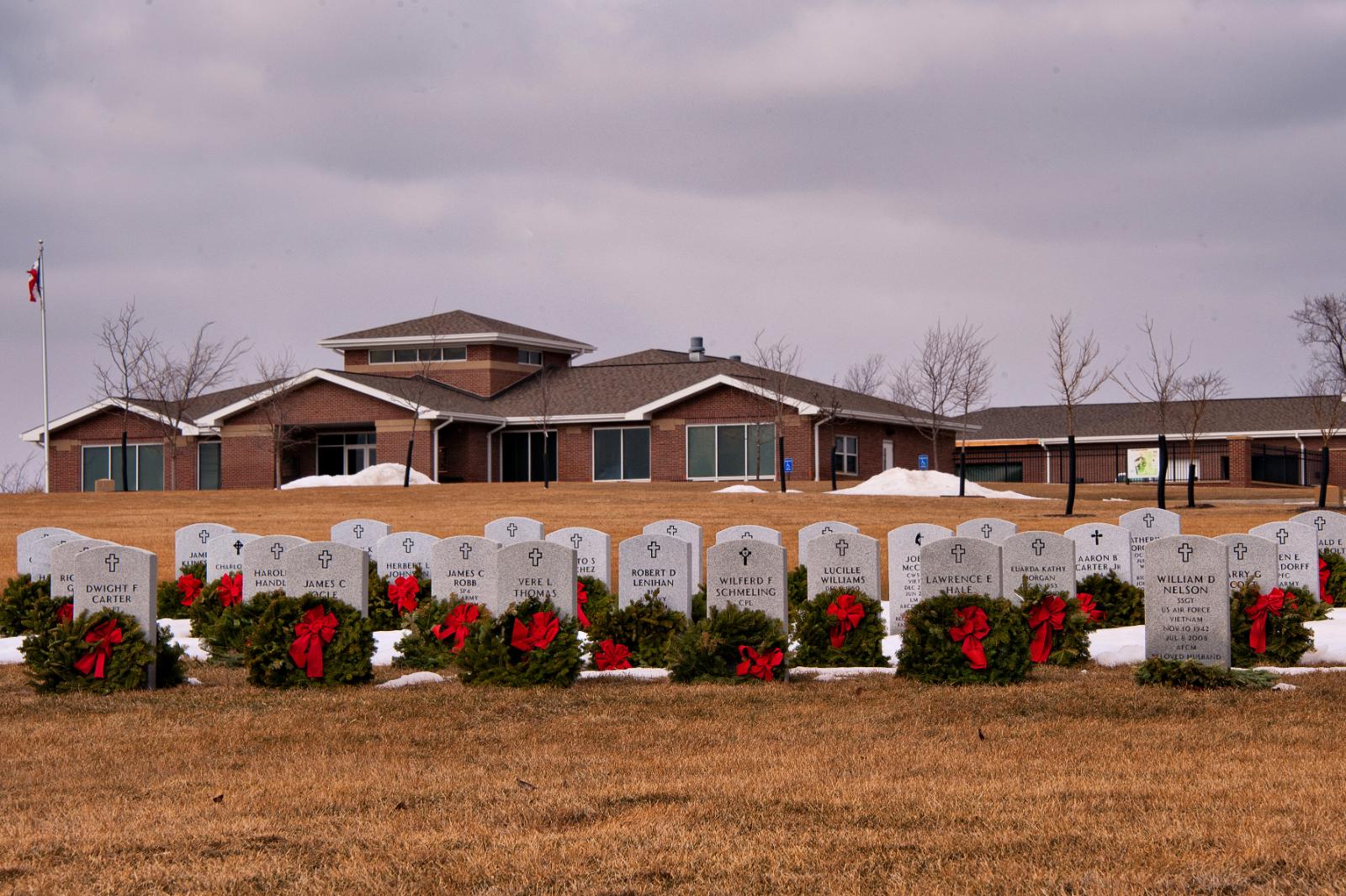
Why are people willing to pay so much to live here? What’s special about it?
Van Meter attracts families seeking small-town living within the excellent Van Meter Community School District while maintaining convenient access to Des Moines employment centers. The community offers authentic small-town character with strong local businesses, community events, and neighborly atmosphere that appeals to families wanting to escape suburban density. Low crime rates and excellent schools create a safe, nurturing environment for children.
The area’s agricultural heritage blends with modern residential developments, offering both historic homes and newer construction on larger lots. Community pride runs deep, with local events like the annual Van Meter Days celebration bringing residents together and maintaining the town’s family-friendly reputation. The combination of quality schools, community spirit, and reasonable commuting access makes Van Meter particularly attractive to young families and professionals seeking authentic Iowa living.
How Van Meter Rose to Prominence
Van Meter was founded in 1879 and named after a local landowner, developing as an agricultural community along the Chicago, Rock Island and Pacific Railroad. The town served as a shipping point for local grain and livestock, with businesses and services supporting surrounding farming operations. Throughout the early 20th century, Van Meter remained a small but vital agricultural hub in Dallas County.
The community’s evolution into a sought-after residential destination began in the 1990s as Des Moines’ metropolitan area expanded westward and families sought communities with excellent schools and small-town character. The Van Meter Community School District’s strong academic reputation became a major draw, while the town’s preservation of its historic downtown and community traditions attracted residents seeking authentic Iowa small-town living. This combination of educational quality, community spirit, and convenient location drove steady growth and property appreciation.
3 Interesting Tidbits
- Athletic Excellence – Van Meter High School’s sports programs, particularly football, have achieved remarkable success including multiple state championships, creating strong community pride and school district appeal.
- Historic Downtown – The preserved downtown district maintains original buildings and local businesses that create authentic small-town character while supporting modern economic development.
- Community Celebrations – Annual events like Van Meter Days and homecoming celebrations bring residents together and maintain the tight-knit community atmosphere that attracts families seeking small-town values.
15. Peosta – 85% Home Price Increase Since 2010
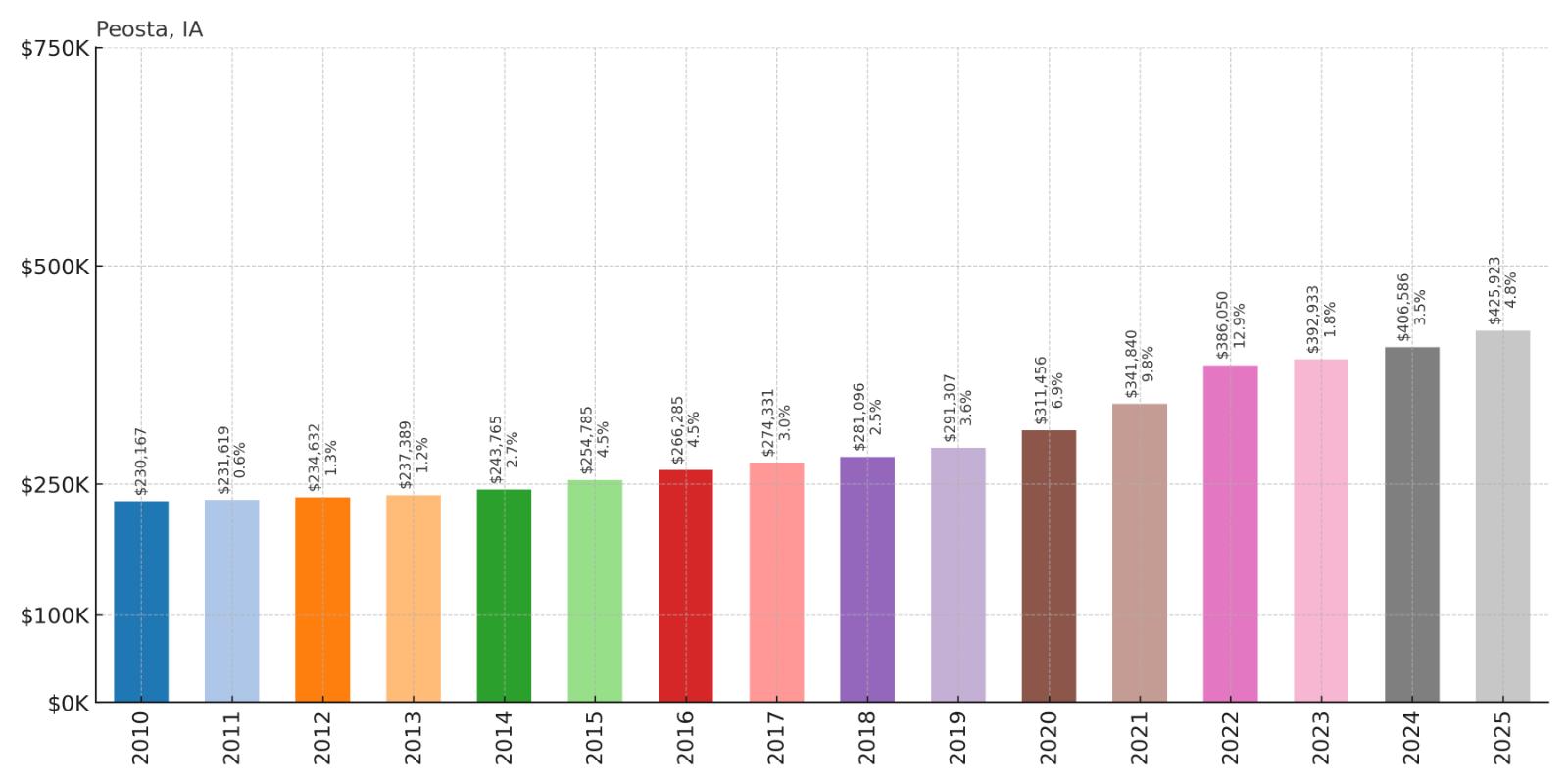
- 2010: $230,167
- 2011: $231,619
- 2012: $234,632
- 2013: $237,389
- 2014: $243,765
- 2015: $254,785
- 2016: $266,285
- 2017: $274,331
- 2018: $281,096
- 2019: $291,307
- 2020: $311,456
- 2021: $341,840
- 2022: $386,050
- 2023: $392,933
- 2024: $406,586
- 2025: $425,923
Peosta demonstrates solid 85% growth since 2010, with steady appreciation from $230,167 to $425,923 today. The community showed consistent but moderate gains through 2020, then accelerated during 2021-2022 when values jumped from $341,840 to $386,050. This growth pattern reflects Peosta’s established appeal as a Dubuque area suburban community with rural character.
Why Peosta?
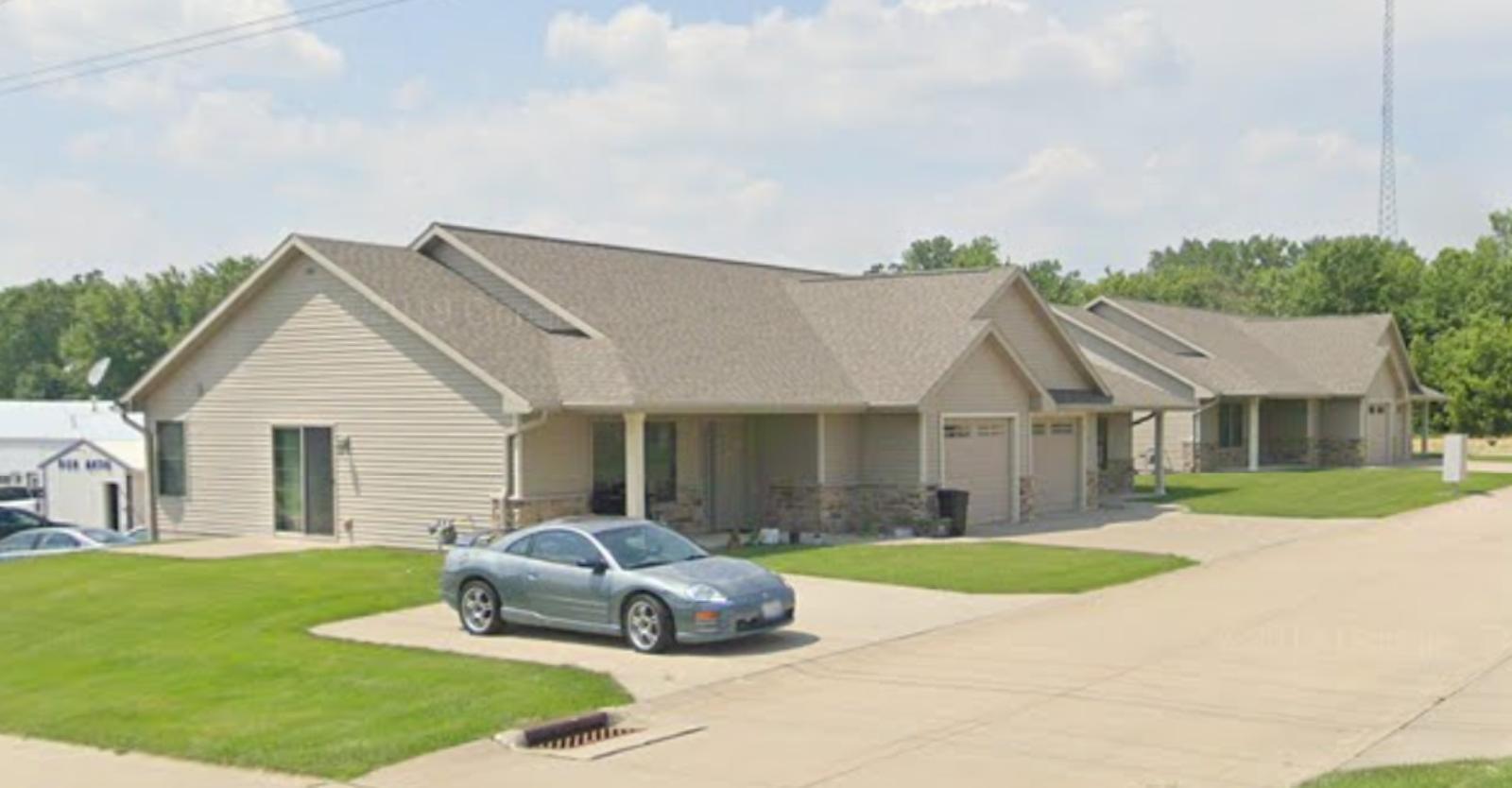
Why are people willing to pay so much to live here? What’s special about it?
Peosta attracts families seeking suburban amenities within the highly regarded Western Dubuque Community School District while maintaining small-town character and scenic countryside views. The community offers newer housing developments with larger lots and modern amenities while preserving agricultural heritage and natural beauty. Families particularly value the excellent schools, low crime rates, and safe neighborhoods that create ideal conditions for raising children.
The area’s rolling hills and rural setting provide an appealing backdrop for residential development, with many properties offering country views and spacious lots. Convenient access to Dubuque’s employment centers and amenities makes Peosta attractive to professionals seeking quality schools and rural living with reasonable commuting times. The combination of excellent education, natural beauty, and suburban conveniences creates strong demand among discerning homebuyers.
How Peosta Rose to Prominence
Peosta began as a small farming community in Dubuque County during the mid-1800s, with German and Irish immigrants establishing homesteads throughout the rolling countryside. The community was named after a Native American chief and remained primarily agricultural through most of the 20th century, known for its fertile farmland and scattered rural residences. The area’s proximity to Dubuque positioned it for eventual suburban development.
The transformation to a sought-after residential community began in the 1980s as Dubuque’s metropolitan area expanded westward and developers recognized the area’s potential. The Western Dubuque Community School District’s excellent reputation became a major attraction, while the scenic countryside offered opportunities for upscale housing developments. Peosta’s careful growth management and preservation of rural character while providing modern amenities created one of eastern Iowa’s most desirable suburban communities.
3 Interesting Tidbits
- Native American Heritage – The community name honors Chief Peosta, a Fox tribe leader who lived in the area during the early 1800s, reflecting the region’s Native American history.
- Golf Course Community – The Meadows Golf Club serves as a centerpiece for residential development, with several upscale neighborhoods built around the course and its amenities.
- School District Excellence – Western Dubuque Community School District consistently ranks among Iowa’s top academic performers, making Peosta a magnet for education-focused families throughout eastern Iowa.
14. Polk City – 104% Home Price Increase Since 2010
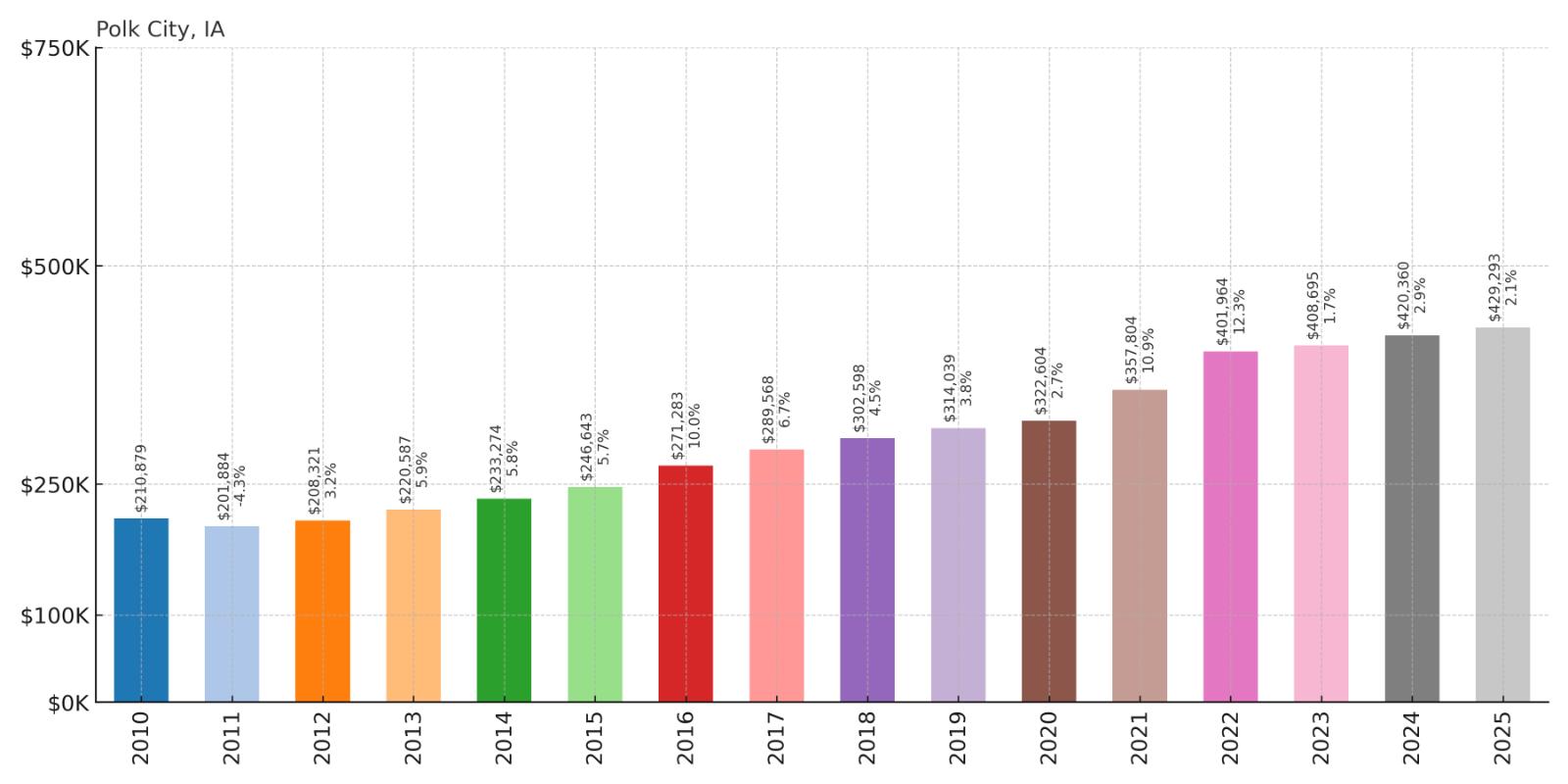
- 2010: $210,879
- 2011: $201,884
- 2012: $208,321
- 2013: $220,587
- 2014: $233,274
- 2015: $246,643
- 2016: $271,283
- 2017: $289,568
- 2018: $302,598
- 2019: $314,039
- 2020: $322,604
- 2021: $357,804
- 2022: $401,964
- 2023: $408,695
- 2024: $420,360
- 2025: $429,293
Polk City shows exceptional 104% growth since 2010, more than doubling from $210,879 to $429,293 today. The community experienced steady acceleration throughout the period, with particularly strong gains during 2016-2018 and again during 2021-2022. This consistent growth reflects Polk City’s increasing popularity as both a recreational destination and residential community.
Why Polk City?

Why are people willing to pay so much to live here? What’s special about it?
Polk City commands premium prices due to its unique combination of recreational lake living and convenient Des Moines area access. Big Creek Lake offers boating, fishing, swimming, and water sports that create resort-style living just minutes from urban employment centers. Many properties feature lake views or direct water access, while the area’s state park and recreational facilities provide year-round outdoor activities that justify premium home values.
The community attracts both permanent residents and vacation homeowners seeking waterfront lifestyle with suburban conveniences. Excellent schools, low crime rates, and well-maintained infrastructure create ideal conditions for families, while the recreational economy supports local businesses and services. The combination of natural beauty, recreational opportunities, and reasonable commuting access makes Polk City particularly attractive to affluent buyers seeking unique lifestyle amenities.
How Polk City Rose to Prominence
Polk City was established in 1907 as a coal mining community, with underground mining operations employing hundreds of workers through the mid-20th century. The town developed around the mining industry, with company housing and businesses serving mining families. When coal mining declined, Polk City faced economic challenges and population loss, leading to a search for new economic opportunities and community identity.
The community’s renaissance began in the 1970s with the creation of Big Creek Lake and Big Creek State Park, transforming Polk City from a declining industrial town into a recreational destination. The lake attracted new residents and visitors, spurring residential development and recreational businesses. This transformation from coal mining to recreational tourism created a unique community that combines small-town character with resort-style amenities, driving steady property appreciation and attracting diverse demographics seeking lake living with urban access.
3 Interesting Tidbits
- Coal Mining Legacy – Historic mining sites and the annual Coal Mining Days celebration commemorate Polk City’s industrial heritage and the community’s successful transition to recreational tourism.
- Big Creek Lake – The 866-acre lake created in the 1970s transformed Polk City’s economy and identity, making it central Iowa’s premier lake community for recreation and residential development.
- State Park Setting – Big Creek State Park surrounds the community with hiking trails, camping facilities, and natural areas that provide resort-quality amenities and support property values.
13. Clive – 73% Home Price Increase Since 2010
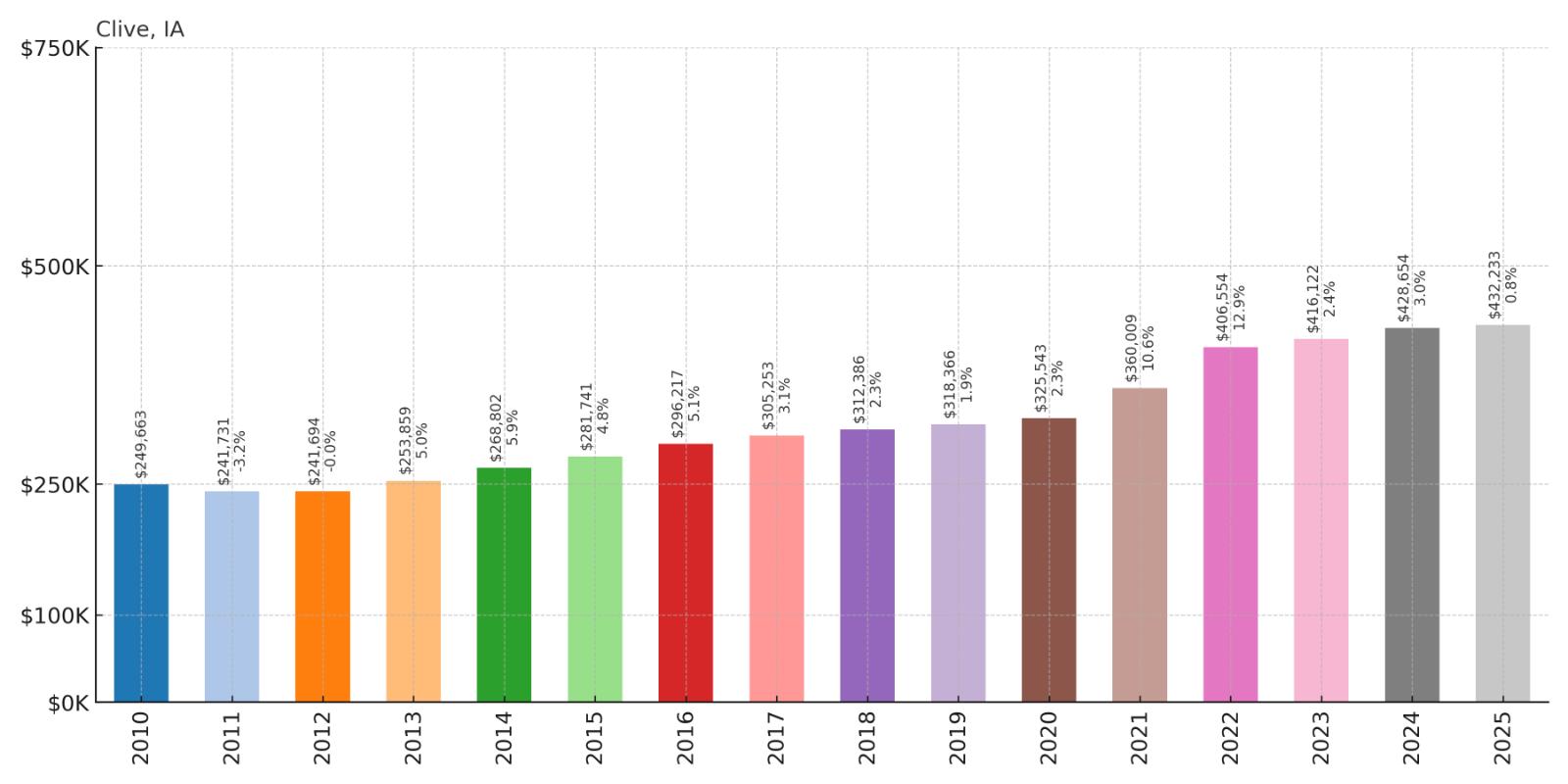
- 2010: $249,663
- 2011: $241,731
- 2012: $241,694
- 2013: $253,859
- 2014: $268,802
- 2015: $281,741
- 2016: $296,217
- 2017: $305,253
- 2018: $312,386
- 2019: $318,366
- 2020: $325,543
- 2021: $360,009
- 2022: $406,554
- 2023: $416,122
- 2024: $428,654
- 2025: $432,233
Clive demonstrates steady 73% growth since 2010, starting from a higher baseline of $249,663 and reaching $432,233 today. The community showed consistent appreciation through 2020, then accelerated during 2021-2022 when values jumped from $360,009 to $406,554. This growth pattern reflects Clive’s established reputation as one of Iowa’s most desirable suburban communities.
Why Clive?
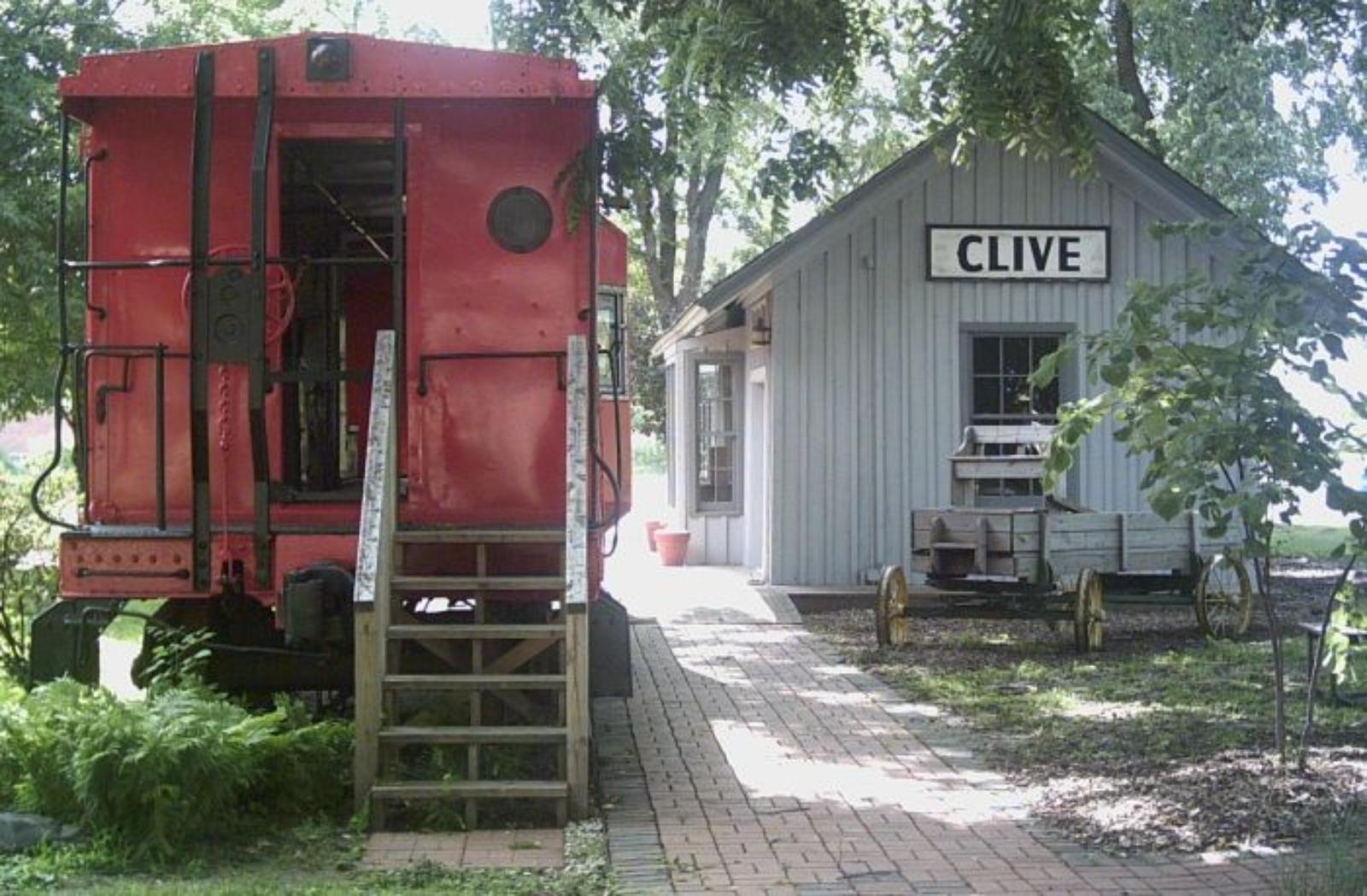
Why are people willing to pay so much to live here? What’s special about it?
Clive ranks among Iowa’s premier suburban communities due to its combination of upscale housing, excellent schools, and convenient Des Moines access. The West Des Moines Community School District consistently ranks among the state’s top performers, attracting families willing to pay premium prices for educational excellence. The community features well-planned neighborhoods, abundant parks and recreational facilities, and a thriving business district that creates resort-quality amenities.
Professional families particularly value Clive’s blend of suburban sophistication and family-friendly atmosphere, with excellent municipal services, low crime rates, and active recreational programs. The community’s strategic location provides easy access to major employers while maintaining residential tranquility. This reputation for quality of life, combined with continued investment in infrastructure and amenities, supports strong property values and consistent demand from affluent homebuyers.
How Clive Rose to Prominence
Clive began as a small railroad community in the 1880s along the Chicago, Rock Island and Pacific Railroad, initially serving surrounding agricultural operations. The community was named after a railroad official and remained a modest farming town through much of the 20th century. The area’s proximity to Des Moines and West Des Moines positioned it for eventual suburban development as the metropolitan area expanded westward.
The transformation to a premier suburban community began in the 1960s and accelerated through subsequent decades as developers recognized Clive’s potential for upscale residential development. The community’s strategic planning, emphasis on quality development, and investment in schools and parks created one of Iowa’s most successful suburban communities. Clive’s incorporation in 1956 and subsequent growth attracted affluent families seeking top-tier schools, excellent amenities, and convenient access to Des Moines employment centers.
3 Interesting Tidbits
- Corporate Campus – Major companies including Wells Fargo and other Fortune 500 firms have located significant operations in Clive, creating high-paying jobs and attracting professional residents.
- Greenbelt Network – Clive’s extensive trail system and green spaces connect neighborhoods while providing recreational amenities that enhance quality of life and property values.
- Cultural Amenities – The Clive Aquatic Center and other premium recreational facilities provide resort-quality amenities that distinguish the community from typical suburban developments.
12. Runnells – 112% Home Price Increase Since 2010
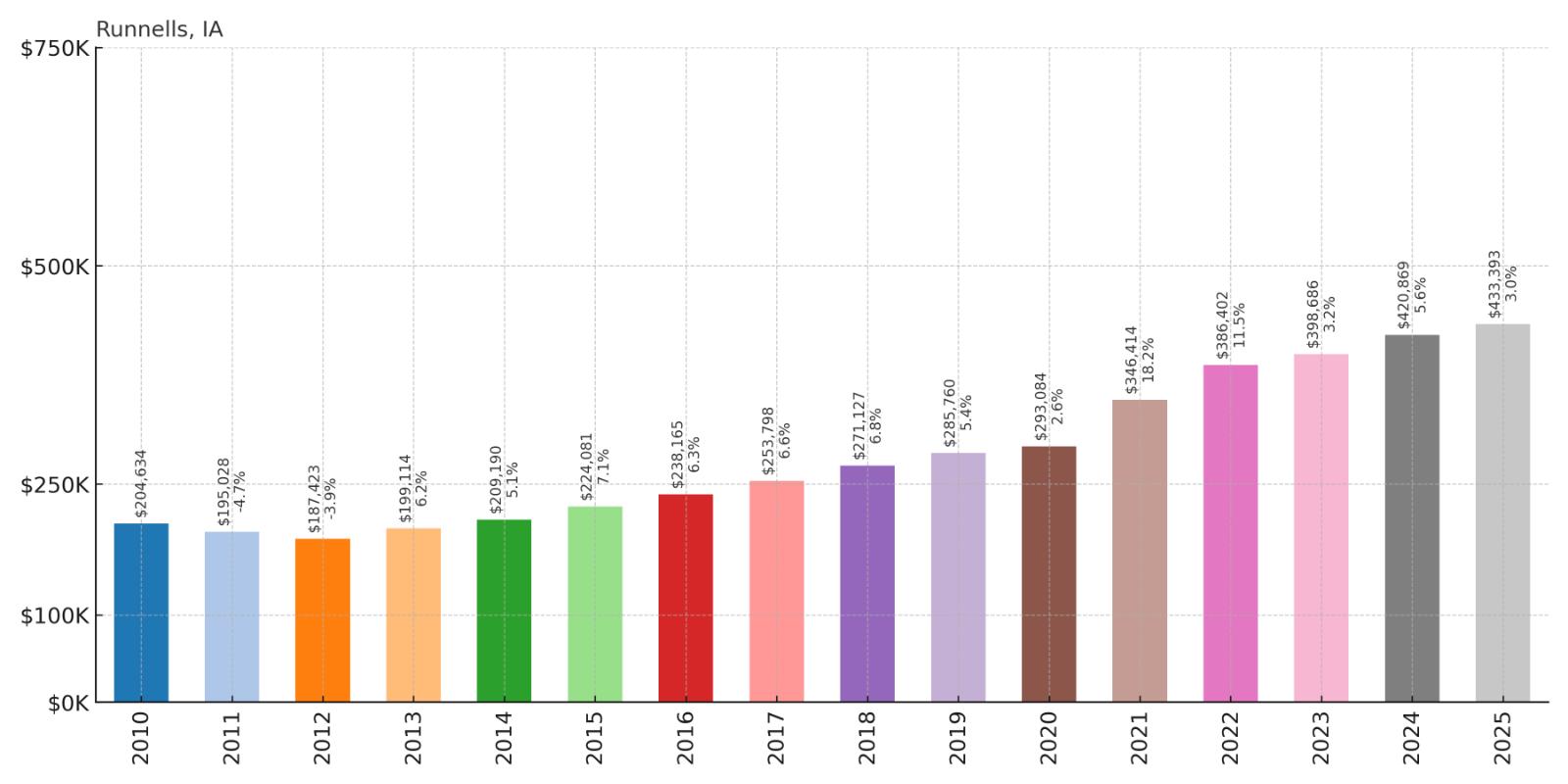
- 2010: $204,634
- 2011: $195,028
- 2012: $187,423
- 2013: $199,114
- 2014: $209,190
- 2015: $224,081
- 2016: $238,165
- 2017: $253,798
- 2018: $271,127
- 2019: $285,760
- 2020: $293,084
- 2021: $346,414
- 2022: $386,402
- 2023: $398,686
- 2024: $420,869
- 2025: $433,393
Runnells shows remarkable 112% growth since 2010, more than doubling from $204,634 to $433,393 today. After significant declines during the early 2010s recession, the community experienced steady recovery and then explosive growth from 2015 onward. The most dramatic appreciation occurred during 2021 when values jumped from $293,084 to $346,414, reflecting intense demand for this Des Moines area community.
Why Runnells?
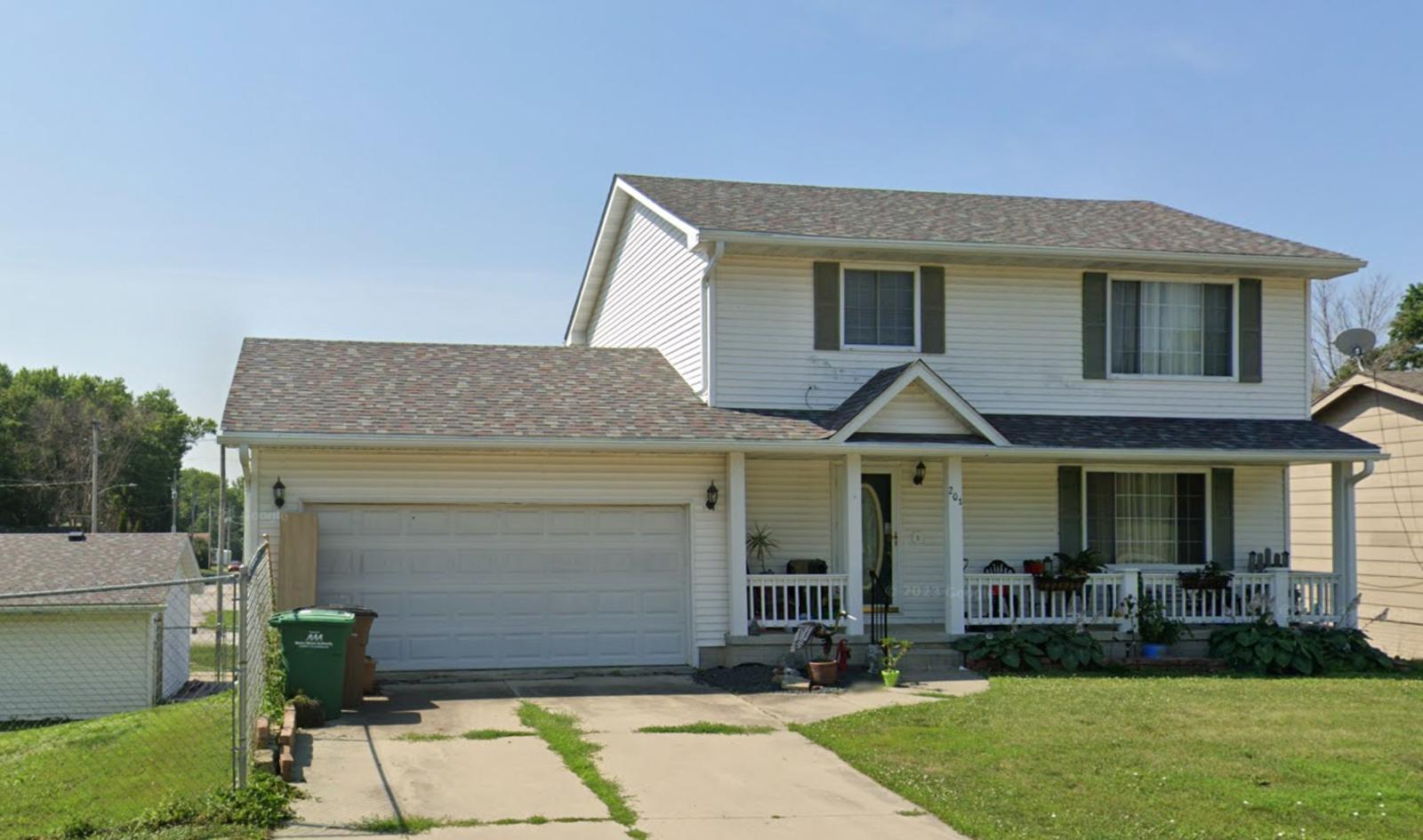
Why are people willing to pay so much to live here? What’s special about it?
Runnells attracts families seeking small-town living within excellent school district boundaries while maintaining convenient access to Des Moines employment centers. The community offers authentic rural character with larger lots, newer housing developments, and agricultural heritage that appeals to those wanting to escape suburban density. Low crime rates and tight-knit community atmosphere create ideal conditions for raising families.
The area’s scenic countryside setting provides space for custom homes and rural lifestyle while maintaining reasonable commuting distance to urban amenities and employment. Community events and local businesses foster the neighborly connections that many suburban developments lack. The combination of rural charm, convenient location, and strong schools makes Runnells particularly attractive to professionals seeking authentic Iowa small-town living.
How Runnells Rose to Prominence
Runnells was established in the 1880s as an agricultural community in Polk County, named after an early settler family who farmed in the area. The town developed around grain elevators and businesses serving surrounding farming operations, remaining a small rural community through most of the 20th century. The area’s rich soil and agricultural heritage created a foundation of farming families and rural businesses.
The community’s transformation into a sought-after residential destination began in the 1990s as Des Moines’ metropolitan area expanded and families sought communities with rural character and excellent schools. The Southeast Polk Community School District’s growing reputation attracted homebuyers, while the area’s agricultural setting offered opportunities for larger lots and custom homes. This combination of educational quality, rural beauty, and convenient location drove steady growth and dramatic property appreciation.
3 Interesting Tidbits
- Agricultural Heritage – Working farms continue to operate in and around Runnells, providing authentic rural character while supporting local businesses and maintaining the community’s farming identity.
- School District Growth – The Southeast Polk Community School District has expanded rapidly to serve growing communities like Runnells, investing in new facilities and programs that attract education-focused families.
- Rural Development – Runnells represents successful rural residential development that preserves agricultural character while providing modern amenities and suburban conveniences.
11. Ackworth – 50% Home Price Increase Since 2019
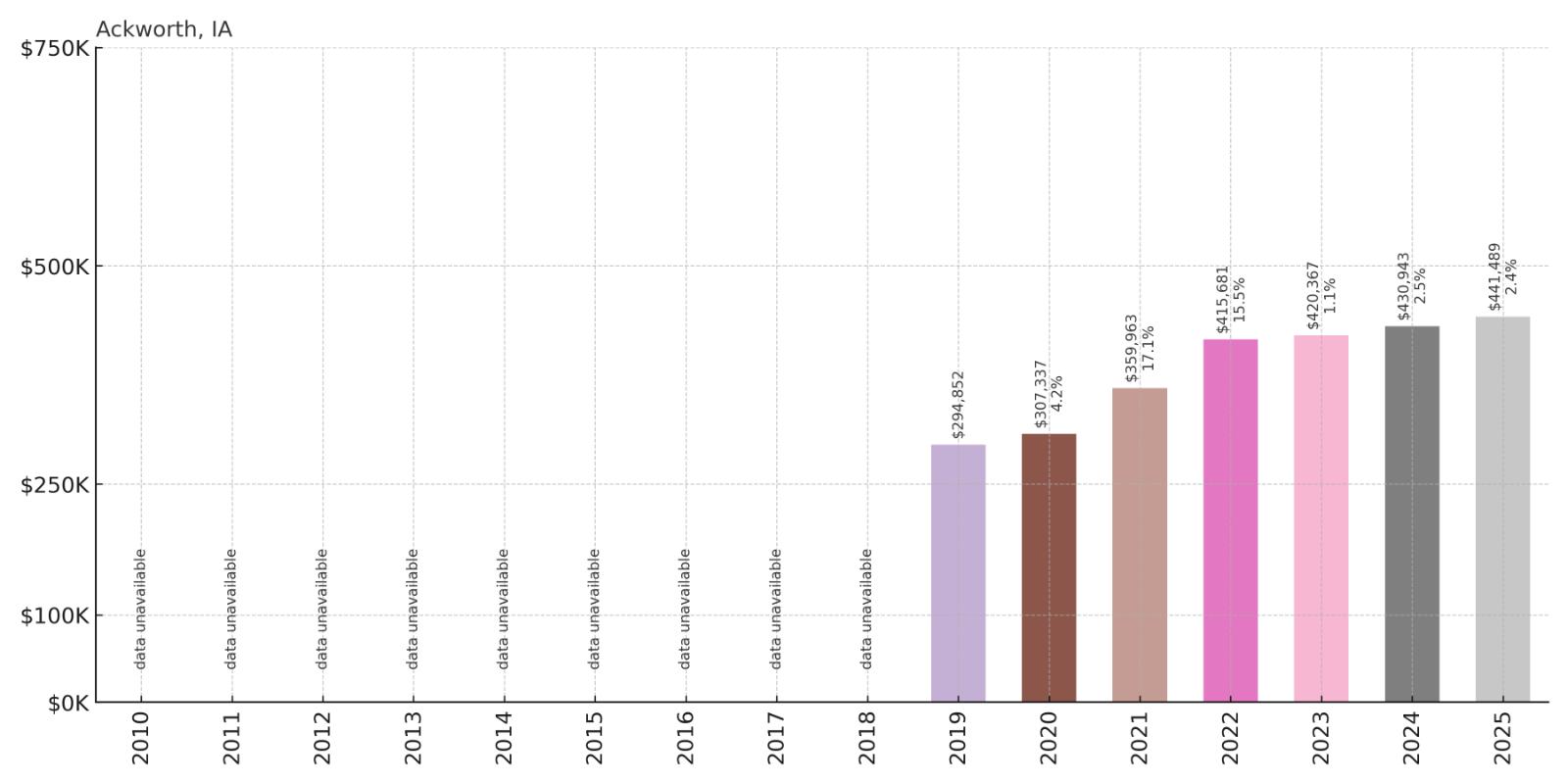
- 2010: N/A
- 2011: N/A
- 2012: N/A
- 2013: N/A
- 2014: N/A
- 2015: N/A
- 2016: N/A
- 2017: N/A
- 2018: N/A
- 2019: $294,852
- 2020: $307,337
- 2021: $359,963
- 2022: $415,681
- 2023: $420,367
- 2024: $430,943
- 2025: $441,489
Ackworth shows impressive 50% growth since 2019 when data first became available, climbing from $294,852 to $441,489 today. The community experienced particularly strong appreciation during 2021-2022 when values jumped from $359,963 to $415,681. This rapid growth reflects increasing demand for this south Des Moines area community despite limited historical data.
Why Ackworth?
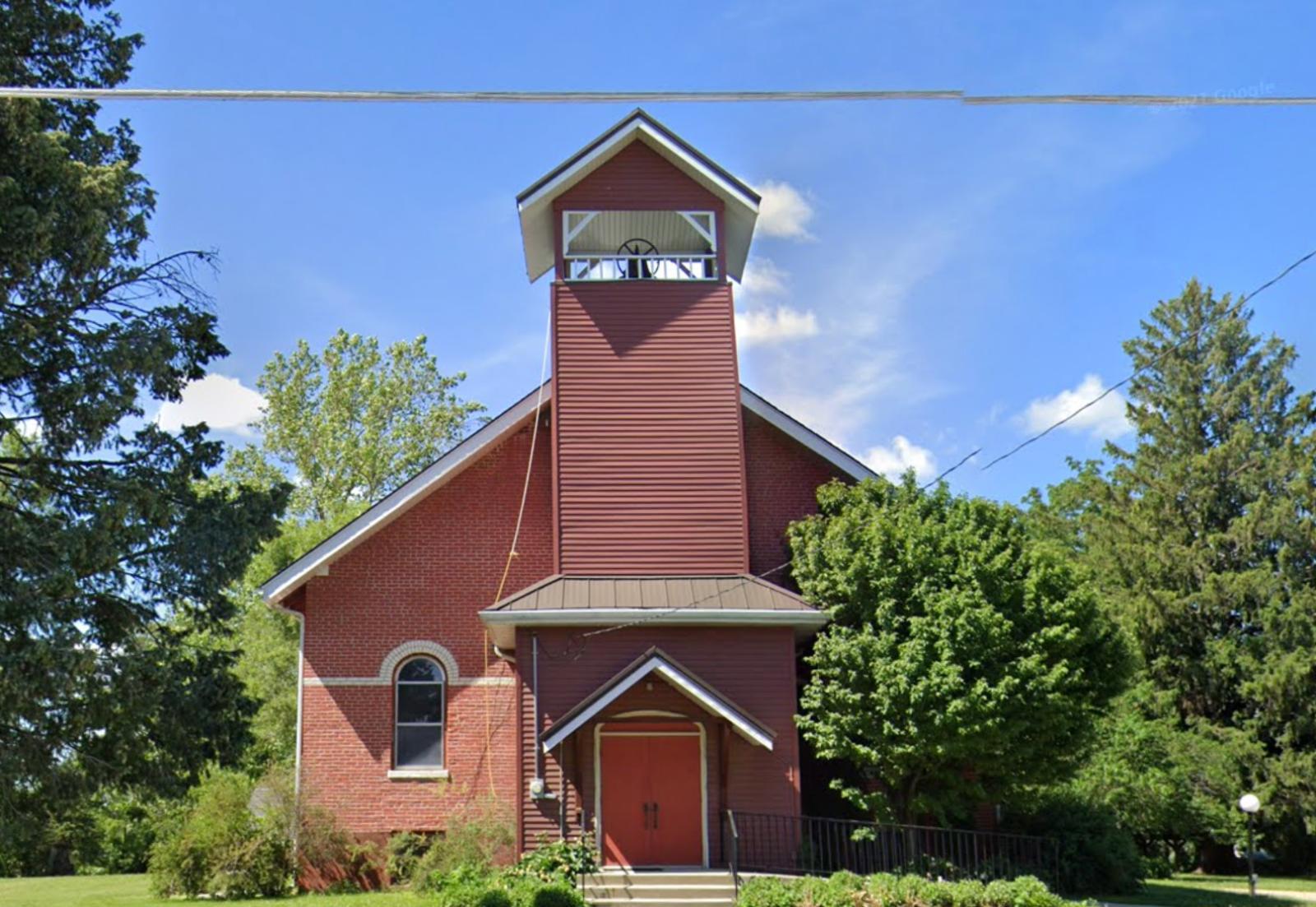
Why are people willing to pay so much to live here? What’s special about it?
Ackworth attracts families seeking rural lifestyle within the excellent Southeast Polk Community School District while maintaining reasonable access to Des Moines employment centers. The small farming community offers authentic agricultural character with larger lots, custom building opportunities, and genuine small-town atmosphere that appeals to those wanting to escape suburban development patterns. Low crime rates and community spirit create ideal conditions for family life.
The area’s agricultural heritage and scenic countryside provide space for rural residential development while maintaining farming operations and natural beauty. Community events and local businesses foster the neighborly connections that distinguish small towns from suburban developments. The combination of excellent schools, rural character, and convenient location makes Ackworth particularly attractive to families seeking authentic Iowa country living with modern conveniences.
How Ackworth Rose to Prominence
Ackworth was founded in the 1880s as a coal mining and agricultural community in Warren County, named after a town in England. The community developed around coal mining operations and farming, with miners’ families and agricultural workers forming the early population. When coal mining declined in the mid-20th century, Ackworth transitioned to a purely agricultural community with farming families and rural businesses.
The community’s recent residential growth reflects broader trends toward rural living and the expansion of the Southeast Polk Community School District’s reputation for excellence. Families began discovering Ackworth as an affordable alternative to more expensive suburban communities while still providing access to top-rated schools and Des Moines area employment. The combination of rural charm, excellent education, and reasonable home prices attracted new residents seeking country living with suburban conveniences.
3 Interesting Tidbits
- Coal Mining Past – Historic mining sites around Ackworth reflect the community’s industrial heritage before its transformation to agricultural and residential use.
- English Heritage – The community name reflects early settlers’ English origins, maintaining connections to the broader immigrant heritage that shaped rural Iowa.
- School District Expansion – Ackworth’s growth coincides with Southeast Polk’s expansion and reputation growth, making it attractive to education-focused families throughout the region.
10. Arnolds Park – 136% Home Price Increase Since 2010

- 2010: $187,820
- 2011: $185,149
- 2012: $193,080
- 2013: $207,733
- 2014: $230,692
- 2015: $234,740
- 2016: $247,178
- 2017: $253,810
- 2018: $263,868
- 2019: $281,801
- 2020: $295,777
- 2021: $334,913
- 2022: $394,955
- 2023: $411,230
- 2024: $436,271
- 2025: $442,804
Arnolds Park demonstrates exceptional 136% growth since 2010, with values more than doubling from $187,820 to $442,804 today. The community showed steady appreciation through 2020, then accelerated dramatically during 2021-2022 when values jumped from $334,913 to $394,955. This growth reflects Arnolds Park’s premier position as the entertainment and recreational center of the Iowa Great Lakes region.
Why Arnolds Park?
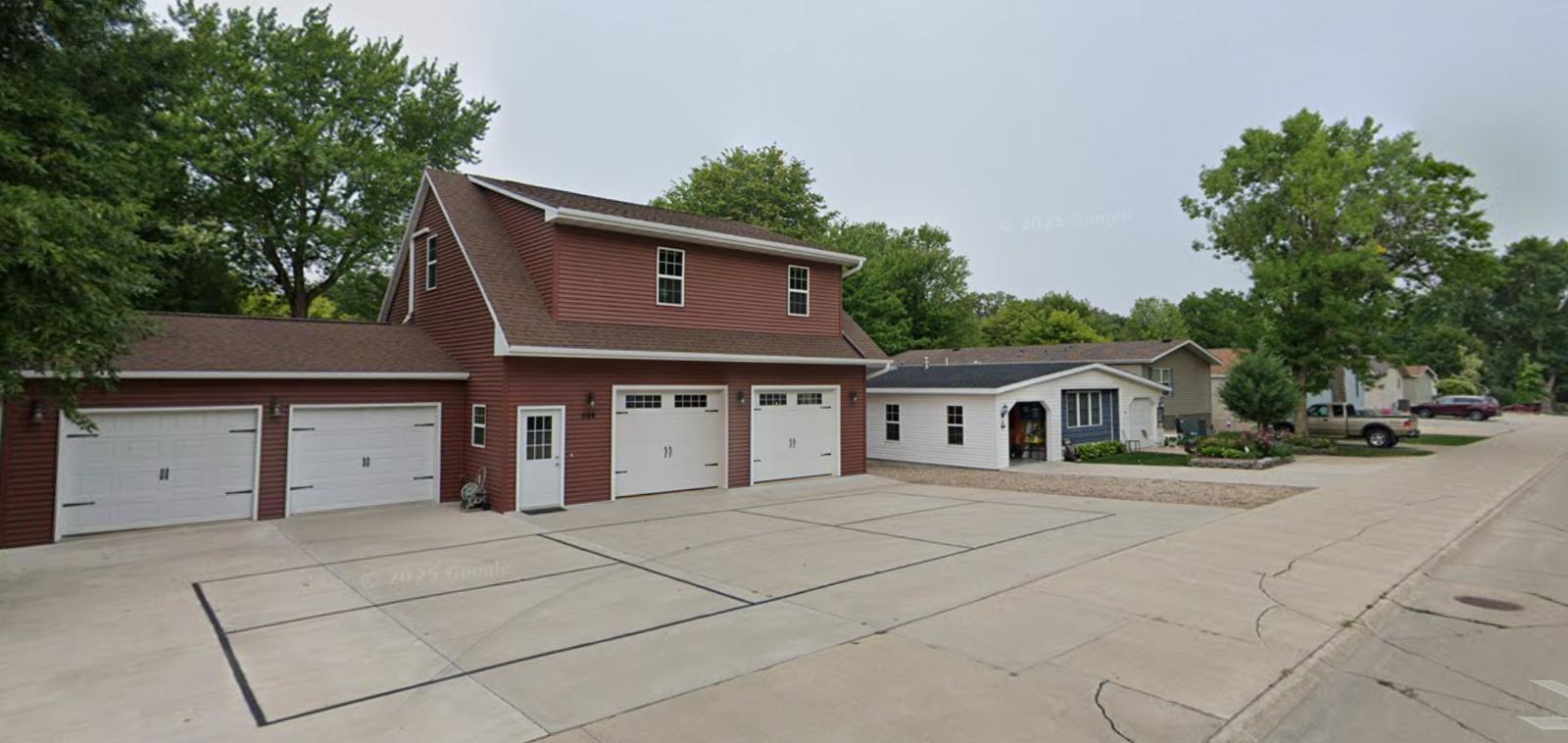
Why are people willing to pay so much to live here? What’s special about it?
Arnolds Park commands premium prices as the entertainment heart of the Iowa Great Lakes region, offering unique lifestyle amenities that blend vintage amusement park charm with lakefront living. The historic Arnolds Park Amusement Park, one of the longest-operating amusement parks in the United States, creates a distinctive community identity that attracts both residents and tourists. Lakefront properties provide direct access to West Okoboji Lake’s recreational opportunities.
The community offers a rare combination of year-round resort amenities and permanent residential neighborhoods that appeal to diverse demographics from young families to retirees. Entertainment venues, restaurants, and recreational facilities create a vibrant summer atmosphere while winter activities maintain year-round appeal. The unique blend of historic charm, lakefront recreation, and entertainment amenities justifies premium property values unlike anywhere else in Iowa.
How Arnolds Park Rose to Prominence
Arnolds Park began in the 1880s when Wesley Arnold built a hotel and boat landing on West Okoboji Lake to serve visitors drawn to the area’s natural beauty. The community’s entertainment heritage started in 1889 with the opening of what would become Arnolds Park Amusement Park, making it one of America’s oldest continuously operating amusement parks. Early attractions included dance halls, boat rentals, and lakefront pavilions that drew visitors from across the Midwest.
The development of railroad connections and improved roads in the early 1900s transformed Arnolds Park into the premier resort destination for the Iowa Great Lakes region. The amusement park expanded with rides, games, and entertainment venues while residential development grew around the entertainment district. This unique combination of permanent community and recreational destination created a distinctive identity that continues to attract both residents and visitors, supporting premium property values and a vibrant year-round economy.
3 Interesting Tidbits
- Historic Amusement Park – Arnolds Park Amusement Park, operating since 1889, features the famous wooden roller coaster “The Legend” and maintains vintage carnival atmosphere that defines the community’s character.
- Summer Concert Series – The historic Roof Garden Ballroom hosts major musical acts and events that draw visitors from across the region, contributing to the area’s entertainment economy.
- Lake Access Hub – Arnolds Park serves as the primary access point for West Okoboji Lake recreation, with marinas, boat launches, and rental facilities that support the area’s recreational economy.
9. Swisher – 60% Home Price Increase Since 2010

- 2010: $277,040
- 2011: $273,091
- 2012: $270,429
- 2013: $275,318
- 2014: $280,841
- 2015: $288,991
- 2016: $302,958
- 2017: $311,960
- 2018: $326,617
- 2019: $335,241
- 2020: $352,568
- 2021: $383,632
- 2022: $419,972
- 2023: $426,122
- 2024: $430,219
- 2025: $443,104
Swisher shows steady 60% growth since 2010, starting from the highest baseline on our list at $277,040 and reaching $443,104 today. The community demonstrated consistent appreciation throughout the period, with particularly strong gains during 2020-2022 when values jumped from $352,568 to $419,972. This measured growth reflects Swisher’s established reputation as an upscale suburban community.
Why Swisher?
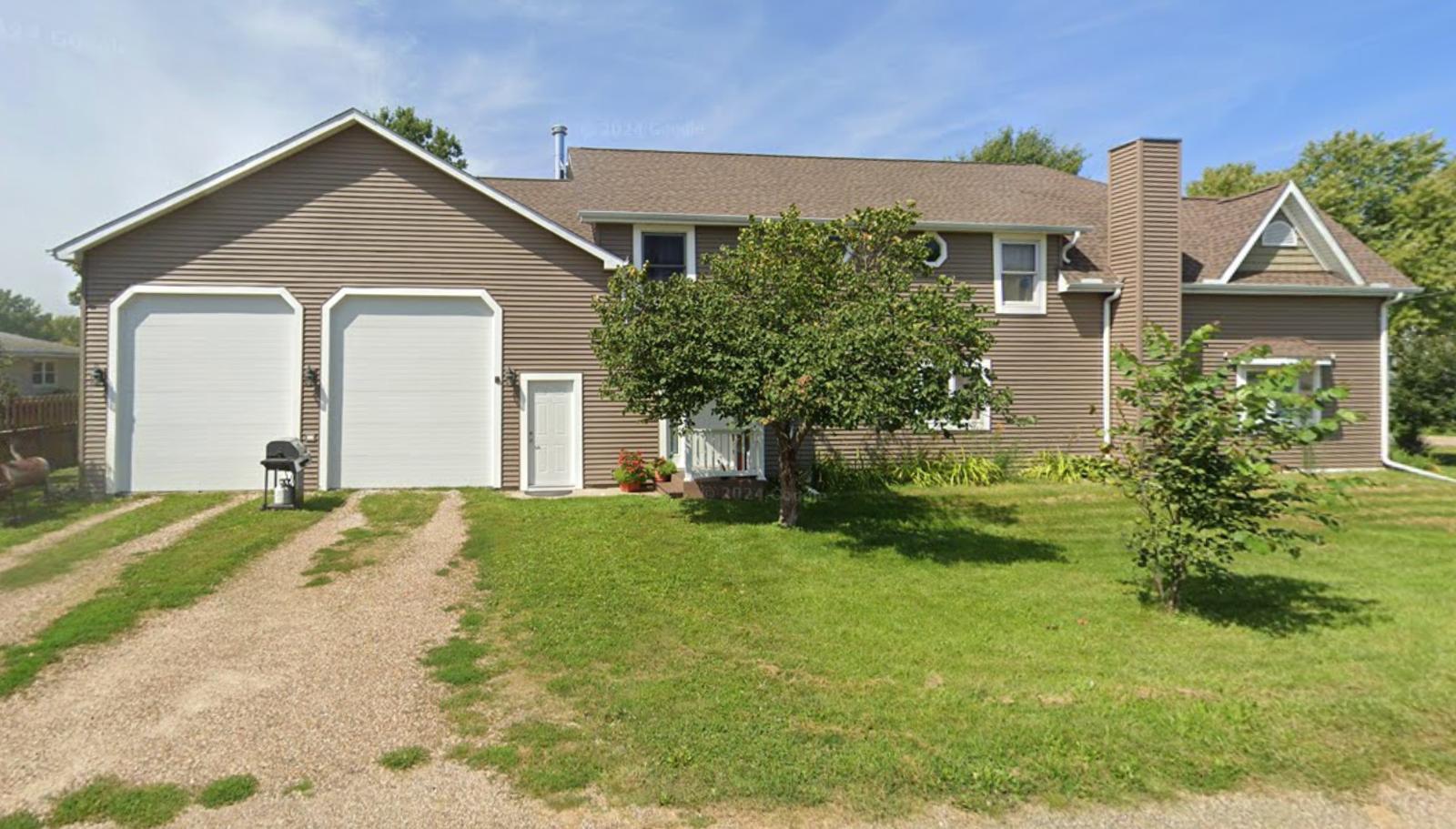
Why are people willing to pay so much to live here? What’s special about it?
Swisher commands premium prices as one of eastern Iowa’s most exclusive suburban communities, offering upscale housing within the highly regarded North Cedar Community School District. The community features custom homes on large lots with scenic countryside views while maintaining convenient access to Cedar Rapids and Iowa City employment centers. Affluent families are drawn to the combination of rural estate living and suburban conveniences.
The area’s rolling hills and mature trees provide an appealing setting for luxury residential development, with many properties offering privacy and natural beauty that distinguish them from typical suburban neighborhoods. Excellent schools, low crime rates, and well-maintained infrastructure create ideal conditions for upscale family living. The combination of natural beauty, educational excellence, and convenient location makes Swisher particularly attractive to successful professionals seeking premium residential experiences.
How Swisher Rose to Prominence
Swisher began as a small agricultural community in Johnson County during the mid-1800s, named after early settler families who established farms throughout the area. The community remained rural and sparsely populated through most of the 20th century, known for its fertile farmland and scattered farmsteads. The area’s proximity to both Cedar Rapids and Iowa City positioned it for eventual residential development as both metropolitan areas expanded.
The transformation to an exclusive suburban community began in the 1980s as developers recognized the area’s potential for upscale housing within excellent school district boundaries. The North Cedar Community School District’s reputation for academic excellence became a major attraction, while the scenic countryside offered opportunities for luxury homes on large lots. Swisher’s careful development and preservation of rural character while providing modern amenities created one of Iowa’s most prestigious suburban addresses.
3 Interesting Tidbits
- Dual Metro Access – Swisher’s location provides convenient access to both Cedar Rapids and Iowa City employment centers, making it attractive to professionals working in either metropolitan area.
- School District Excellence – North Cedar Community School District consistently ranks among Iowa’s top academic performers, making Swisher a magnet for education-focused affluent families.
- Rural Estate Living – Many Swisher properties feature large lots and custom homes that provide rural estate character while maintaining suburban conveniences and services.
8. Solon – 89% Home Price Increase Since 2010
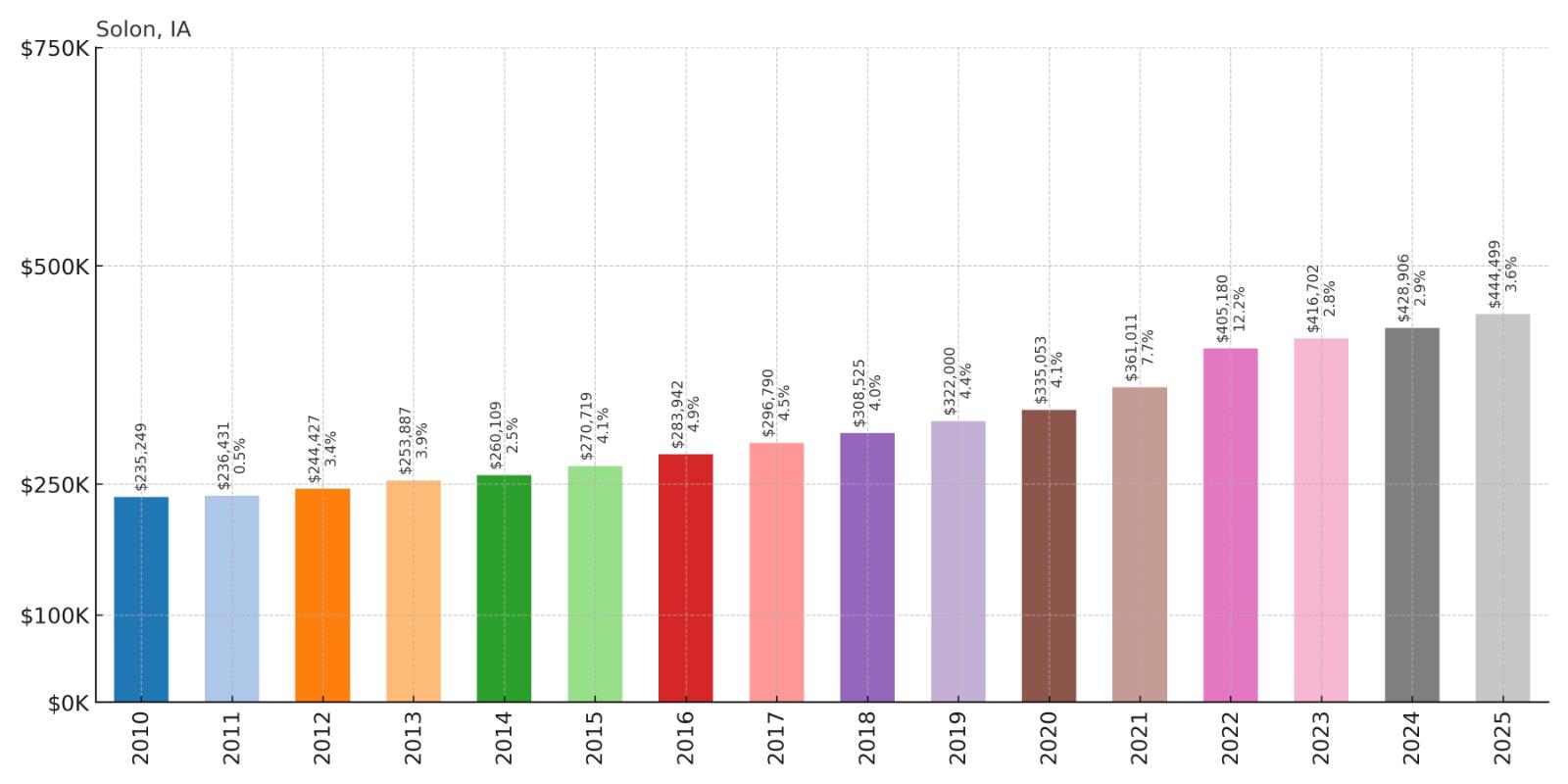
- 2010: $235,249
- 2011: $236,431
- 2012: $244,427
- 2013: $253,887
- 2014: $260,109
- 2015: $270,719
- 2016: $283,942
- 2017: $296,790
- 2018: $308,525
- 2019: $322,000
- 2020: $335,053
- 2021: $361,011
- 2022: $405,180
- 2023: $416,702
- 2024: $428,906
- 2025: $444,499
Solon demonstrates impressive 89% growth since 2010, with steady appreciation from $235,249 to $444,499 today. The community showed remarkably consistent year-over-year gains throughout the entire period, with acceleration during 2021-2022 when values jumped from $361,011 to $405,180. This steady growth pattern reflects Solon’s enduring appeal as a top-tier suburban community.
Why Solon?
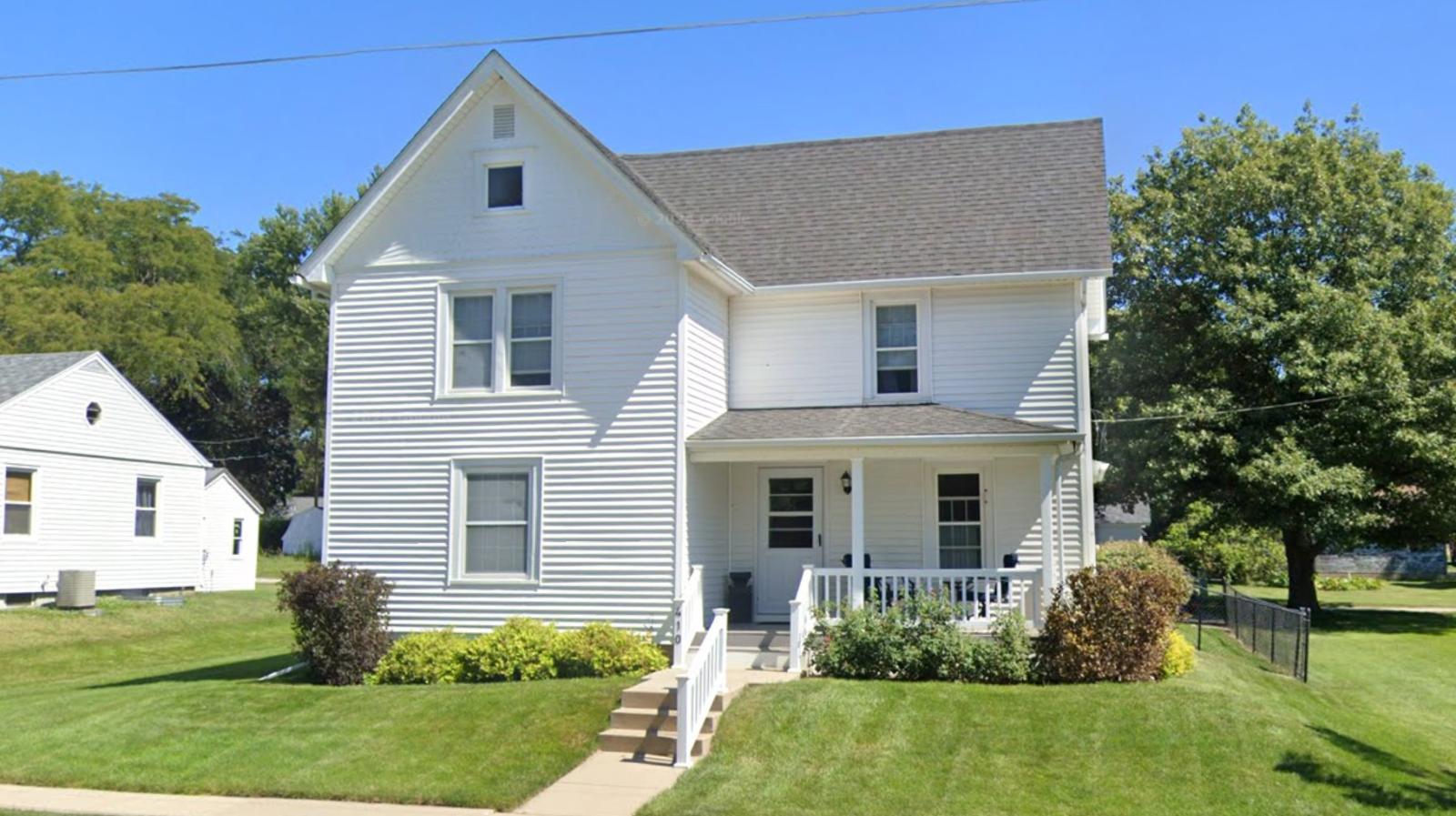
Why are people willing to pay so much to live here? What’s special about it?
Solon ranks among Iowa’s most desirable communities due to its combination of excellent schools, small-town character, and convenient access to both Cedar Rapids and Iowa City employment centers. The Solon Community School District consistently ranks among the state’s top performers, attracting families willing to pay premium prices for educational excellence. The community features well-maintained neighborhoods, abundant parks, and strong municipal services that create ideal family living conditions.
The area’s rolling countryside setting and preservation of agricultural character provide scenic beauty while maintaining modern suburban amenities. Community events, local businesses, and neighborly atmosphere foster the small-town connections that many suburban developments lack. The combination of educational excellence, natural beauty, and convenient dual-metro access makes Solon particularly attractive to professional families seeking the best of rural and suburban living.
How Solon Rose to Prominence
Solon was founded in 1876 along the Burlington, Cedar Rapids and Northern Railroad, named after the ancient Greek statesman Solon. The community developed as an agricultural center serving surrounding farming operations, with grain elevators, livestock facilities, and businesses supporting rural families. Throughout the early 20th century, Solon remained a small but vital farming community in Johnson County.
The transformation to a premier suburban community began in the 1970s and accelerated through subsequent decades as both Cedar Rapids and Iowa City metropolitan areas expanded. The Solon Community School District’s commitment to educational excellence became a major attraction, while the town’s preservation of small-town character and agricultural heritage appealed to families seeking authentic community life. This combination of educational quality, small-town values, and convenient location drove steady growth and property appreciation that continues today.
3 Interesting Tidbits
- Academic Excellence – Solon High School consistently ranks among Iowa’s top academic performers and has produced numerous National Merit Scholars, making it a primary draw for education-focused families.
- Beef Days Festival – The annual Beef Days celebration brings the community together and celebrates Solon’s agricultural heritage while supporting local businesses and community organizations.
- Green Initiatives – Solon has received recognition for environmental sustainability efforts, including renewable energy projects and conservation programs that enhance quality of life.
7. Honey Creek – 131% Home Price Increase Since 2012

- 2010: N/A
- 2011: N/A
- 2012: $194,049
- 2013: $204,441
- 2014: $205,487
- 2015: $213,446
- 2016: $224,077
- 2017: $233,183
- 2018: $244,555
- 2019: $264,960
- 2020: $280,398
- 2021: $334,129
- 2022: $391,403
- 2023: $401,055
- 2024: $435,434
- 2025: $447,873
Honey Creek shows exceptional 131% growth since 2012 when data first became available, more than doubling from $194,049 to $447,873 today. The community experienced steady appreciation through 2020, then accelerated dramatically during 2021-2022 when values jumped from $334,129 to $391,403. This explosive growth reflects Honey Creek’s emergence as a sought-after Des Moines area community.
Why Honey Creek?
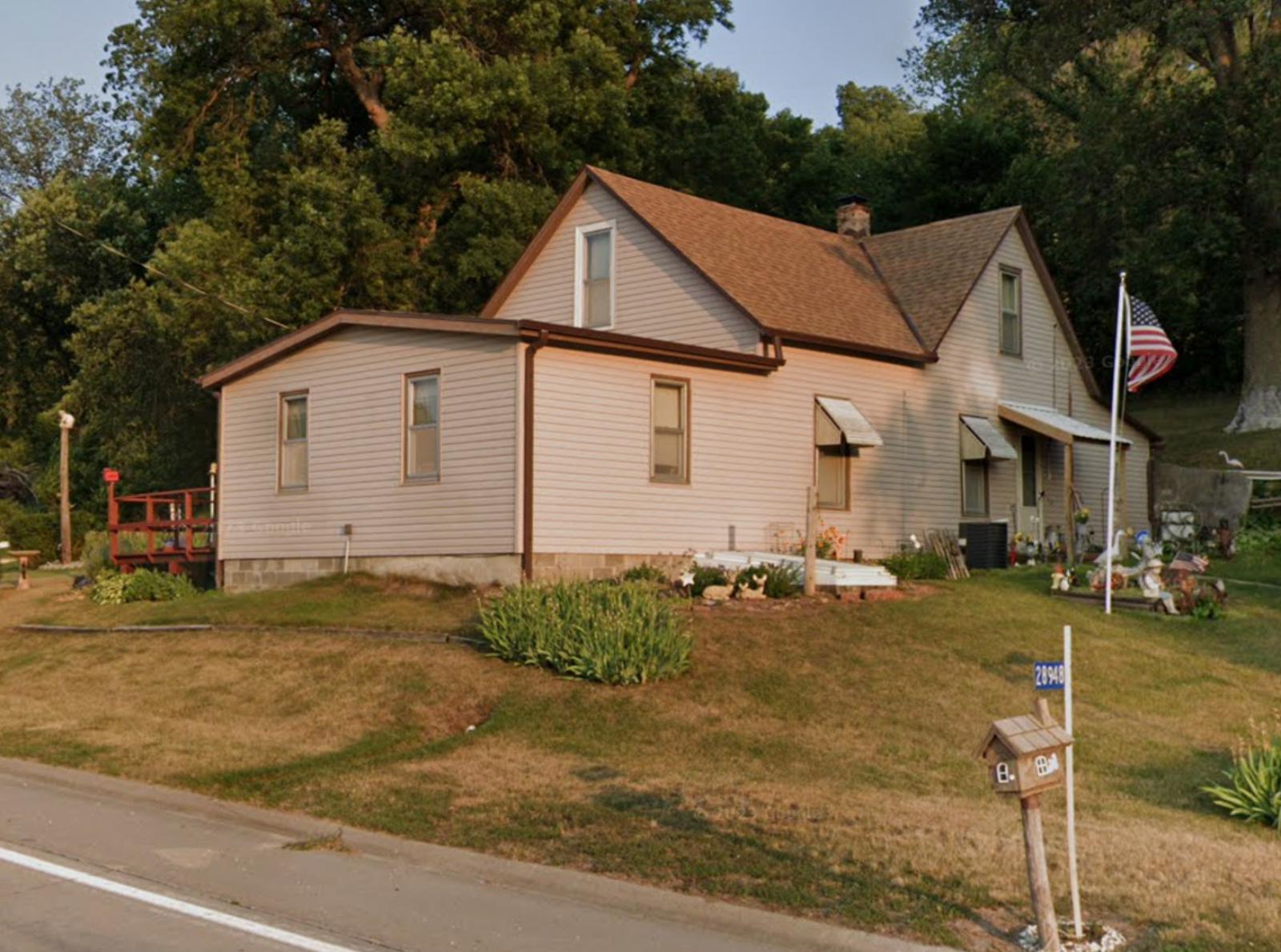
Why are people willing to pay so much to live here? What’s special about it?
Honey Creek attracts families seeking suburban living within the excellent Saydel Community School District while maintaining small-town character and convenient Des Moines access. The community offers newer housing developments with larger lots and modern amenities while preserving rural views and agricultural heritage. Families particularly value the safe neighborhoods, community spirit, and reasonable commuting distance to urban employment centers.
The area’s scenic countryside setting provides space for custom homes and rural lifestyle while maintaining access to suburban conveniences and services. Community events and local businesses foster neighborly connections that distinguish small communities from larger suburban developments. The combination of excellent schools, natural beauty, and convenient location makes Honey Creek particularly attractive to young professionals and growing families seeking authentic Iowa living.
How Honey Creek Rose to Prominence
Honey Creek began as a small farming community in Polk County during the late 1800s, named after a local creek that provided water for early settlers and their livestock. The area remained predominantly agricultural through most of the 20th century, with scattered farmsteads and rural residences characterizing the landscape. The community’s proximity to Des Moines positioned it for eventual residential development as the metropolitan area expanded.
The transformation to a suburban residential community accelerated in the 1990s and 2000s as families discovered the area’s combination of rural character and convenient urban access. The Saydel Community School District’s improving reputation attracted new residents, while developers recognized opportunities for housing that preserved countryside views and larger lots. This growth represents successful rural-to-suburban transition that maintains agricultural heritage while providing modern amenities and family-friendly communities.
3 Interesting Tidbits
- Creek Heritage – The community name reflects the natural waterway that attracted early settlers and continues to provide scenic beauty and natural areas for current residents.
- Agricultural Preservation – Working farms continue to operate in and around Honey Creek, maintaining rural character while supporting residential development that respects agricultural heritage.
- School District Growth – Saydel Community School District has invested in new facilities and programs to serve growing communities like Honey Creek, attracting education-focused families throughout the area.
6. Panora – 148% Home Price Increase Since 2010

- 2010: $188,993
- 2011: $184,487
- 2012: $196,081
- 2013: $246,000
- 2014: $285,841
- 2015: $286,744
- 2016: $291,189
- 2017: $307,768
- 2018: $322,402
- 2019: $342,631
- 2020: $350,356
- 2021: $390,396
- 2022: $448,636
- 2023: $441,163
- 2024: $454,255
- 2025: $469,629
Panora demonstrates remarkable 148% growth since 2010, with values climbing from $188,993 to $469,629 today. The community experienced dramatic acceleration during 2013-2014 when values jumped from $246,000 to $285,841, then continued strong appreciation with another surge during 2021-2022. This growth reflects Panora’s appeal as central Iowa’s premier lake community.
Why Panora?
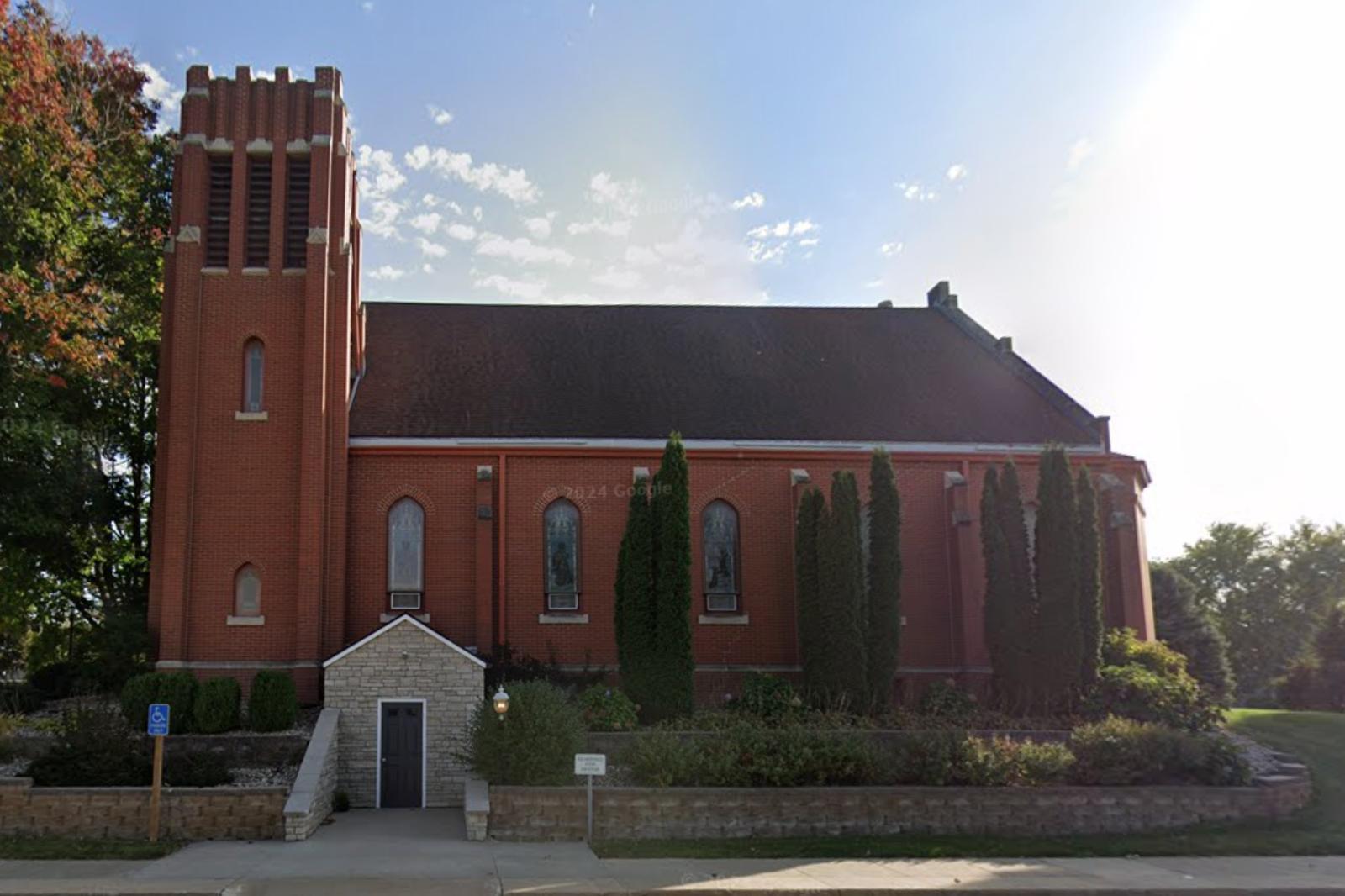
Why are people willing to pay so much to live here? What’s special about it?
Panora commands premium prices as central Iowa’s most desirable lake community, offering year-round recreational opportunities on Lake Panorama with resort-style amenities. The community attracts both permanent residents and vacation homeowners seeking lakefront living with boating, fishing, swimming, golf, and extensive recreational facilities. Lake Panorama’s championship golf course and country club create resort-quality amenities that justify premium property values.
The area’s natural beauty, combined with well-developed infrastructure and recreational economy, makes Panora particularly attractive to affluent retirees and vacation homeowners. Lakefront properties command the highest prices, while even properties near the lake benefit from the area’s recreational amenities and scenic setting. The combination of natural beauty, recreational opportunities, and resort amenities creates a premium lifestyle market that supports strong property values year-round.
How Panora Rose to Prominence
Panora was established in 1851 as a small agricultural community in Guthrie County, with early settlers drawn to the area’s rolling hills and natural springs. The town’s name, meaning “all view” in Greek, reflected the scenic countryside that attracted early residents. Throughout the late 19th and early 20th centuries, Panora remained a quiet farming community with modest population and local businesses serving surrounding rural areas.
The community’s transformation began in the 1970s with the creation of Lake Panorama through dam construction, fundamentally changing Panora from an agricultural town to a recreational destination. The lake development included residential neighborhoods, a championship golf course, marina facilities, and resort amenities that attracted both permanent residents and vacation homeowners. This transformation from farming community to lake resort created a unique economy and lifestyle that drives premium property values and attracts affluent buyers from across the region.
3 Interesting Tidbits
- Man-Made Lake Paradise – Lake Panorama, created in the 1970s, covers 1,200 acres and features a championship golf course designed by noted architect Robert Trent Jones, making it central Iowa’s premier recreational destination.
- Greek Name Heritage – The community name “Panora” derives from Greek meaning “all view,” reflecting the scenic countryside that continues to attract residents and visitors to this day.
- Resort Community Model – Panora represents one of Iowa’s most successful transformations from agricultural town to recreational resort community, demonstrating how tourism and amenities can drive economic development and property values.
5. Cumming – 122% Home Price Increase Since 2010
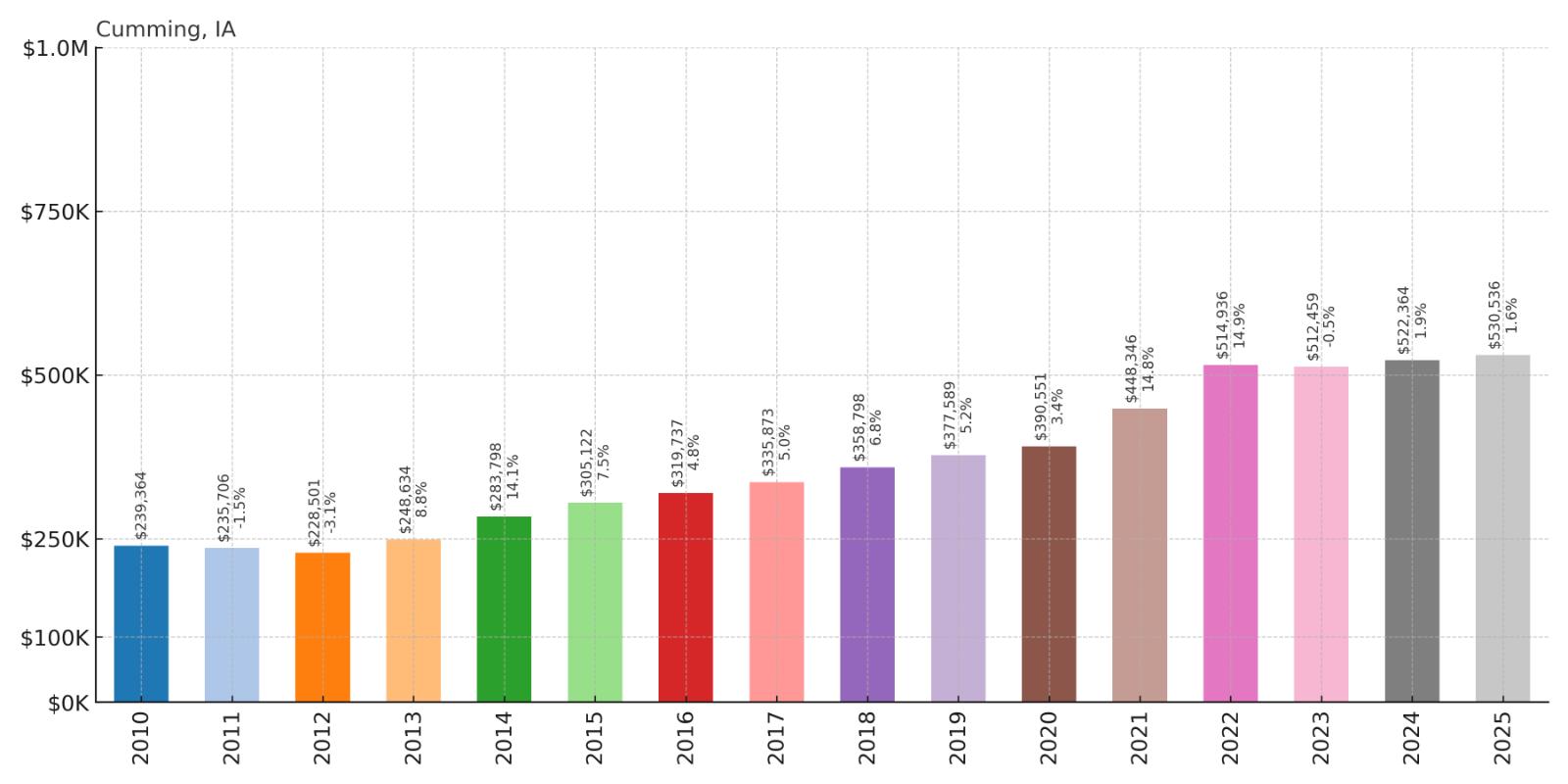
- 2010: $239,364
- 2011: $235,706
- 2012: $228,501
- 2013: $248,634
- 2014: $283,798
- 2015: $305,122
- 2016: $319,737
- 2017: $335,873
- 2018: $358,798
- 2019: $377,589
- 2020: $390,551
- 2021: $448,346
- 2022: $514,936
- 2023: $512,459
- 2024: $522,364
- 2025: $530,536
Cumming shows exceptional 122% growth since 2010, more than doubling from $239,364 to $530,536 today. The community experienced steady acceleration throughout most of the period, with particularly dramatic gains during 2021-2022 when values jumped from $448,346 to $514,936. This consistent strong growth reflects Cumming’s established reputation as one of Iowa’s most desirable suburban communities.
Why Cumming?

Why are people willing to pay so much to live here? What’s special about it?
Cumming ranks among Iowa’s most prestigious communities due to its location within the excellent West Des Moines Community School District and its proximity to both recreational amenities and Des Moines employment centers. The community features upscale housing developments, lake access properties, and well-maintained neighborhoods that attract affluent families seeking premium suburban living. Many properties offer views or access to Cumming Lake and surrounding recreational areas.
Professional families particularly value Cumming’s combination of excellent schools, low crime rates, and recreational opportunities that create resort-quality living with convenient urban access. The area’s natural beauty, combined with modern infrastructure and municipal services, supports property values that reflect the community’s premium positioning. The blend of lakefront recreation, educational excellence, and suburban sophistication makes Cumming especially attractive to successful professionals and growing families.
How Cumming Rose to Prominence
Cumming was established in the 1880s as a railroad community along the Chicago, Rock Island and Pacific Railroad, named after a railroad official. The town developed as an agricultural center serving surrounding farming operations, with grain elevators and businesses supporting rural families throughout Warren County. For much of its early history, Cumming remained a small farming community with modest population and local commerce.
The transformation to a premier suburban community began in the 1980s and accelerated through subsequent decades as Des Moines’ metropolitan area expanded southward. The creation of recreational lakes and the community’s inclusion within the highly regarded West Des Moines school district became major attractions for affluent families. Developers recognized Cumming’s potential for upscale housing with lake views and recreational amenities, creating one of Iowa’s most successful suburban communities that attracts high-income residents seeking quality of life and educational excellence.
3 Interesting Tidbits
- Lake Community Living – Cumming Lake and surrounding recreational areas provide waterfront living opportunities and recreational amenities that distinguish the community from typical suburban developments.
- School District Excellence – Location within West Des Moines Community School District boundaries makes Cumming extremely attractive to families, as the district consistently ranks among Iowa’s top academic performers.
- Affluent Demographics – Cumming consistently ranks among Iowa’s highest-income communities, with residents including executives and professionals who support premium housing values and upscale amenities.
4. Shueyville – 68% Home Price Increase Since 2010
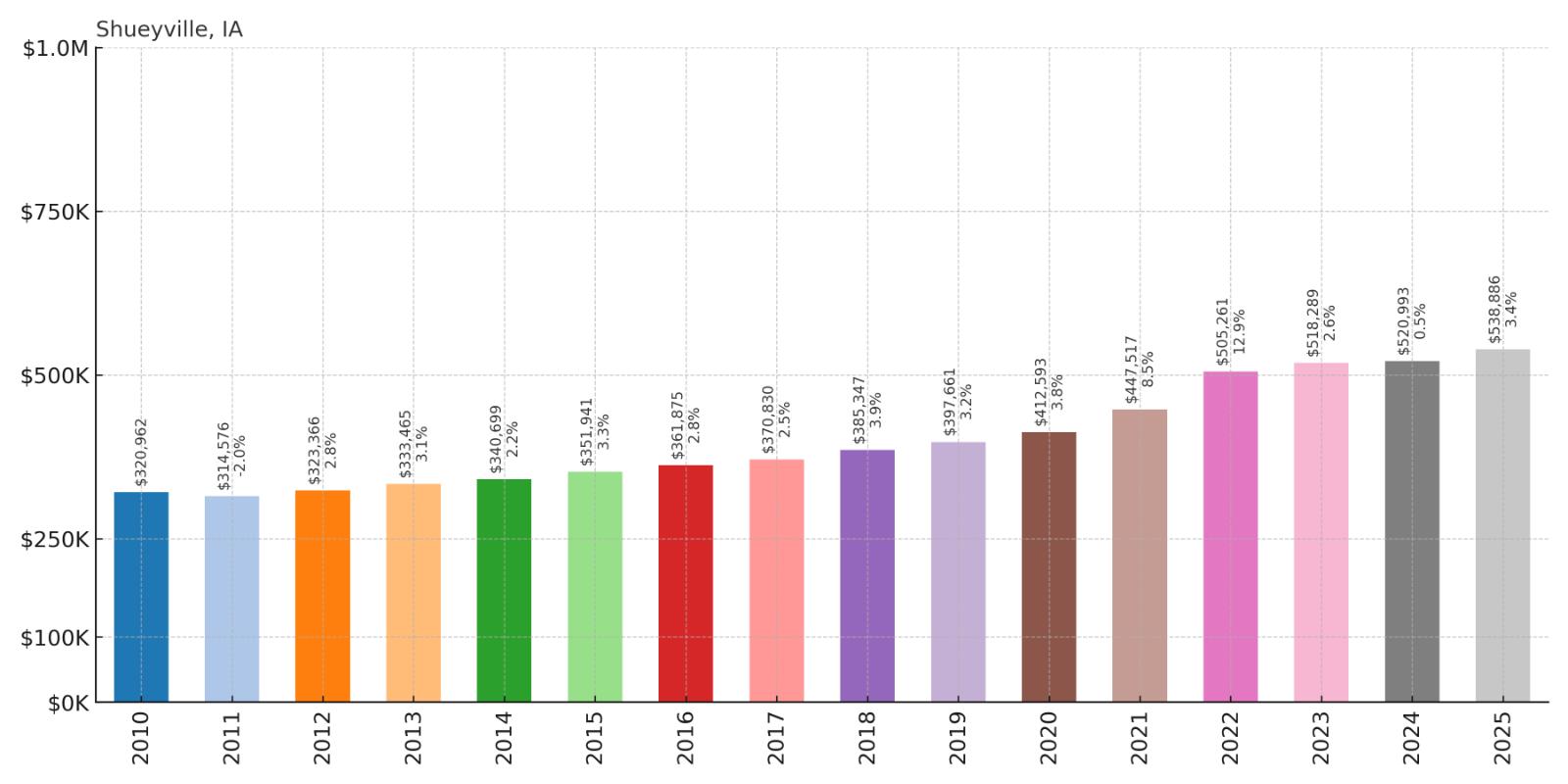
- 2010: $320,962
- 2011: $314,576
- 2012: $323,366
- 2013: $333,465
- 2014: $340,699
- 2015: $351,941
- 2016: $361,875
- 2017: $370,830
- 2018: $385,347
- 2019: $397,661
- 2020: $412,593
- 2021: $447,517
- 2022: $505,261
- 2023: $518,289
- 2024: $520,993
- 2025: $538,886
Shueyville demonstrates steady 68% growth since 2010, starting from the second-highest baseline on our list at $320,962 and reaching $538,886 today. The community showed remarkably consistent year-over-year appreciation throughout the period, with acceleration during 2021-2022 when values jumped from $447,517 to $505,261. This measured growth reflects Shueyville’s established position as an exclusive suburban enclave.
Why Shueyville?
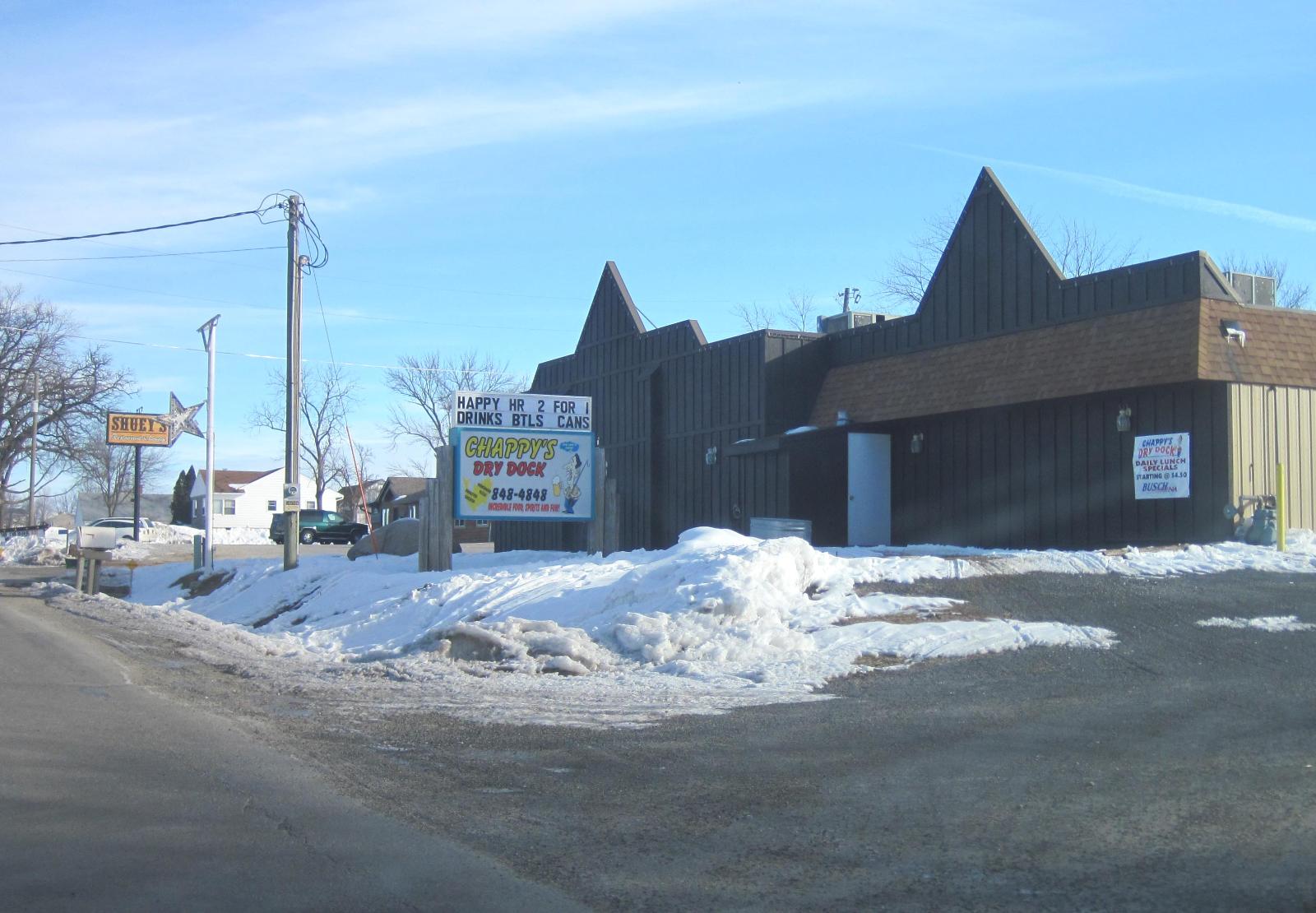
Why are people willing to pay so much to live here? What’s special about it?
Shueyville commands premium prices as one of eastern Iowa’s most exclusive communities, offering luxury housing within the highly regarded Iowa City Community School District. The small community features custom homes on large lots with scenic countryside views while maintaining convenient access to University of Iowa and Iowa City employment centers. The area attracts university faculty, medical professionals, and business executives seeking upscale living with academic and cultural amenities nearby.
The community’s rolling hills and mature trees provide an elegant setting for luxury residential development, with properties offering privacy and natural beauty that distinguish them from typical suburban neighborhoods. Excellent schools, low crime rates, and proximity to cultural amenities create ideal conditions for affluent family living. The combination of natural beauty, educational excellence, and cultural access makes Shueyville particularly attractive to highly educated professionals seeking premium residential experiences.
How Shueyville Rose to Prominence
Shueyville began as a small farming community in Johnson County during the mid-1800s, named after early settler families who established homesteads throughout the area. The community remained rural and sparsely populated through most of the 20th century, known for its fertile farmland and scattered rural residences. The area’s proximity to Iowa City and the University of Iowa positioned it for eventual residential development as the metropolitan area expanded.
The transformation to an exclusive suburban community began in the 1970s and accelerated through subsequent decades as university faculty, medical professionals, and business leaders sought upscale housing near Iowa City’s academic and cultural amenities. The Iowa City Community School District’s excellent reputation became a major attraction, while the scenic countryside offered opportunities for luxury homes on large lots. Shueyville’s careful development and preservation of rural character while providing modern amenities created one of Iowa’s most prestigious addresses.
3 Interesting Tidbits
- University Connection – Many residents are University of Iowa faculty, staff, or medical professionals, creating a highly educated demographic that supports cultural activities and educational excellence.
- Luxury Rural Estate – Properties typically feature larger lots and custom homes that provide rural estate character while maintaining convenient access to urban amenities and cultural facilities.
- Cultural Access – Proximity to University of Iowa provides residents access to world-class cultural amenities including Hancher Auditorium, museums, and academic events that enhance quality of life.
3. Wahpeton – 76% Home Price Increase Since 2017

- 2010: N/A
- 2011: N/A
- 2012: N/A
- 2013: N/A
- 2014: N/A
- 2015: N/A
- 2016: N/A
- 2017: $317,323
- 2018: $328,066
- 2019: $344,601
- 2020: $359,526
- 2021: $402,716
- 2022: $500,634
- 2023: $511,185
- 2024: $530,753
- 2025: $558,152
Wahpeton shows impressive 76% growth since 2017 when data first became available, climbing from $317,323 to $558,152 today. The community experienced particularly dramatic acceleration during 2022 when values jumped from $402,716 to $500,634, representing explosive growth that reflects intense demand for this exclusive community despite limited historical data.
Why Wahpeton?
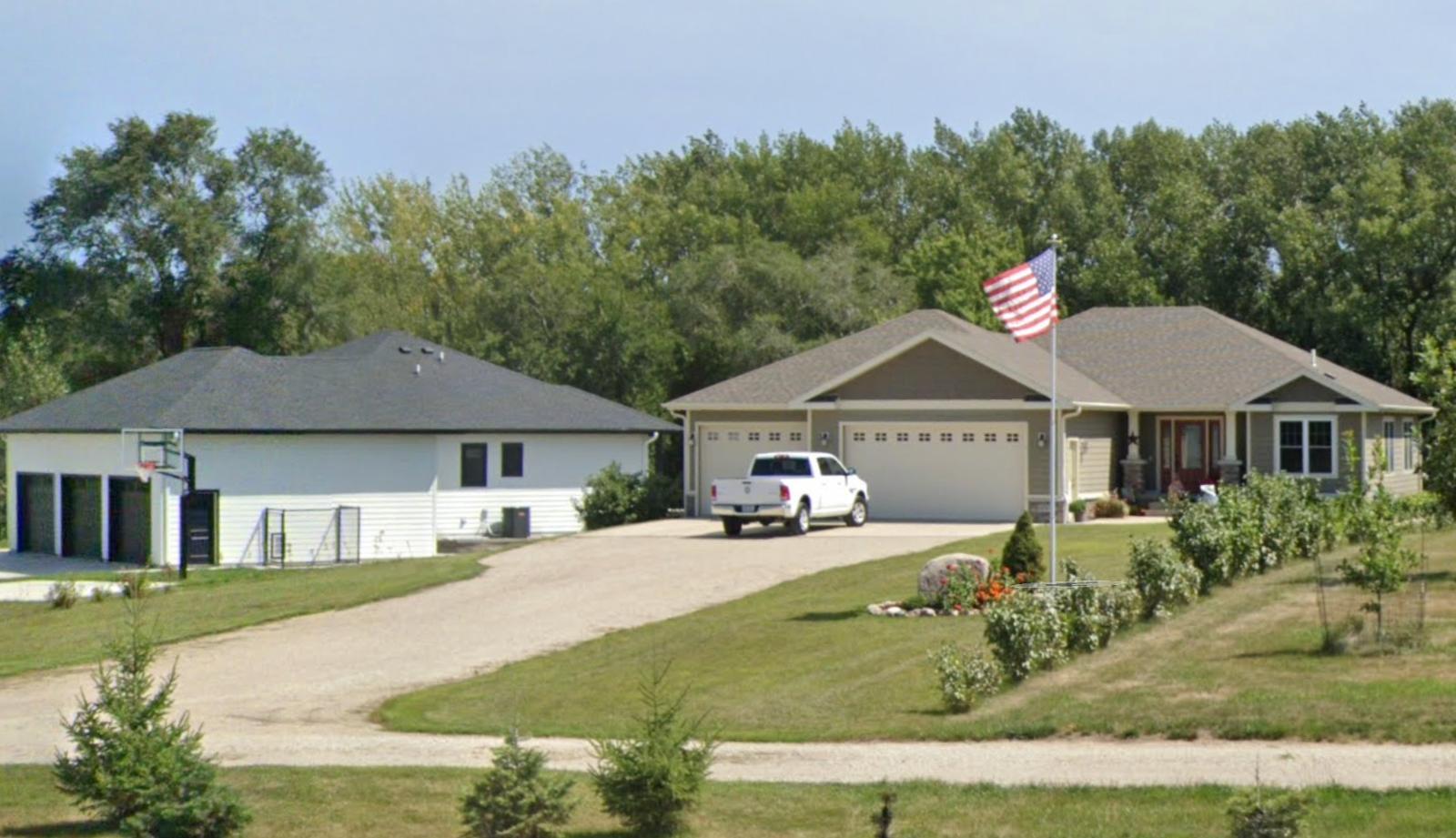
Why are people willing to pay so much to live here? What’s special about it?
Wahpeton attracts affluent buyers seeking exclusive rural estate living within convenient access to Des Moines area employment centers. The small community offers luxury properties with larger lots, custom homes, and scenic countryside views that provide privacy and natural beauty rarely found in typical suburban developments. The area appeals to successful professionals and business executives seeking prestige addresses with rural character and modern conveniences.
The community’s rolling hills and agricultural heritage create an elegant setting for upscale residential development while maintaining authentic rural character. Low population density and careful development preserve the area’s natural beauty and exclusivity, which appeals to buyers seeking unique properties with privacy and space. The combination of luxury living, natural beauty, and convenient location makes Wahpeton particularly attractive to high-income demographics seeking distinctive lifestyle experiences.
How Wahpeton Rose to Prominence
Wahpeton began as a small farming community in Dickinson County during the late 1800s, named after a Dakota Sioux word meaning “leaf dwellers,” reflecting the area’s natural wooded settings. The community remained primarily agricultural through most of the 20th century, with farming families and scattered rural residences characterizing the landscape. The area’s scenic countryside and proximity to regional population centers positioned it for eventual exclusive residential development.
The transformation to a luxury residential community reflects broader trends toward rural estate living and the desire for privacy and natural beauty among affluent demographics. As Iowa’s economy grew and successful professionals sought distinctive housing options, Wahpeton’s combination of scenic beauty, larger lots, and convenient access to employment centers attracted custom home development. This evolution represents the emergence of exclusive rural residential communities that cater to high-income buyers seeking alternatives to traditional suburban development.
3 Interesting Tidbits
- Dakota Heritage – The community name reflects the area’s Native American history, with “Wahpeton” meaning “leaf dwellers” in Dakota Sioux, honoring the wooded natural setting that continues to attract residents.
- Exclusive Development – Wahpeton represents a newer model of luxury rural residential development that preserves natural beauty while providing modern amenities for affluent buyers.
- Custom Home Haven – The community’s larger lots and rural setting attract custom home builders and buyers seeking unique properties with country views and privacy not available in typical suburban developments.
2. Orleans – 242% Home Price Increase Since 2010
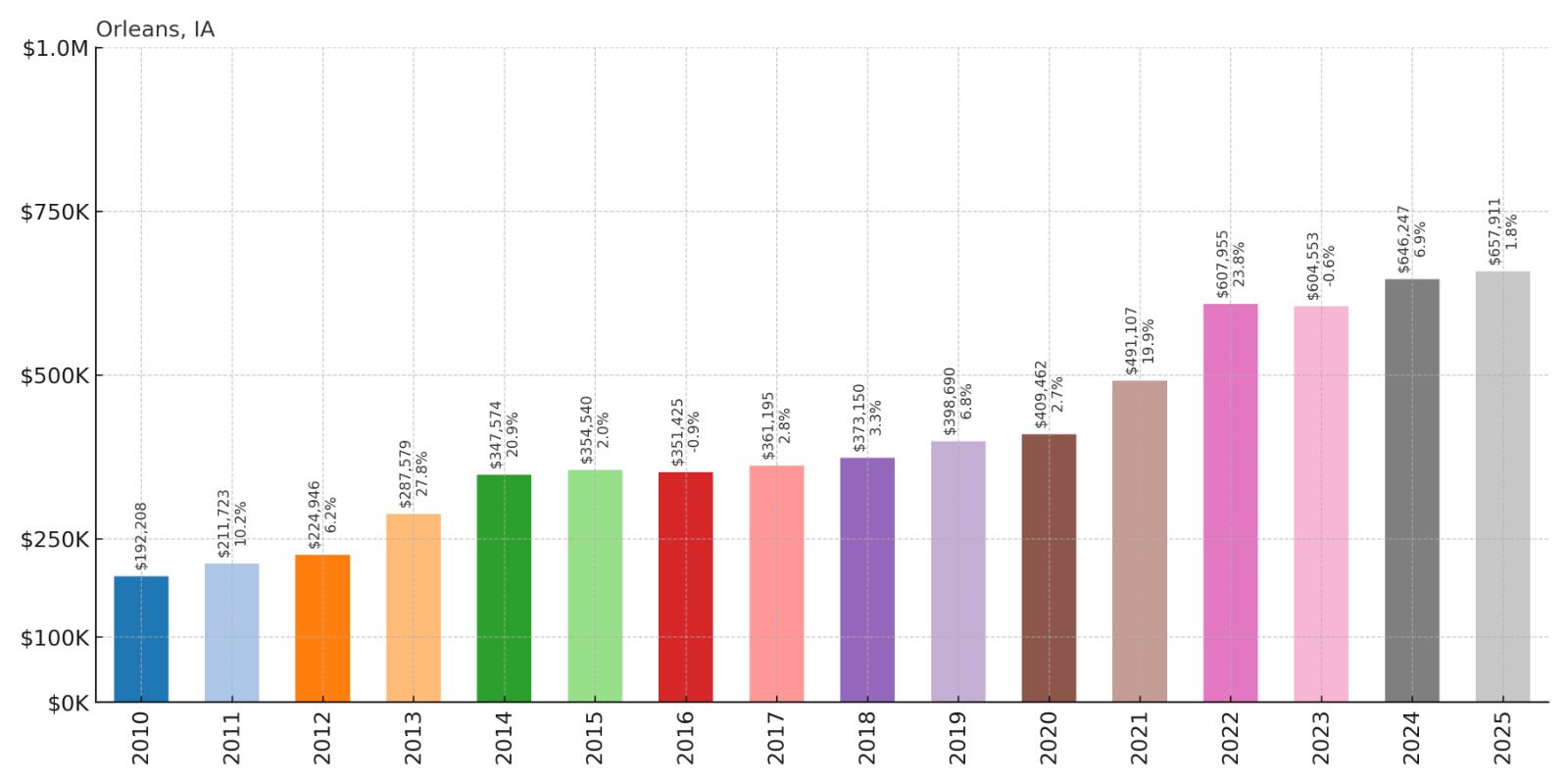
- 2010: $192,208
- 2011: $211,723
- 2012: $224,946
- 2013: $287,579
- 2014: $347,574
- 2015: $354,540
- 2016: $351,425
- 2017: $361,195
- 2018: $373,150
- 2019: $398,690
- 2020: $409,462
- 2021: $491,107
- 2022: $607,955
- 2023: $604,553
- 2024: $646,247
- 2025: $657,911
Orleans demonstrates the most dramatic growth of any Iowa community with an extraordinary 242% increase since 2010. Starting from $192,208, values have more than tripled to reach $657,911 today. The most impressive acceleration occurred during 2013-2014 when prices jumped from $287,579 to $347,574, followed by another surge during 2021-2022 from $491,107 to $607,955.
Why Orleans?
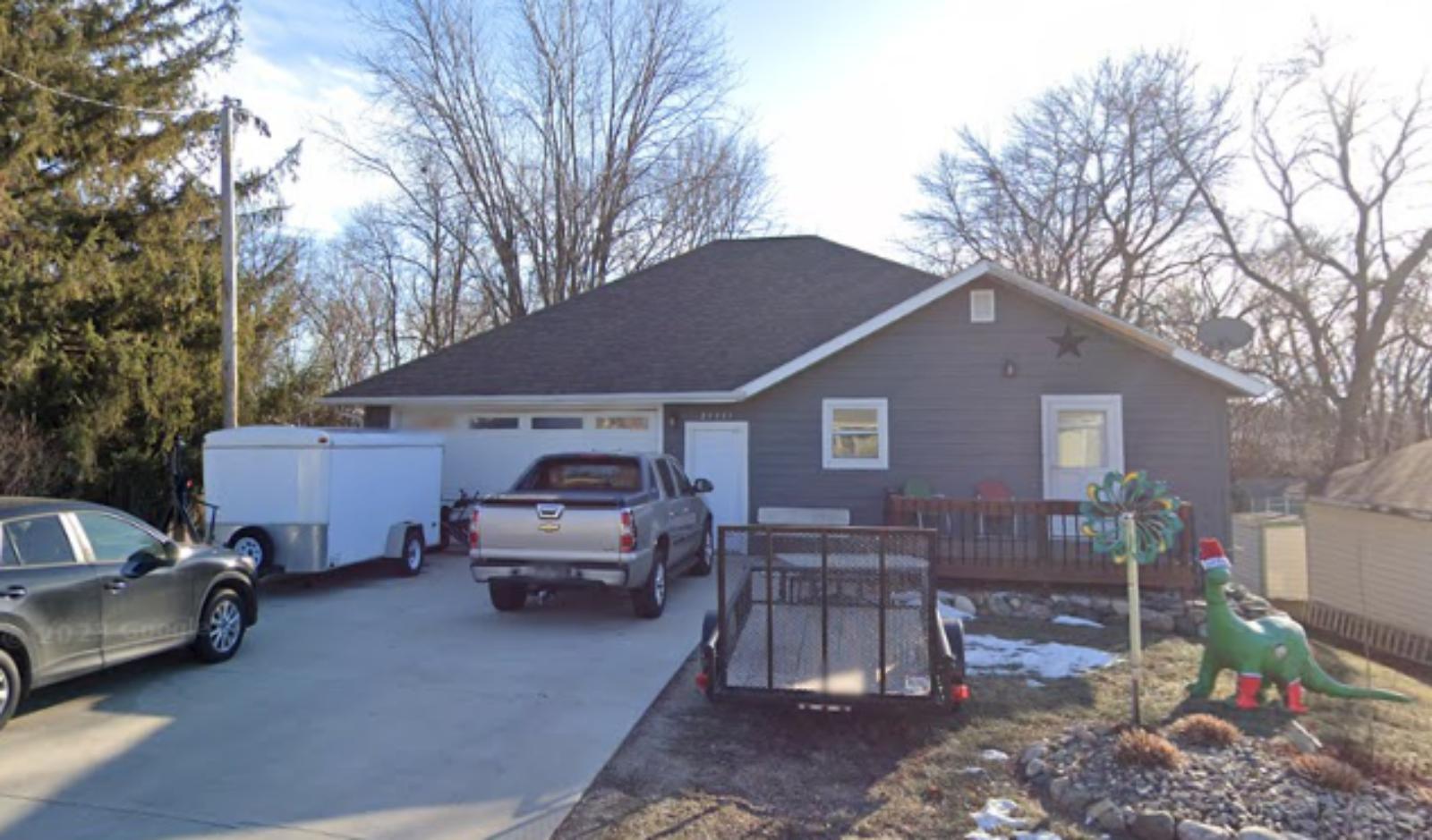
Why are people willing to pay so much to live here? What’s special about it?
Orleans commands the second-highest home values in Iowa due to its unique combination of lakefront recreation and exclusive residential development. The community offers premium lakefront properties with direct water access, boating facilities, and recreational amenities that create resort-style living year-round. Many homes feature custom architecture, large lots, and scenic lake views that justify premium pricing among Iowa’s most affluent buyers.
The area’s natural beauty and recreational economy attract both permanent residents and vacation homeowners seeking luxury lake living with privacy and exclusivity. High-end amenities, well-maintained infrastructure, and limited development preserve property values while creating a distinctive lifestyle market. The combination of natural beauty, recreational opportunities, and luxury amenities makes Orleans particularly attractive to successful professionals and retirees seeking Iowa’s premier lakefront living experience.
How Orleans Rose to Prominence
Orleans began as a small agricultural community in Dickinson County during the late 1800s, named after the French city and reflecting early settlers’ European heritage. The community remained primarily rural through most of the 20th century, with farming operations and scattered residences characterizing the area around what would become Spirit Lake and the Iowa Great Lakes region.
The transformation to a luxury lakefront community began with the development of recreational lakes and resort infrastructure that attracted affluent buyers seeking premium vacation and retirement properties. The Iowa Great Lakes region’s emergence as the state’s premier recreational destination drove demand for exclusive residential development, with Orleans positioning itself as the most upscale community in the area. This evolution from agricultural town to luxury lakefront destination represents one of Iowa’s most successful recreational real estate markets.
3 Interesting Tidbits
- Lakefront Luxury – Orleans features some of Iowa’s most expensive lakefront properties, with custom homes and estates that rival resort destinations in neighboring states.
- French Heritage Name – The community name reflects early settlers’ European connections, maintaining historical ties while evolving into a modern luxury residential destination.
- Recreational Economy – The community’s transformation from farming to luxury lakefront living demonstrates how recreational development can create premium real estate markets in rural Iowa.
1. West Okoboji – 97% Home Price Increase Since 2017

- 2010: N/A
- 2011: N/A
- 2012: N/A
- 2013: N/A
- 2014: N/A
- 2015: N/A
- 2016: N/A
- 2017: $385,221
- 2018: $413,701
- 2019: $452,650
- 2020: $478,834
- 2021: $534,558
- 2022: $639,683
- 2023: $630,588
- 2024: $721,101
- 2025: $760,409
West Okoboji tops Iowa’s list with median home values of $760,409, representing remarkable 97% growth since 2017 when data first became available. Starting at $385,221, values have nearly doubled in just eight years, with particularly dramatic acceleration during 2022 and 2024 when prices jumped by over $90,000 in single years. This explosive growth reflects West Okoboji’s position as Iowa’s most exclusive lakefront destination.
Why West Okoboji?
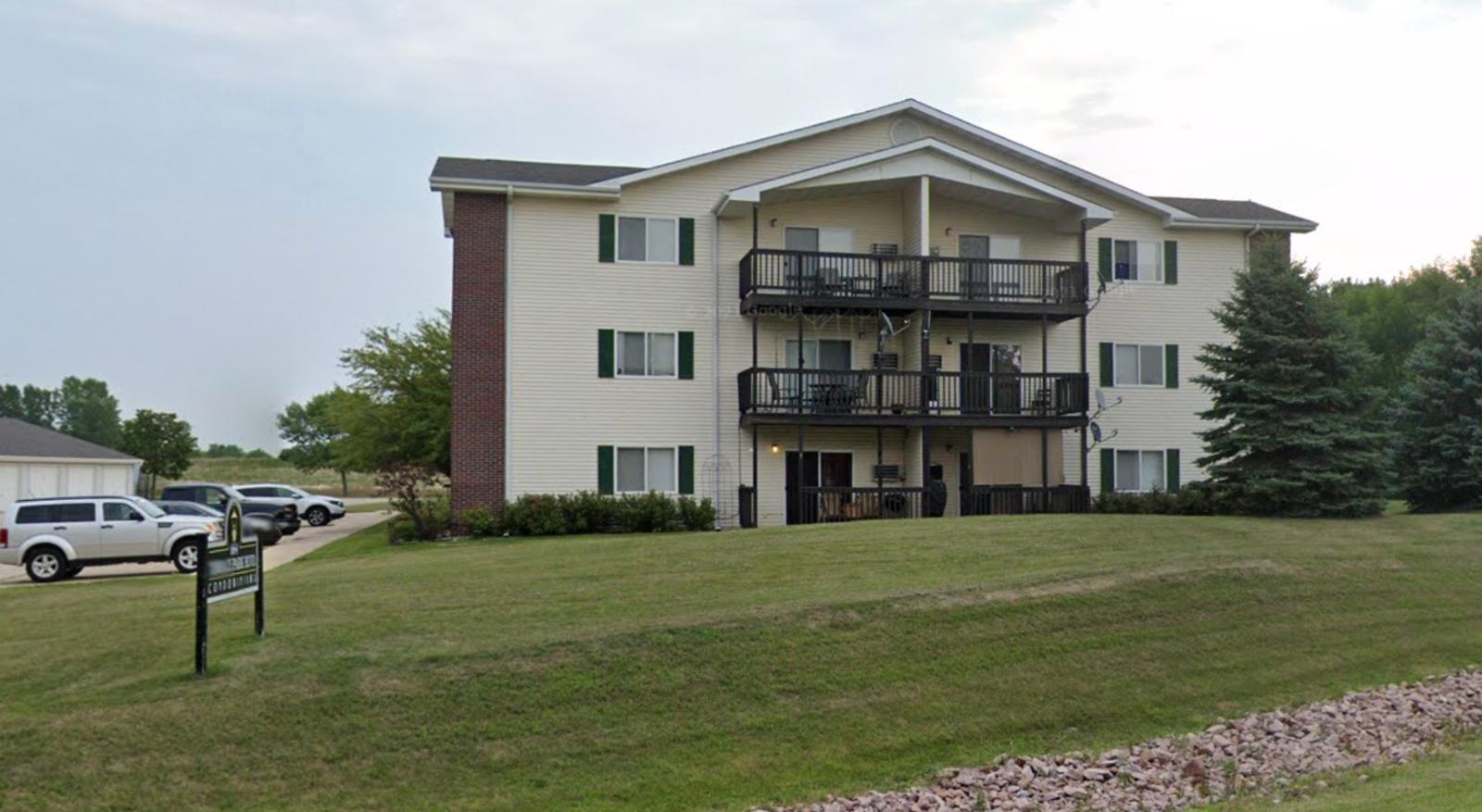
Why are people willing to pay so much to live here? What’s special about it?
West Okoboji commands Iowa’s highest home values as the state’s most prestigious lakefront community, offering exclusive access to one of Iowa’s clearest and most beautiful natural lakes. The community features luxury lakefront estates, custom architecture, and resort-quality amenities that create an unparalleled lifestyle experience. Properties offer direct lake access, private docks, and panoramic water views that justify premium pricing among the state’s most affluent demographics.
The area’s blue water lake, recreational facilities, and exclusive character attract successful professionals, business executives, and retirees seeking Iowa’s premier lifestyle destination. High-end restaurants, recreational services, and luxury amenities create a resort economy that supports year-round living while maintaining seasonal recreational appeal. The combination of natural beauty, exclusivity, and luxury amenities makes West Okoboji the ultimate address for those seeking Iowa’s finest lakefront living.
How West Okoboji Rose to Prominence
West Okoboji developed around one of Iowa’s most pristine natural lakes, formed by glacial activity during the last ice age that created the Iowa Great Lakes region. The area attracted Native American tribes for seasonal hunting and fishing before European settlement began in the 1850s. Early development focused on the lake’s recreational potential, with resorts and vacation cottages serving visitors drawn to the clear blue water and natural beauty.
The evolution to Iowa’s most exclusive community accelerated through the 20th century as improved transportation made the lakes accessible to affluent families from across the Midwest. The development of luxury homes, upscale amenities, and recreational infrastructure created a premium market that attracts the state’s wealthiest residents and out-of-state buyers. West Okoboji’s emergence as Iowa’s premier address represents the successful transformation of natural beauty into luxury real estate that rivals destinations in neighboring states.
3 Interesting Tidbits
- Blue Water Rarity – West Okoboji is one of only three natural blue water lakes in Iowa, created by glacial activity and maintained by natural springs that support exceptional water clarity and depth.
- Luxury Market Leader – The community regularly features million-dollar lakefront estates and custom homes that represent the pinnacle of Iowa luxury real estate development.
- Resort Destination Legacy – Historic mansions and estates dating to the early 1900s maintain West Okoboji’s tradition as the Midwest’s premier lake destination, attracting generations of affluent families to Iowa’s most exclusive address.



